Assistive Technologies for Diverse Learners
VerifiedAdded on 2020/04/21
|61
|13933
|87
AI Summary
This assignment delves into the realm of assistive technologies designed to support students with diverse learning needs. It examines various tools and strategies employed to address challenges faced by learners with conditions like dyslexia and autism. The focus is on understanding how these technologies can enhance educational experiences and empower students to reach their full potential.
Contribute Materials
Your contribution can guide someone’s learning journey. Share your
documents today.
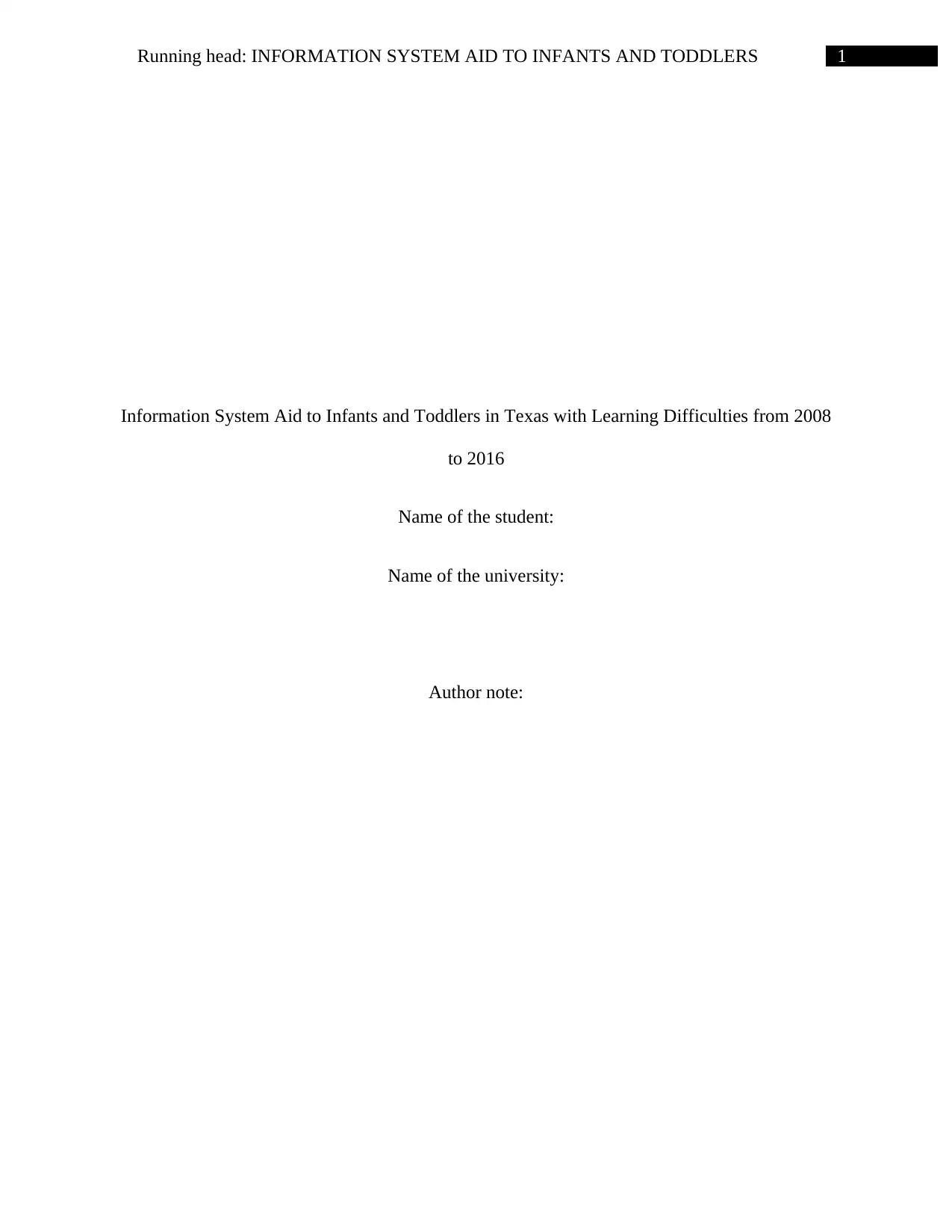
1Running head: INFORMATION SYSTEM AID TO INFANTS AND TODDLERS
Information System Aid to Infants and Toddlers in Texas with Learning Difficulties from 2008
to 2016
Name of the student:
Name of the university:
Author note:
Information System Aid to Infants and Toddlers in Texas with Learning Difficulties from 2008
to 2016
Name of the student:
Name of the university:
Author note:
Secure Best Marks with AI Grader
Need help grading? Try our AI Grader for instant feedback on your assignments.
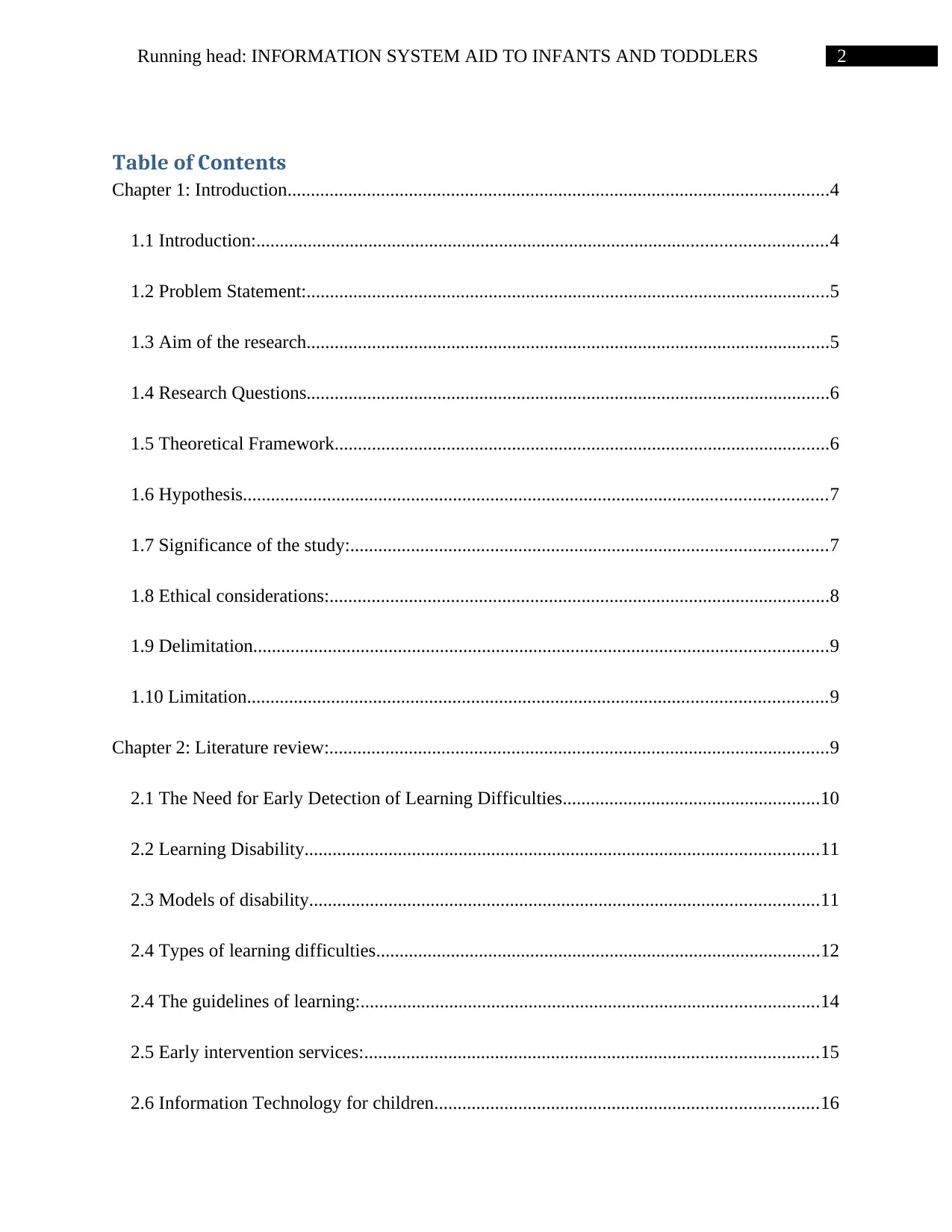
2Running head: INFORMATION SYSTEM AID TO INFANTS AND TODDLERS
Table of Contents
Chapter 1: Introduction....................................................................................................................4
1.1 Introduction:..........................................................................................................................4
1.2 Problem Statement:................................................................................................................5
1.3 Aim of the research................................................................................................................5
1.4 Research Questions................................................................................................................6
1.5 Theoretical Framework..........................................................................................................6
1.6 Hypothesis.............................................................................................................................7
1.7 Significance of the study:......................................................................................................7
1.8 Ethical considerations:...........................................................................................................8
1.9 Delimitation...........................................................................................................................9
1.10 Limitation............................................................................................................................9
Chapter 2: Literature review:...........................................................................................................9
2.1 The Need for Early Detection of Learning Difficulties.......................................................10
2.2 Learning Disability..............................................................................................................11
2.3 Models of disability.............................................................................................................11
2.4 Types of learning difficulties...............................................................................................12
2.4 The guidelines of learning:..................................................................................................14
2.5 Early intervention services:.................................................................................................15
2.6 Information Technology for children..................................................................................16
Table of Contents
Chapter 1: Introduction....................................................................................................................4
1.1 Introduction:..........................................................................................................................4
1.2 Problem Statement:................................................................................................................5
1.3 Aim of the research................................................................................................................5
1.4 Research Questions................................................................................................................6
1.5 Theoretical Framework..........................................................................................................6
1.6 Hypothesis.............................................................................................................................7
1.7 Significance of the study:......................................................................................................7
1.8 Ethical considerations:...........................................................................................................8
1.9 Delimitation...........................................................................................................................9
1.10 Limitation............................................................................................................................9
Chapter 2: Literature review:...........................................................................................................9
2.1 The Need for Early Detection of Learning Difficulties.......................................................10
2.2 Learning Disability..............................................................................................................11
2.3 Models of disability.............................................................................................................11
2.4 Types of learning difficulties...............................................................................................12
2.4 The guidelines of learning:..................................................................................................14
2.5 Early intervention services:.................................................................................................15
2.6 Information Technology for children..................................................................................16
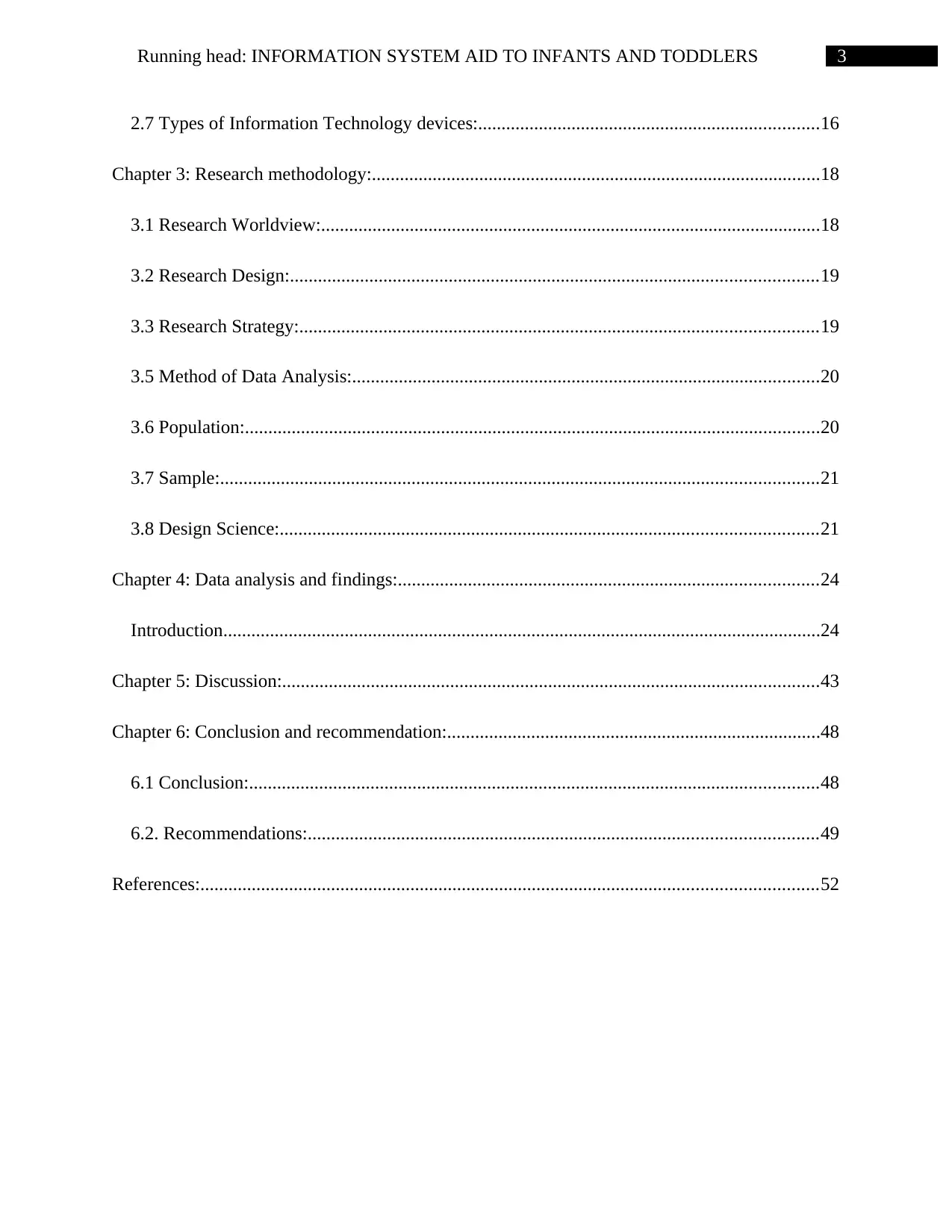
3Running head: INFORMATION SYSTEM AID TO INFANTS AND TODDLERS
2.7 Types of Information Technology devices:.........................................................................16
Chapter 3: Research methodology:................................................................................................18
3.1 Research Worldview:...........................................................................................................18
3.2 Research Design:.................................................................................................................19
3.3 Research Strategy:...............................................................................................................19
3.5 Method of Data Analysis:....................................................................................................20
3.6 Population:...........................................................................................................................20
3.7 Sample:................................................................................................................................21
3.8 Design Science:...................................................................................................................21
Chapter 4: Data analysis and findings:..........................................................................................24
Introduction................................................................................................................................24
Chapter 5: Discussion:...................................................................................................................43
Chapter 6: Conclusion and recommendation:................................................................................48
6.1 Conclusion:..........................................................................................................................48
6.2. Recommendations:.............................................................................................................49
References:....................................................................................................................................52
2.7 Types of Information Technology devices:.........................................................................16
Chapter 3: Research methodology:................................................................................................18
3.1 Research Worldview:...........................................................................................................18
3.2 Research Design:.................................................................................................................19
3.3 Research Strategy:...............................................................................................................19
3.5 Method of Data Analysis:....................................................................................................20
3.6 Population:...........................................................................................................................20
3.7 Sample:................................................................................................................................21
3.8 Design Science:...................................................................................................................21
Chapter 4: Data analysis and findings:..........................................................................................24
Introduction................................................................................................................................24
Chapter 5: Discussion:...................................................................................................................43
Chapter 6: Conclusion and recommendation:................................................................................48
6.1 Conclusion:..........................................................................................................................48
6.2. Recommendations:.............................................................................................................49
References:....................................................................................................................................52
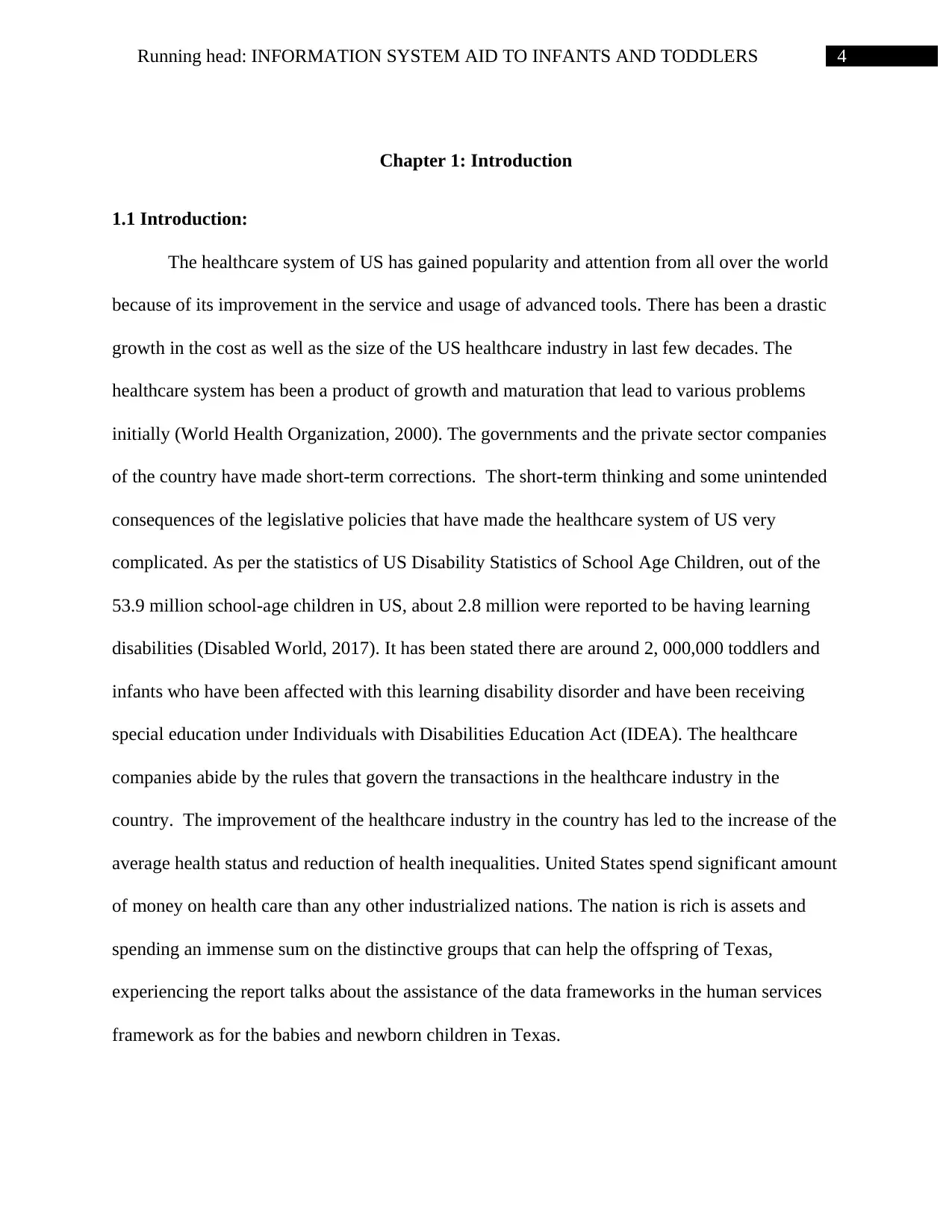
4Running head: INFORMATION SYSTEM AID TO INFANTS AND TODDLERS
Chapter 1: Introduction
1.1 Introduction:
The healthcare system of US has gained popularity and attention from all over the world
because of its improvement in the service and usage of advanced tools. There has been a drastic
growth in the cost as well as the size of the US healthcare industry in last few decades. The
healthcare system has been a product of growth and maturation that lead to various problems
initially (World Health Organization, 2000). The governments and the private sector companies
of the country have made short-term corrections. The short-term thinking and some unintended
consequences of the legislative policies that have made the healthcare system of US very
complicated. As per the statistics of US Disability Statistics of School Age Children, out of the
53.9 million school-age children in US, about 2.8 million were reported to be having learning
disabilities (Disabled World, 2017). It has been stated there are around 2, 000,000 toddlers and
infants who have been affected with this learning disability disorder and have been receiving
special education under Individuals with Disabilities Education Act (IDEA). The healthcare
companies abide by the rules that govern the transactions in the healthcare industry in the
country. The improvement of the healthcare industry in the country has led to the increase of the
average health status and reduction of health inequalities. United States spend significant amount
of money on health care than any other industrialized nations. The nation is rich is assets and
spending an immense sum on the distinctive groups that can help the offspring of Texas,
experiencing the report talks about the assistance of the data frameworks in the human services
framework as for the babies and newborn children in Texas.
Chapter 1: Introduction
1.1 Introduction:
The healthcare system of US has gained popularity and attention from all over the world
because of its improvement in the service and usage of advanced tools. There has been a drastic
growth in the cost as well as the size of the US healthcare industry in last few decades. The
healthcare system has been a product of growth and maturation that lead to various problems
initially (World Health Organization, 2000). The governments and the private sector companies
of the country have made short-term corrections. The short-term thinking and some unintended
consequences of the legislative policies that have made the healthcare system of US very
complicated. As per the statistics of US Disability Statistics of School Age Children, out of the
53.9 million school-age children in US, about 2.8 million were reported to be having learning
disabilities (Disabled World, 2017). It has been stated there are around 2, 000,000 toddlers and
infants who have been affected with this learning disability disorder and have been receiving
special education under Individuals with Disabilities Education Act (IDEA). The healthcare
companies abide by the rules that govern the transactions in the healthcare industry in the
country. The improvement of the healthcare industry in the country has led to the increase of the
average health status and reduction of health inequalities. United States spend significant amount
of money on health care than any other industrialized nations. The nation is rich is assets and
spending an immense sum on the distinctive groups that can help the offspring of Texas,
experiencing the report talks about the assistance of the data frameworks in the human services
framework as for the babies and newborn children in Texas.
Secure Best Marks with AI Grader
Need help grading? Try our AI Grader for instant feedback on your assignments.
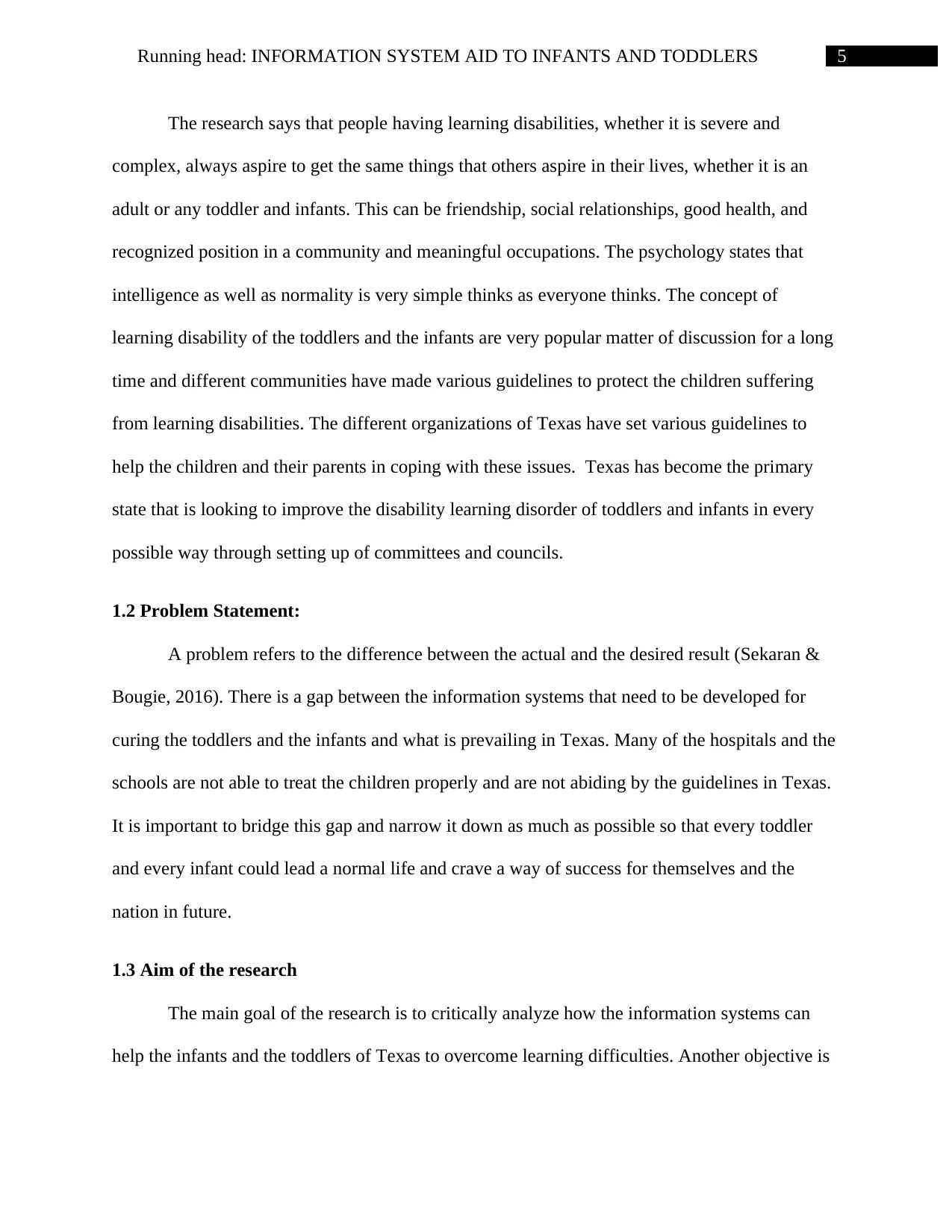
5Running head: INFORMATION SYSTEM AID TO INFANTS AND TODDLERS
The research says that people having learning disabilities, whether it is severe and
complex, always aspire to get the same things that others aspire in their lives, whether it is an
adult or any toddler and infants. This can be friendship, social relationships, good health, and
recognized position in a community and meaningful occupations. The psychology states that
intelligence as well as normality is very simple thinks as everyone thinks. The concept of
learning disability of the toddlers and the infants are very popular matter of discussion for a long
time and different communities have made various guidelines to protect the children suffering
from learning disabilities. The different organizations of Texas have set various guidelines to
help the children and their parents in coping with these issues. Texas has become the primary
state that is looking to improve the disability learning disorder of toddlers and infants in every
possible way through setting up of committees and councils.
1.2 Problem Statement:
A problem refers to the difference between the actual and the desired result (Sekaran &
Bougie, 2016). There is a gap between the information systems that need to be developed for
curing the toddlers and the infants and what is prevailing in Texas. Many of the hospitals and the
schools are not able to treat the children properly and are not abiding by the guidelines in Texas.
It is important to bridge this gap and narrow it down as much as possible so that every toddler
and every infant could lead a normal life and crave a way of success for themselves and the
nation in future.
1.3 Aim of the research
The main goal of the research is to critically analyze how the information systems can
help the infants and the toddlers of Texas to overcome learning difficulties. Another objective is
The research says that people having learning disabilities, whether it is severe and
complex, always aspire to get the same things that others aspire in their lives, whether it is an
adult or any toddler and infants. This can be friendship, social relationships, good health, and
recognized position in a community and meaningful occupations. The psychology states that
intelligence as well as normality is very simple thinks as everyone thinks. The concept of
learning disability of the toddlers and the infants are very popular matter of discussion for a long
time and different communities have made various guidelines to protect the children suffering
from learning disabilities. The different organizations of Texas have set various guidelines to
help the children and their parents in coping with these issues. Texas has become the primary
state that is looking to improve the disability learning disorder of toddlers and infants in every
possible way through setting up of committees and councils.
1.2 Problem Statement:
A problem refers to the difference between the actual and the desired result (Sekaran &
Bougie, 2016). There is a gap between the information systems that need to be developed for
curing the toddlers and the infants and what is prevailing in Texas. Many of the hospitals and the
schools are not able to treat the children properly and are not abiding by the guidelines in Texas.
It is important to bridge this gap and narrow it down as much as possible so that every toddler
and every infant could lead a normal life and crave a way of success for themselves and the
nation in future.
1.3 Aim of the research
The main goal of the research is to critically analyze how the information systems can
help the infants and the toddlers of Texas to overcome learning difficulties. Another objective is
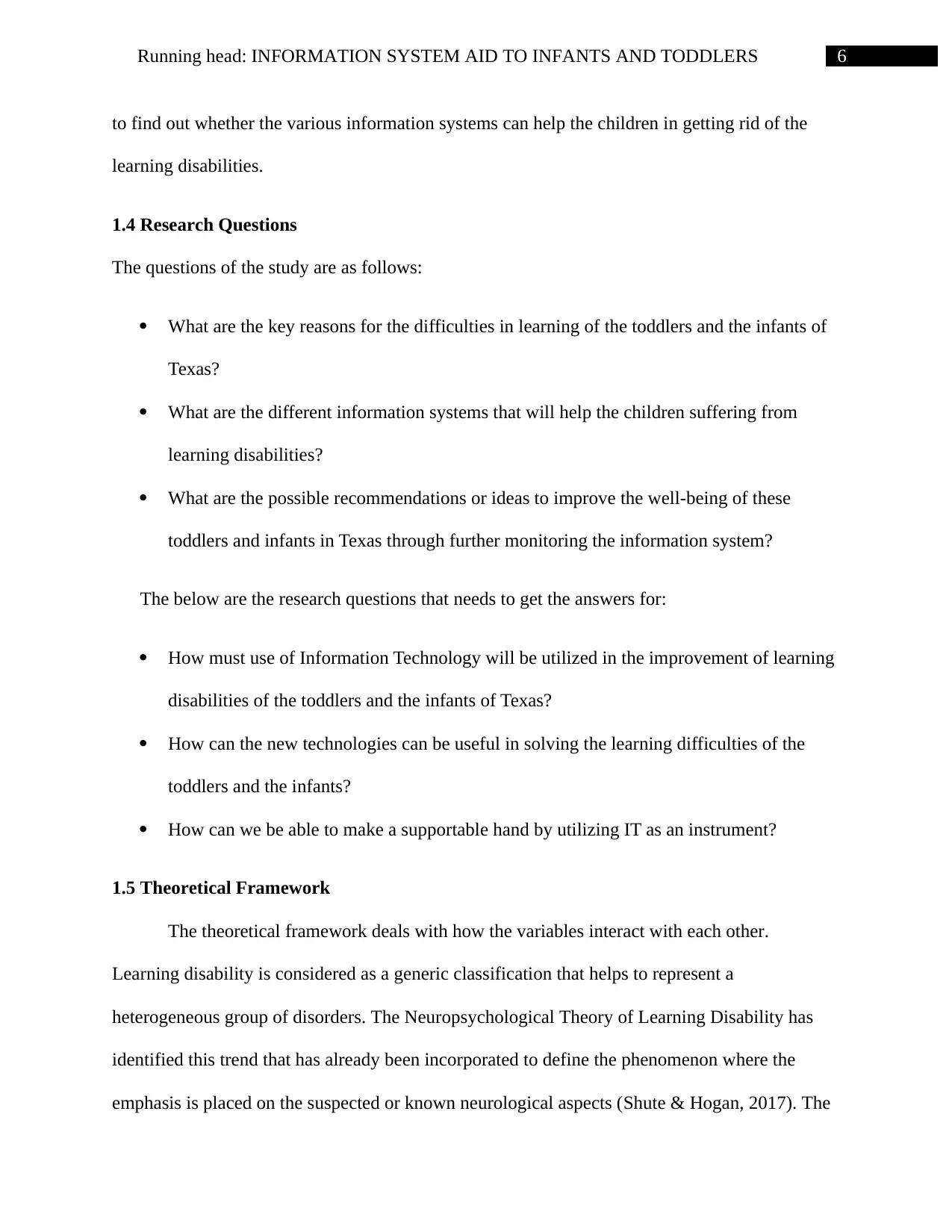
6Running head: INFORMATION SYSTEM AID TO INFANTS AND TODDLERS
to find out whether the various information systems can help the children in getting rid of the
learning disabilities.
1.4 Research Questions
The questions of the study are as follows:
What are the key reasons for the difficulties in learning of the toddlers and the infants of
Texas?
What are the different information systems that will help the children suffering from
learning disabilities?
What are the possible recommendations or ideas to improve the well-being of these
toddlers and infants in Texas through further monitoring the information system?
The below are the research questions that needs to get the answers for:
How must use of Information Technology will be utilized in the improvement of learning
disabilities of the toddlers and the infants of Texas?
How can the new technologies can be useful in solving the learning difficulties of the
toddlers and the infants?
How can we be able to make a supportable hand by utilizing IT as an instrument?
1.5 Theoretical Framework
The theoretical framework deals with how the variables interact with each other.
Learning disability is considered as a generic classification that helps to represent a
heterogeneous group of disorders. The Neuropsychological Theory of Learning Disability has
identified this trend that has already been incorporated to define the phenomenon where the
emphasis is placed on the suspected or known neurological aspects (Shute & Hogan, 2017). The
to find out whether the various information systems can help the children in getting rid of the
learning disabilities.
1.4 Research Questions
The questions of the study are as follows:
What are the key reasons for the difficulties in learning of the toddlers and the infants of
Texas?
What are the different information systems that will help the children suffering from
learning disabilities?
What are the possible recommendations or ideas to improve the well-being of these
toddlers and infants in Texas through further monitoring the information system?
The below are the research questions that needs to get the answers for:
How must use of Information Technology will be utilized in the improvement of learning
disabilities of the toddlers and the infants of Texas?
How can the new technologies can be useful in solving the learning difficulties of the
toddlers and the infants?
How can we be able to make a supportable hand by utilizing IT as an instrument?
1.5 Theoretical Framework
The theoretical framework deals with how the variables interact with each other.
Learning disability is considered as a generic classification that helps to represent a
heterogeneous group of disorders. The Neuropsychological Theory of Learning Disability has
identified this trend that has already been incorporated to define the phenomenon where the
emphasis is placed on the suspected or known neurological aspects (Shute & Hogan, 2017). The
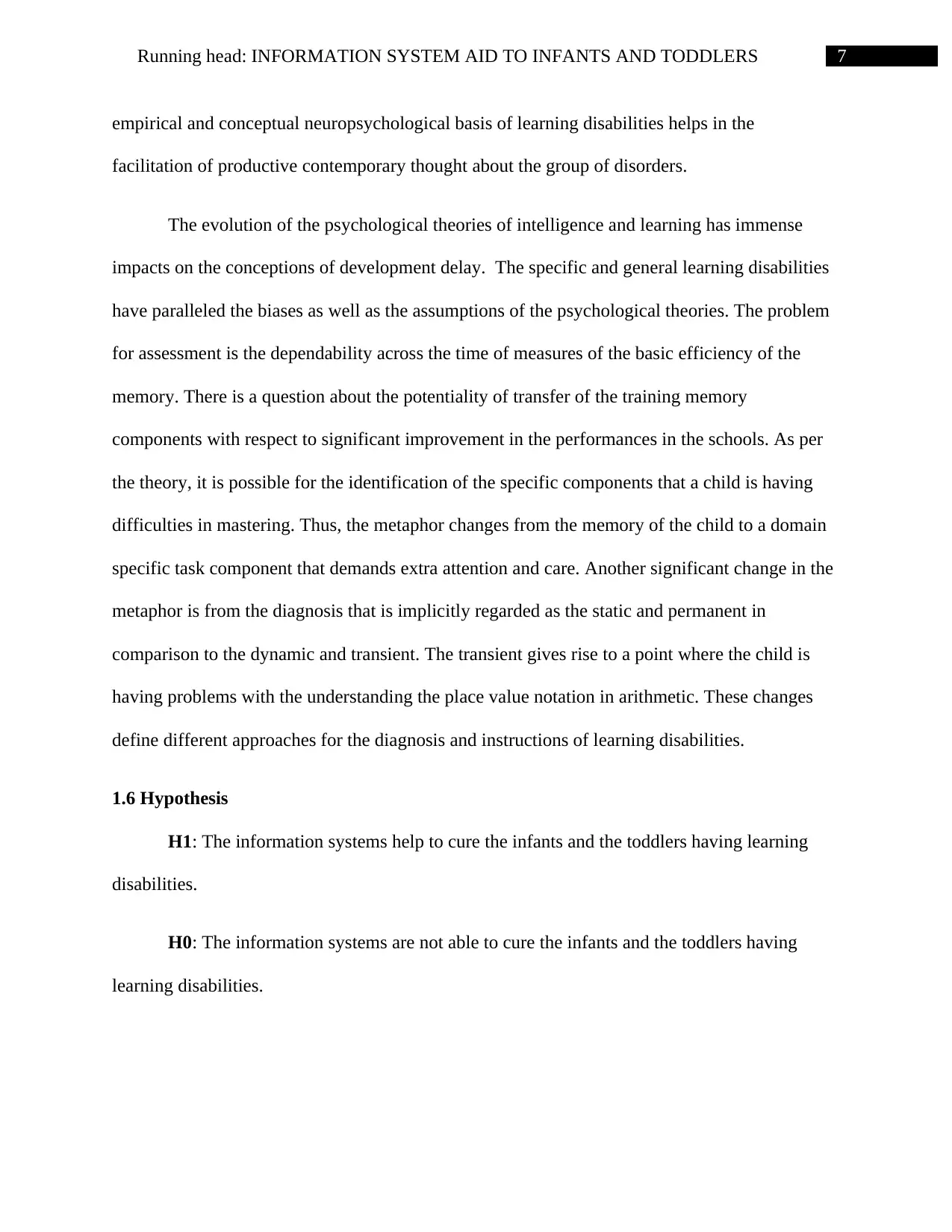
7Running head: INFORMATION SYSTEM AID TO INFANTS AND TODDLERS
empirical and conceptual neuropsychological basis of learning disabilities helps in the
facilitation of productive contemporary thought about the group of disorders.
The evolution of the psychological theories of intelligence and learning has immense
impacts on the conceptions of development delay. The specific and general learning disabilities
have paralleled the biases as well as the assumptions of the psychological theories. The problem
for assessment is the dependability across the time of measures of the basic efficiency of the
memory. There is a question about the potentiality of transfer of the training memory
components with respect to significant improvement in the performances in the schools. As per
the theory, it is possible for the identification of the specific components that a child is having
difficulties in mastering. Thus, the metaphor changes from the memory of the child to a domain
specific task component that demands extra attention and care. Another significant change in the
metaphor is from the diagnosis that is implicitly regarded as the static and permanent in
comparison to the dynamic and transient. The transient gives rise to a point where the child is
having problems with the understanding the place value notation in arithmetic. These changes
define different approaches for the diagnosis and instructions of learning disabilities.
1.6 Hypothesis
H1: The information systems help to cure the infants and the toddlers having learning
disabilities.
H0: The information systems are not able to cure the infants and the toddlers having
learning disabilities.
empirical and conceptual neuropsychological basis of learning disabilities helps in the
facilitation of productive contemporary thought about the group of disorders.
The evolution of the psychological theories of intelligence and learning has immense
impacts on the conceptions of development delay. The specific and general learning disabilities
have paralleled the biases as well as the assumptions of the psychological theories. The problem
for assessment is the dependability across the time of measures of the basic efficiency of the
memory. There is a question about the potentiality of transfer of the training memory
components with respect to significant improvement in the performances in the schools. As per
the theory, it is possible for the identification of the specific components that a child is having
difficulties in mastering. Thus, the metaphor changes from the memory of the child to a domain
specific task component that demands extra attention and care. Another significant change in the
metaphor is from the diagnosis that is implicitly regarded as the static and permanent in
comparison to the dynamic and transient. The transient gives rise to a point where the child is
having problems with the understanding the place value notation in arithmetic. These changes
define different approaches for the diagnosis and instructions of learning disabilities.
1.6 Hypothesis
H1: The information systems help to cure the infants and the toddlers having learning
disabilities.
H0: The information systems are not able to cure the infants and the toddlers having
learning disabilities.
Paraphrase This Document
Need a fresh take? Get an instant paraphrase of this document with our AI Paraphraser
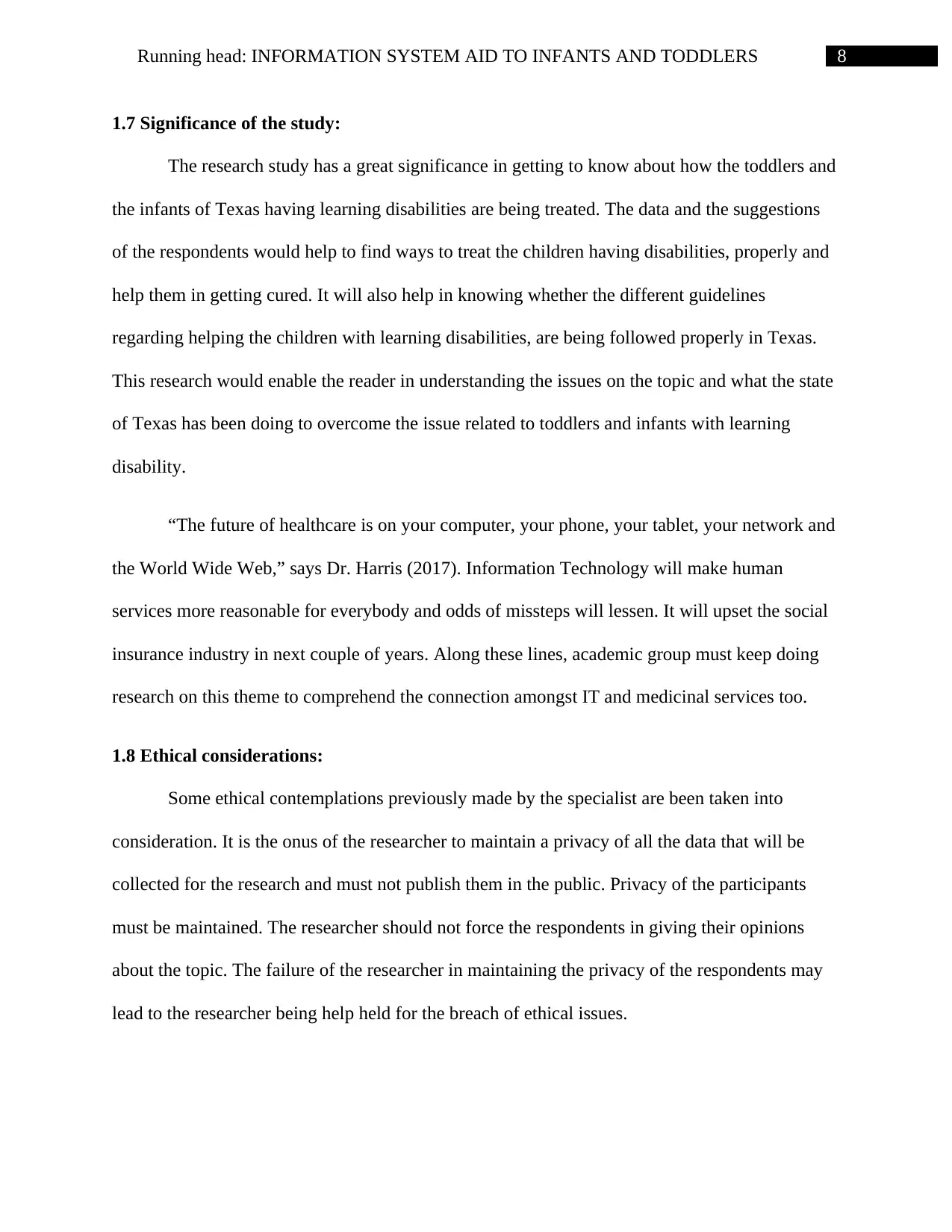
8Running head: INFORMATION SYSTEM AID TO INFANTS AND TODDLERS
1.7 Significance of the study:
The research study has a great significance in getting to know about how the toddlers and
the infants of Texas having learning disabilities are being treated. The data and the suggestions
of the respondents would help to find ways to treat the children having disabilities, properly and
help them in getting cured. It will also help in knowing whether the different guidelines
regarding helping the children with learning disabilities, are being followed properly in Texas.
This research would enable the reader in understanding the issues on the topic and what the state
of Texas has been doing to overcome the issue related to toddlers and infants with learning
disability.
“The future of healthcare is on your computer, your phone, your tablet, your network and
the World Wide Web,” says Dr. Harris (2017). Information Technology will make human
services more reasonable for everybody and odds of missteps will lessen. It will upset the social
insurance industry in next couple of years. Along these lines, academic group must keep doing
research on this theme to comprehend the connection amongst IT and medicinal services too.
1.8 Ethical considerations:
Some ethical contemplations previously made by the specialist are been taken into
consideration. It is the onus of the researcher to maintain a privacy of all the data that will be
collected for the research and must not publish them in the public. Privacy of the participants
must be maintained. The researcher should not force the respondents in giving their opinions
about the topic. The failure of the researcher in maintaining the privacy of the respondents may
lead to the researcher being help held for the breach of ethical issues.
1.7 Significance of the study:
The research study has a great significance in getting to know about how the toddlers and
the infants of Texas having learning disabilities are being treated. The data and the suggestions
of the respondents would help to find ways to treat the children having disabilities, properly and
help them in getting cured. It will also help in knowing whether the different guidelines
regarding helping the children with learning disabilities, are being followed properly in Texas.
This research would enable the reader in understanding the issues on the topic and what the state
of Texas has been doing to overcome the issue related to toddlers and infants with learning
disability.
“The future of healthcare is on your computer, your phone, your tablet, your network and
the World Wide Web,” says Dr. Harris (2017). Information Technology will make human
services more reasonable for everybody and odds of missteps will lessen. It will upset the social
insurance industry in next couple of years. Along these lines, academic group must keep doing
research on this theme to comprehend the connection amongst IT and medicinal services too.
1.8 Ethical considerations:
Some ethical contemplations previously made by the specialist are been taken into
consideration. It is the onus of the researcher to maintain a privacy of all the data that will be
collected for the research and must not publish them in the public. Privacy of the participants
must be maintained. The researcher should not force the respondents in giving their opinions
about the topic. The failure of the researcher in maintaining the privacy of the respondents may
lead to the researcher being help held for the breach of ethical issues.
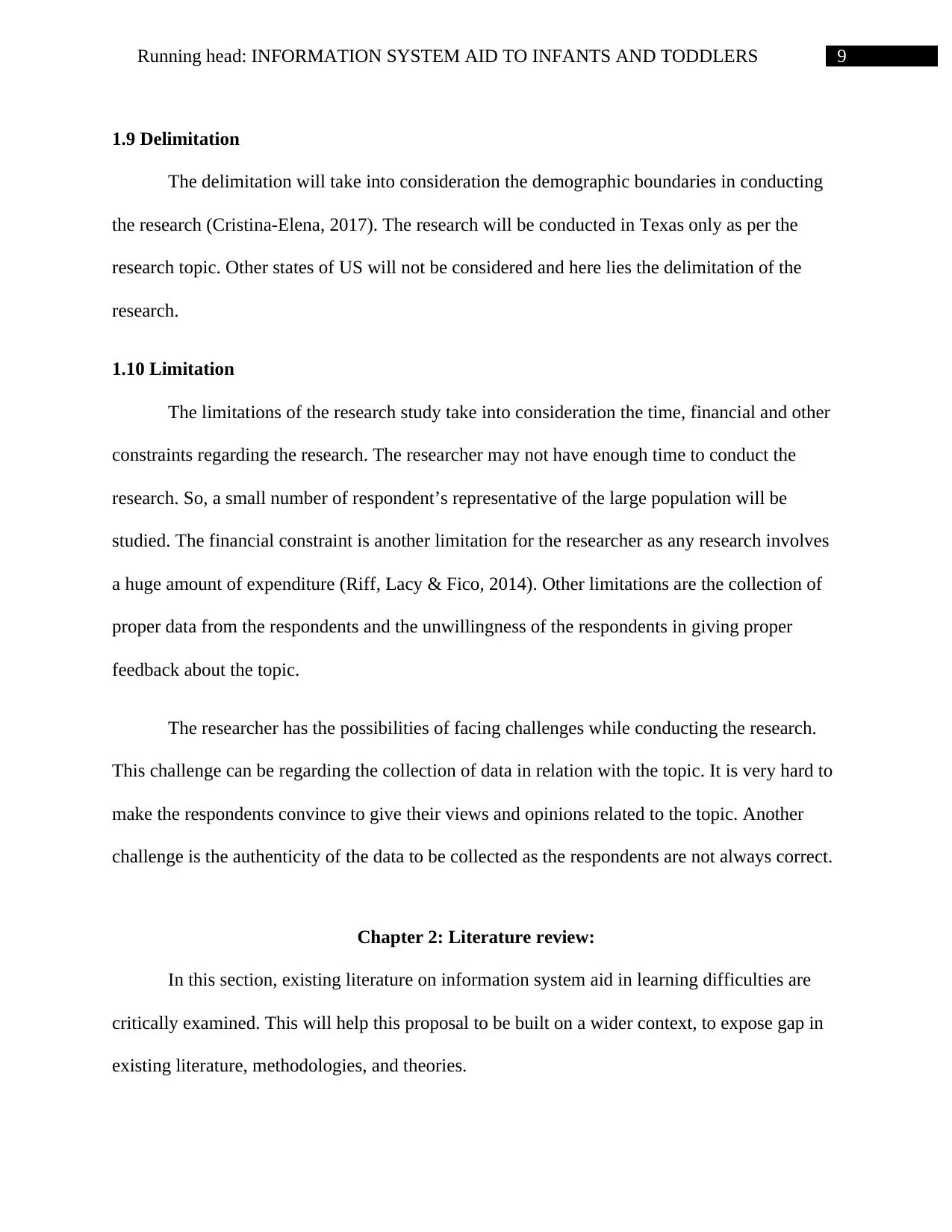
9Running head: INFORMATION SYSTEM AID TO INFANTS AND TODDLERS
1.9 Delimitation
The delimitation will take into consideration the demographic boundaries in conducting
the research (Cristina-Elena, 2017). The research will be conducted in Texas only as per the
research topic. Other states of US will not be considered and here lies the delimitation of the
research.
1.10 Limitation
The limitations of the research study take into consideration the time, financial and other
constraints regarding the research. The researcher may not have enough time to conduct the
research. So, a small number of respondent’s representative of the large population will be
studied. The financial constraint is another limitation for the researcher as any research involves
a huge amount of expenditure (Riff, Lacy & Fico, 2014). Other limitations are the collection of
proper data from the respondents and the unwillingness of the respondents in giving proper
feedback about the topic.
The researcher has the possibilities of facing challenges while conducting the research.
This challenge can be regarding the collection of data in relation with the topic. It is very hard to
make the respondents convince to give their views and opinions related to the topic. Another
challenge is the authenticity of the data to be collected as the respondents are not always correct.
Chapter 2: Literature review:
In this section, existing literature on information system aid in learning difficulties are
critically examined. This will help this proposal to be built on a wider context, to expose gap in
existing literature, methodologies, and theories.
1.9 Delimitation
The delimitation will take into consideration the demographic boundaries in conducting
the research (Cristina-Elena, 2017). The research will be conducted in Texas only as per the
research topic. Other states of US will not be considered and here lies the delimitation of the
research.
1.10 Limitation
The limitations of the research study take into consideration the time, financial and other
constraints regarding the research. The researcher may not have enough time to conduct the
research. So, a small number of respondent’s representative of the large population will be
studied. The financial constraint is another limitation for the researcher as any research involves
a huge amount of expenditure (Riff, Lacy & Fico, 2014). Other limitations are the collection of
proper data from the respondents and the unwillingness of the respondents in giving proper
feedback about the topic.
The researcher has the possibilities of facing challenges while conducting the research.
This challenge can be regarding the collection of data in relation with the topic. It is very hard to
make the respondents convince to give their views and opinions related to the topic. Another
challenge is the authenticity of the data to be collected as the respondents are not always correct.
Chapter 2: Literature review:
In this section, existing literature on information system aid in learning difficulties are
critically examined. This will help this proposal to be built on a wider context, to expose gap in
existing literature, methodologies, and theories.
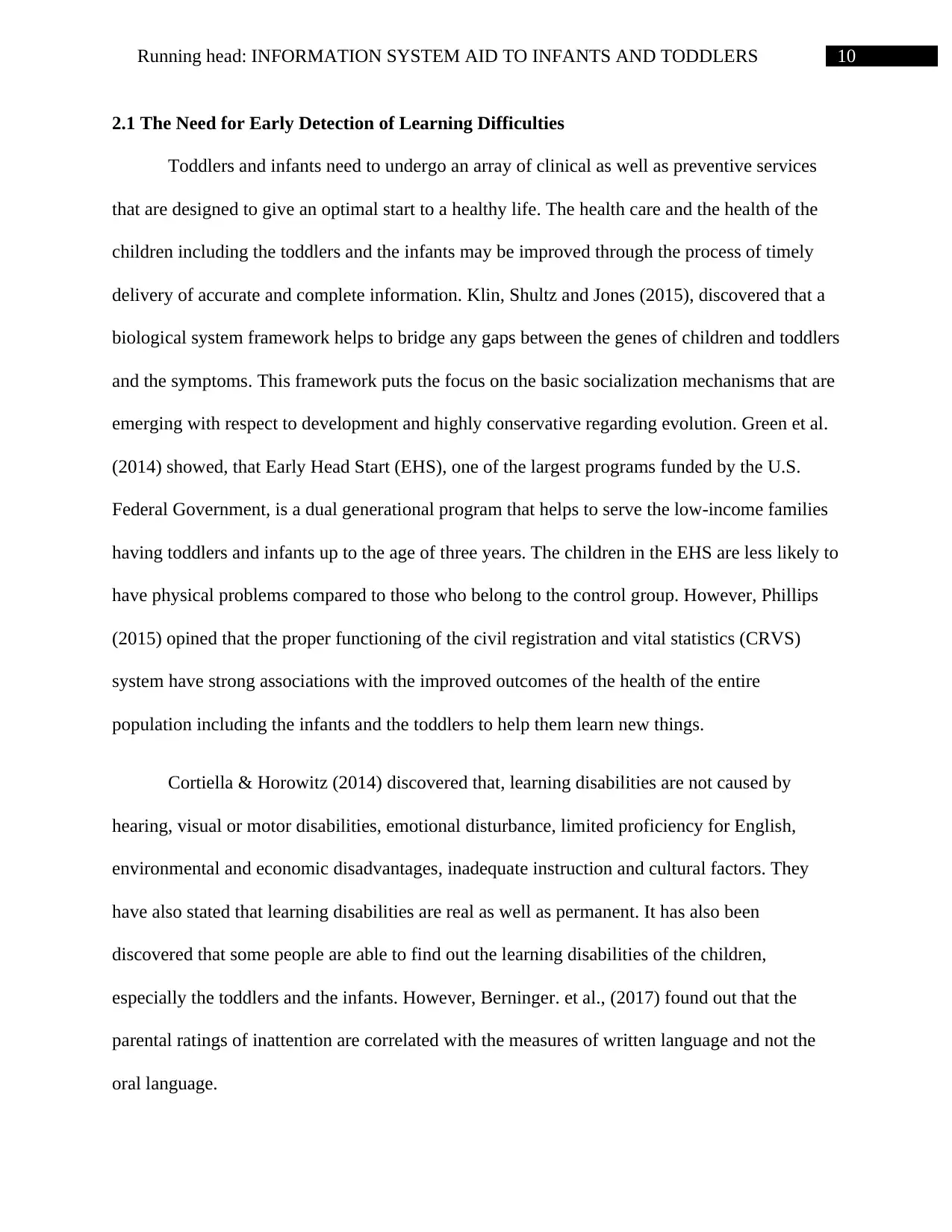
10Running head: INFORMATION SYSTEM AID TO INFANTS AND TODDLERS
2.1 The Need for Early Detection of Learning Difficulties
Toddlers and infants need to undergo an array of clinical as well as preventive services
that are designed to give an optimal start to a healthy life. The health care and the health of the
children including the toddlers and the infants may be improved through the process of timely
delivery of accurate and complete information. Klin, Shultz and Jones (2015), discovered that a
biological system framework helps to bridge any gaps between the genes of children and toddlers
and the symptoms. This framework puts the focus on the basic socialization mechanisms that are
emerging with respect to development and highly conservative regarding evolution. Green et al.
(2014) showed, that Early Head Start (EHS), one of the largest programs funded by the U.S.
Federal Government, is a dual generational program that helps to serve the low-income families
having toddlers and infants up to the age of three years. The children in the EHS are less likely to
have physical problems compared to those who belong to the control group. However, Phillips
(2015) opined that the proper functioning of the civil registration and vital statistics (CRVS)
system have strong associations with the improved outcomes of the health of the entire
population including the infants and the toddlers to help them learn new things.
Cortiella & Horowitz (2014) discovered that, learning disabilities are not caused by
hearing, visual or motor disabilities, emotional disturbance, limited proficiency for English,
environmental and economic disadvantages, inadequate instruction and cultural factors. They
have also stated that learning disabilities are real as well as permanent. It has also been
discovered that some people are able to find out the learning disabilities of the children,
especially the toddlers and the infants. However, Berninger. et al., (2017) found out that the
parental ratings of inattention are correlated with the measures of written language and not the
oral language.
2.1 The Need for Early Detection of Learning Difficulties
Toddlers and infants need to undergo an array of clinical as well as preventive services
that are designed to give an optimal start to a healthy life. The health care and the health of the
children including the toddlers and the infants may be improved through the process of timely
delivery of accurate and complete information. Klin, Shultz and Jones (2015), discovered that a
biological system framework helps to bridge any gaps between the genes of children and toddlers
and the symptoms. This framework puts the focus on the basic socialization mechanisms that are
emerging with respect to development and highly conservative regarding evolution. Green et al.
(2014) showed, that Early Head Start (EHS), one of the largest programs funded by the U.S.
Federal Government, is a dual generational program that helps to serve the low-income families
having toddlers and infants up to the age of three years. The children in the EHS are less likely to
have physical problems compared to those who belong to the control group. However, Phillips
(2015) opined that the proper functioning of the civil registration and vital statistics (CRVS)
system have strong associations with the improved outcomes of the health of the entire
population including the infants and the toddlers to help them learn new things.
Cortiella & Horowitz (2014) discovered that, learning disabilities are not caused by
hearing, visual or motor disabilities, emotional disturbance, limited proficiency for English,
environmental and economic disadvantages, inadequate instruction and cultural factors. They
have also stated that learning disabilities are real as well as permanent. It has also been
discovered that some people are able to find out the learning disabilities of the children,
especially the toddlers and the infants. However, Berninger. et al., (2017) found out that the
parental ratings of inattention are correlated with the measures of written language and not the
oral language.
Secure Best Marks with AI Grader
Need help grading? Try our AI Grader for instant feedback on your assignments.
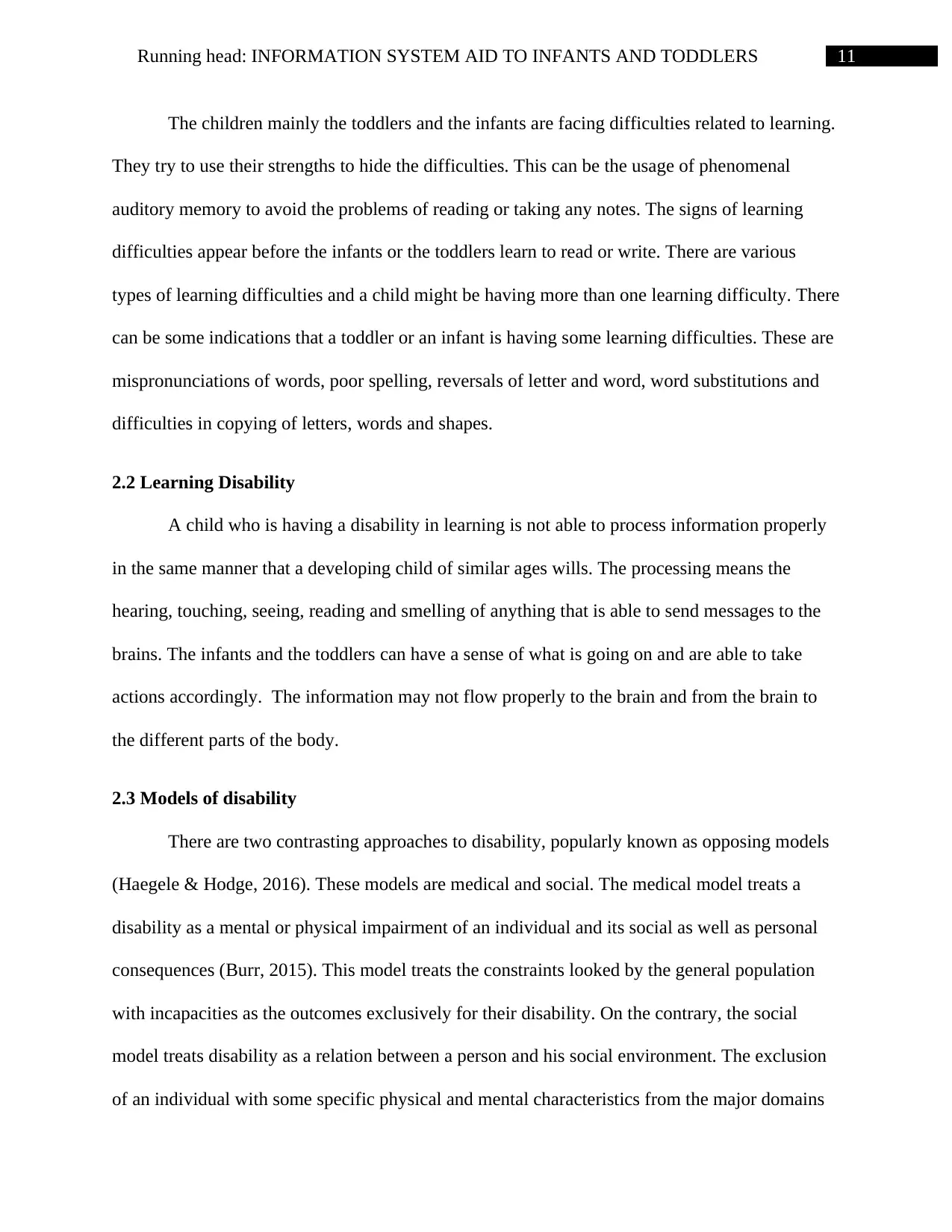
11Running head: INFORMATION SYSTEM AID TO INFANTS AND TODDLERS
The children mainly the toddlers and the infants are facing difficulties related to learning.
They try to use their strengths to hide the difficulties. This can be the usage of phenomenal
auditory memory to avoid the problems of reading or taking any notes. The signs of learning
difficulties appear before the infants or the toddlers learn to read or write. There are various
types of learning difficulties and a child might be having more than one learning difficulty. There
can be some indications that a toddler or an infant is having some learning difficulties. These are
mispronunciations of words, poor spelling, reversals of letter and word, word substitutions and
difficulties in copying of letters, words and shapes.
2.2 Learning Disability
A child who is having a disability in learning is not able to process information properly
in the same manner that a developing child of similar ages wills. The processing means the
hearing, touching, seeing, reading and smelling of anything that is able to send messages to the
brains. The infants and the toddlers can have a sense of what is going on and are able to take
actions accordingly. The information may not flow properly to the brain and from the brain to
the different parts of the body.
2.3 Models of disability
There are two contrasting approaches to disability, popularly known as opposing models
(Haegele & Hodge, 2016). These models are medical and social. The medical model treats a
disability as a mental or physical impairment of an individual and its social as well as personal
consequences (Burr, 2015). This model treats the constraints looked by the general population
with incapacities as the outcomes exclusively for their disability. On the contrary, the social
model treats disability as a relation between a person and his social environment. The exclusion
of an individual with some specific physical and mental characteristics from the major domains
The children mainly the toddlers and the infants are facing difficulties related to learning.
They try to use their strengths to hide the difficulties. This can be the usage of phenomenal
auditory memory to avoid the problems of reading or taking any notes. The signs of learning
difficulties appear before the infants or the toddlers learn to read or write. There are various
types of learning difficulties and a child might be having more than one learning difficulty. There
can be some indications that a toddler or an infant is having some learning difficulties. These are
mispronunciations of words, poor spelling, reversals of letter and word, word substitutions and
difficulties in copying of letters, words and shapes.
2.2 Learning Disability
A child who is having a disability in learning is not able to process information properly
in the same manner that a developing child of similar ages wills. The processing means the
hearing, touching, seeing, reading and smelling of anything that is able to send messages to the
brains. The infants and the toddlers can have a sense of what is going on and are able to take
actions accordingly. The information may not flow properly to the brain and from the brain to
the different parts of the body.
2.3 Models of disability
There are two contrasting approaches to disability, popularly known as opposing models
(Haegele & Hodge, 2016). These models are medical and social. The medical model treats a
disability as a mental or physical impairment of an individual and its social as well as personal
consequences (Burr, 2015). This model treats the constraints looked by the general population
with incapacities as the outcomes exclusively for their disability. On the contrary, the social
model treats disability as a relation between a person and his social environment. The exclusion
of an individual with some specific physical and mental characteristics from the major domains
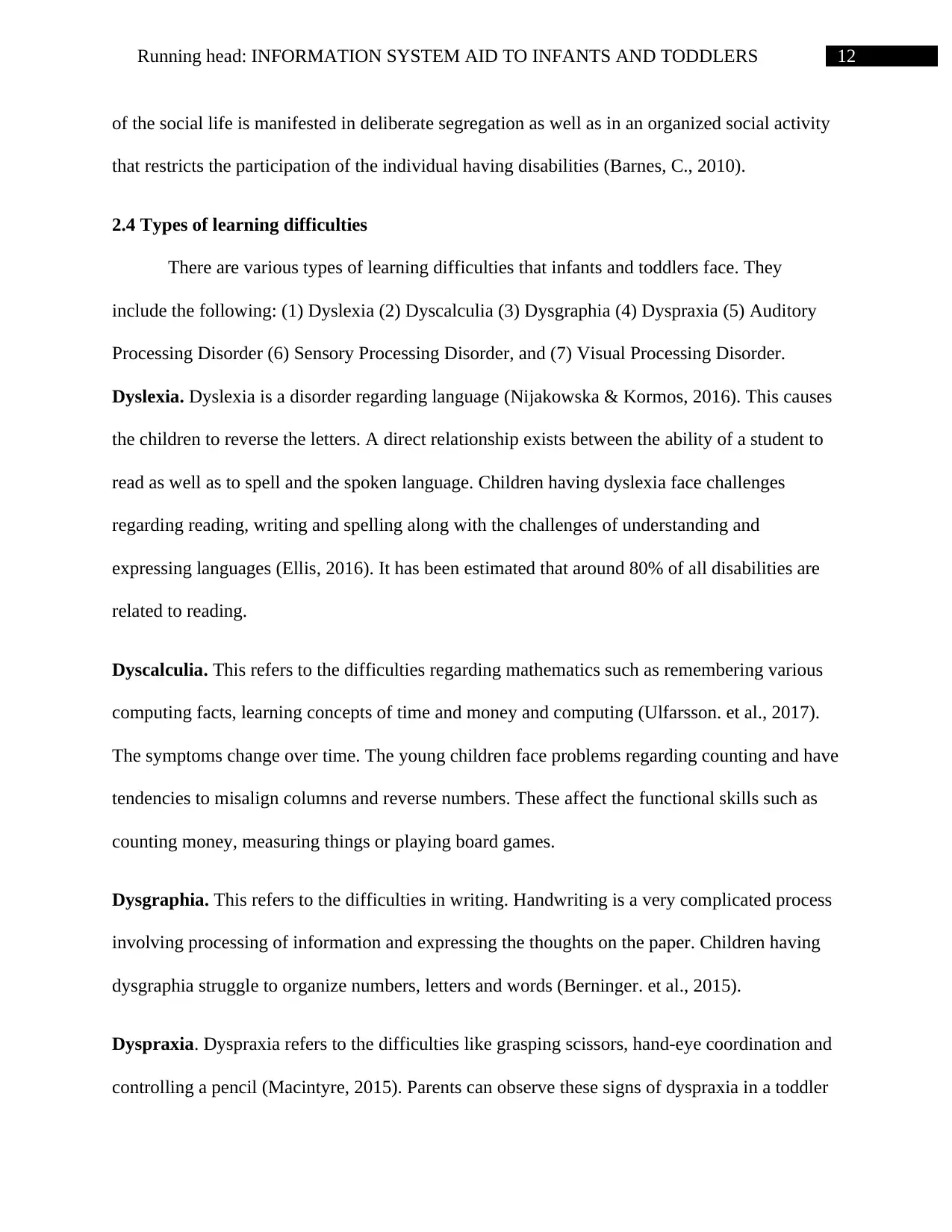
12Running head: INFORMATION SYSTEM AID TO INFANTS AND TODDLERS
of the social life is manifested in deliberate segregation as well as in an organized social activity
that restricts the participation of the individual having disabilities (Barnes, C., 2010).
2.4 Types of learning difficulties
There are various types of learning difficulties that infants and toddlers face. They
include the following: (1) Dyslexia (2) Dyscalculia (3) Dysgraphia (4) Dyspraxia (5) Auditory
Processing Disorder (6) Sensory Processing Disorder, and (7) Visual Processing Disorder.
Dyslexia. Dyslexia is a disorder regarding language (Nijakowska & Kormos, 2016). This causes
the children to reverse the letters. A direct relationship exists between the ability of a student to
read as well as to spell and the spoken language. Children having dyslexia face challenges
regarding reading, writing and spelling along with the challenges of understanding and
expressing languages (Ellis, 2016). It has been estimated that around 80% of all disabilities are
related to reading.
Dyscalculia. This refers to the difficulties regarding mathematics such as remembering various
computing facts, learning concepts of time and money and computing (Ulfarsson. et al., 2017).
The symptoms change over time. The young children face problems regarding counting and have
tendencies to misalign columns and reverse numbers. These affect the functional skills such as
counting money, measuring things or playing board games.
Dysgraphia. This refers to the difficulties in writing. Handwriting is a very complicated process
involving processing of information and expressing the thoughts on the paper. Children having
dysgraphia struggle to organize numbers, letters and words (Berninger. et al., 2015).
Dyspraxia. Dyspraxia refers to the difficulties like grasping scissors, hand-eye coordination and
controlling a pencil (Macintyre, 2015). Parents can observe these signs of dyspraxia in a toddler
of the social life is manifested in deliberate segregation as well as in an organized social activity
that restricts the participation of the individual having disabilities (Barnes, C., 2010).
2.4 Types of learning difficulties
There are various types of learning difficulties that infants and toddlers face. They
include the following: (1) Dyslexia (2) Dyscalculia (3) Dysgraphia (4) Dyspraxia (5) Auditory
Processing Disorder (6) Sensory Processing Disorder, and (7) Visual Processing Disorder.
Dyslexia. Dyslexia is a disorder regarding language (Nijakowska & Kormos, 2016). This causes
the children to reverse the letters. A direct relationship exists between the ability of a student to
read as well as to spell and the spoken language. Children having dyslexia face challenges
regarding reading, writing and spelling along with the challenges of understanding and
expressing languages (Ellis, 2016). It has been estimated that around 80% of all disabilities are
related to reading.
Dyscalculia. This refers to the difficulties regarding mathematics such as remembering various
computing facts, learning concepts of time and money and computing (Ulfarsson. et al., 2017).
The symptoms change over time. The young children face problems regarding counting and have
tendencies to misalign columns and reverse numbers. These affect the functional skills such as
counting money, measuring things or playing board games.
Dysgraphia. This refers to the difficulties in writing. Handwriting is a very complicated process
involving processing of information and expressing the thoughts on the paper. Children having
dysgraphia struggle to organize numbers, letters and words (Berninger. et al., 2015).
Dyspraxia. Dyspraxia refers to the difficulties like grasping scissors, hand-eye coordination and
controlling a pencil (Macintyre, 2015). Parents can observe these signs of dyspraxia in a toddler
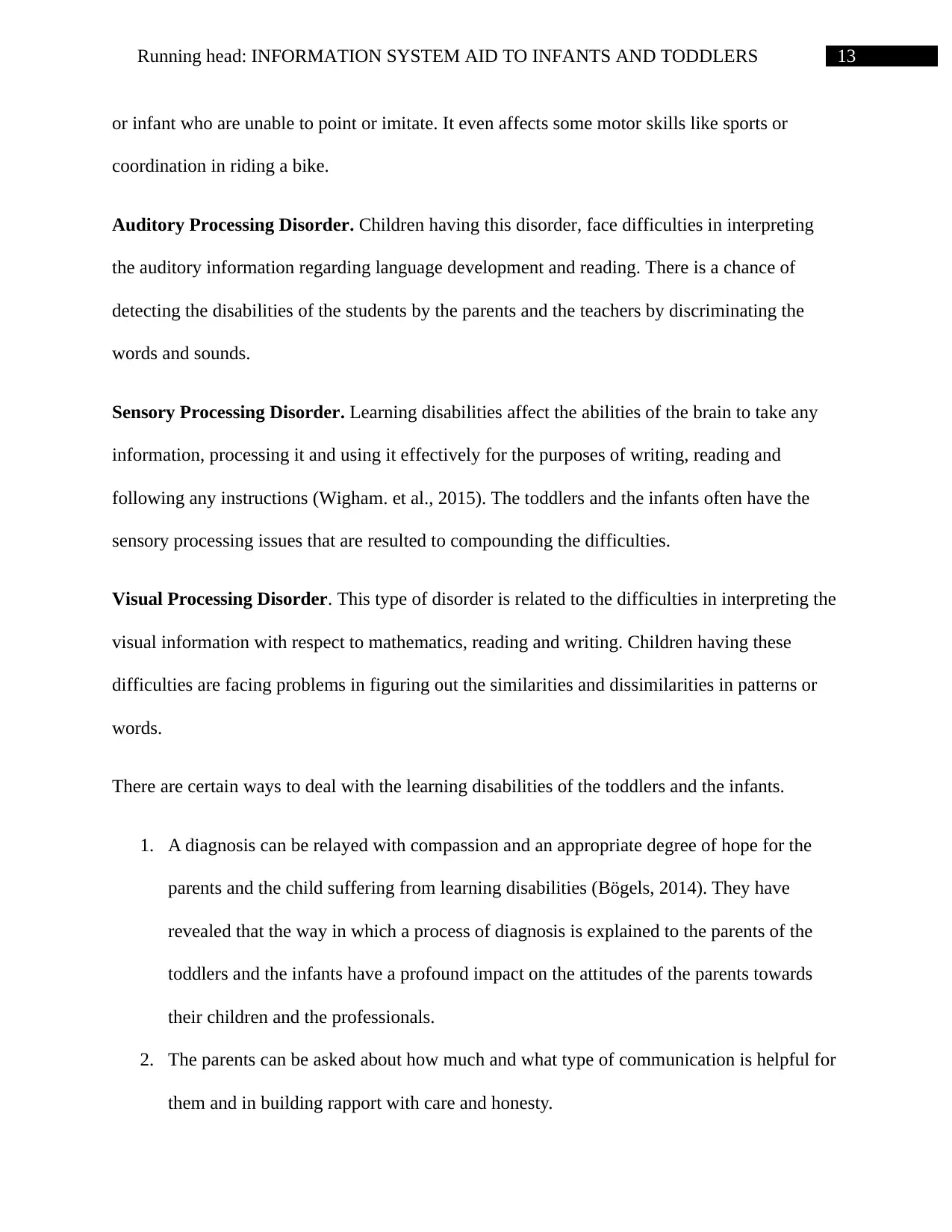
13Running head: INFORMATION SYSTEM AID TO INFANTS AND TODDLERS
or infant who are unable to point or imitate. It even affects some motor skills like sports or
coordination in riding a bike.
Auditory Processing Disorder. Children having this disorder, face difficulties in interpreting
the auditory information regarding language development and reading. There is a chance of
detecting the disabilities of the students by the parents and the teachers by discriminating the
words and sounds.
Sensory Processing Disorder. Learning disabilities affect the abilities of the brain to take any
information, processing it and using it effectively for the purposes of writing, reading and
following any instructions (Wigham. et al., 2015). The toddlers and the infants often have the
sensory processing issues that are resulted to compounding the difficulties.
Visual Processing Disorder. This type of disorder is related to the difficulties in interpreting the
visual information with respect to mathematics, reading and writing. Children having these
difficulties are facing problems in figuring out the similarities and dissimilarities in patterns or
words.
There are certain ways to deal with the learning disabilities of the toddlers and the infants.
1. A diagnosis can be relayed with compassion and an appropriate degree of hope for the
parents and the child suffering from learning disabilities (Bögels, 2014). They have
revealed that the way in which a process of diagnosis is explained to the parents of the
toddlers and the infants have a profound impact on the attitudes of the parents towards
their children and the professionals.
2. The parents can be asked about how much and what type of communication is helpful for
them and in building rapport with care and honesty.
or infant who are unable to point or imitate. It even affects some motor skills like sports or
coordination in riding a bike.
Auditory Processing Disorder. Children having this disorder, face difficulties in interpreting
the auditory information regarding language development and reading. There is a chance of
detecting the disabilities of the students by the parents and the teachers by discriminating the
words and sounds.
Sensory Processing Disorder. Learning disabilities affect the abilities of the brain to take any
information, processing it and using it effectively for the purposes of writing, reading and
following any instructions (Wigham. et al., 2015). The toddlers and the infants often have the
sensory processing issues that are resulted to compounding the difficulties.
Visual Processing Disorder. This type of disorder is related to the difficulties in interpreting the
visual information with respect to mathematics, reading and writing. Children having these
difficulties are facing problems in figuring out the similarities and dissimilarities in patterns or
words.
There are certain ways to deal with the learning disabilities of the toddlers and the infants.
1. A diagnosis can be relayed with compassion and an appropriate degree of hope for the
parents and the child suffering from learning disabilities (Bögels, 2014). They have
revealed that the way in which a process of diagnosis is explained to the parents of the
toddlers and the infants have a profound impact on the attitudes of the parents towards
their children and the professionals.
2. The parents can be asked about how much and what type of communication is helpful for
them and in building rapport with care and honesty.
Paraphrase This Document
Need a fresh take? Get an instant paraphrase of this document with our AI Paraphraser
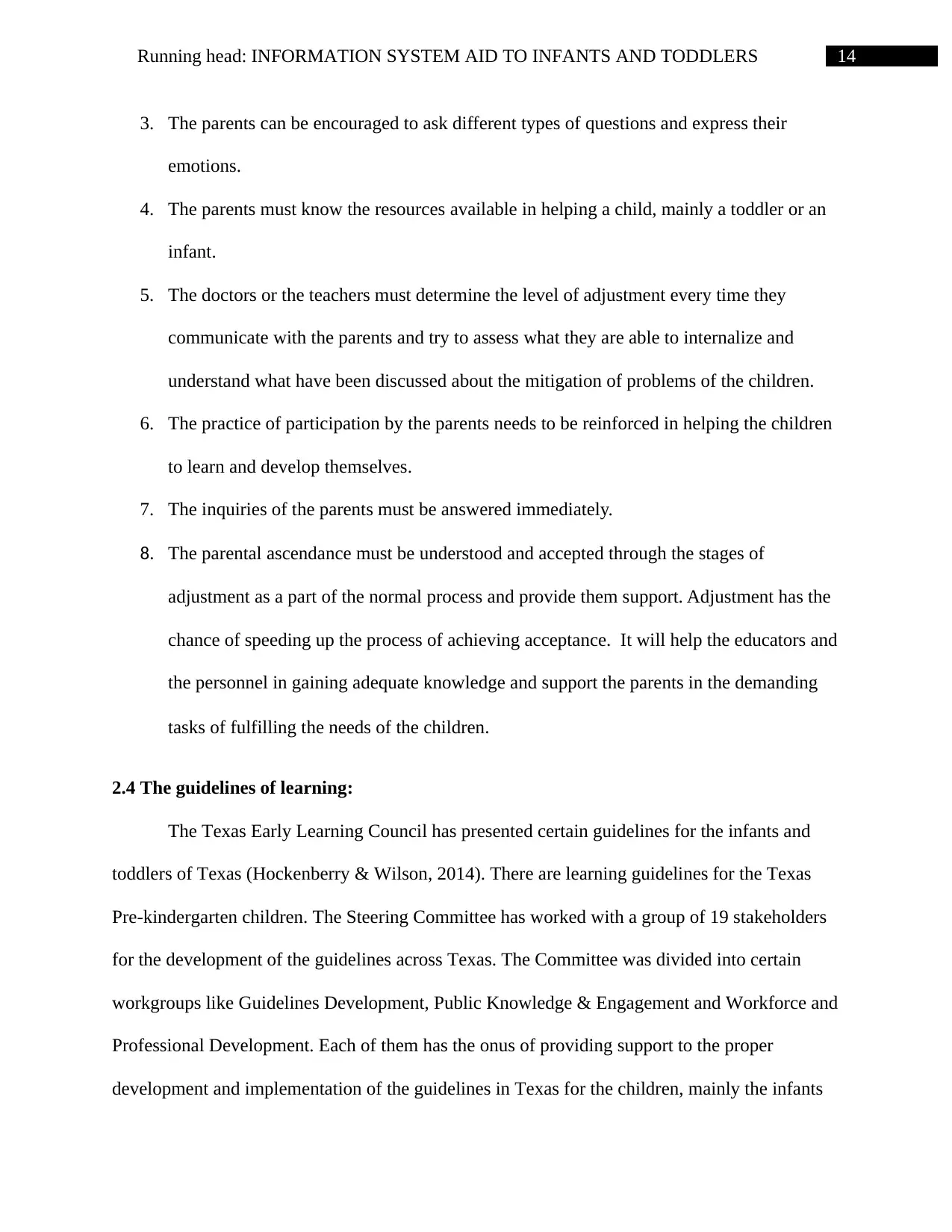
14Running head: INFORMATION SYSTEM AID TO INFANTS AND TODDLERS
3. The parents can be encouraged to ask different types of questions and express their
emotions.
4. The parents must know the resources available in helping a child, mainly a toddler or an
infant.
5. The doctors or the teachers must determine the level of adjustment every time they
communicate with the parents and try to assess what they are able to internalize and
understand what have been discussed about the mitigation of problems of the children.
6. The practice of participation by the parents needs to be reinforced in helping the children
to learn and develop themselves.
7. The inquiries of the parents must be answered immediately.
8. The parental ascendance must be understood and accepted through the stages of
adjustment as a part of the normal process and provide them support. Adjustment has the
chance of speeding up the process of achieving acceptance. It will help the educators and
the personnel in gaining adequate knowledge and support the parents in the demanding
tasks of fulfilling the needs of the children.
2.4 The guidelines of learning:
The Texas Early Learning Council has presented certain guidelines for the infants and
toddlers of Texas (Hockenberry & Wilson, 2014). There are learning guidelines for the Texas
Pre-kindergarten children. The Steering Committee has worked with a group of 19 stakeholders
for the development of the guidelines across Texas. The Committee was divided into certain
workgroups like Guidelines Development, Public Knowledge & Engagement and Workforce and
Professional Development. Each of them has the onus of providing support to the proper
development and implementation of the guidelines in Texas for the children, mainly the infants
3. The parents can be encouraged to ask different types of questions and express their
emotions.
4. The parents must know the resources available in helping a child, mainly a toddler or an
infant.
5. The doctors or the teachers must determine the level of adjustment every time they
communicate with the parents and try to assess what they are able to internalize and
understand what have been discussed about the mitigation of problems of the children.
6. The practice of participation by the parents needs to be reinforced in helping the children
to learn and develop themselves.
7. The inquiries of the parents must be answered immediately.
8. The parental ascendance must be understood and accepted through the stages of
adjustment as a part of the normal process and provide them support. Adjustment has the
chance of speeding up the process of achieving acceptance. It will help the educators and
the personnel in gaining adequate knowledge and support the parents in the demanding
tasks of fulfilling the needs of the children.
2.4 The guidelines of learning:
The Texas Early Learning Council has presented certain guidelines for the infants and
toddlers of Texas (Hockenberry & Wilson, 2014). There are learning guidelines for the Texas
Pre-kindergarten children. The Steering Committee has worked with a group of 19 stakeholders
for the development of the guidelines across Texas. The Committee was divided into certain
workgroups like Guidelines Development, Public Knowledge & Engagement and Workforce and
Professional Development. Each of them has the onus of providing support to the proper
development and implementation of the guidelines in Texas for the children, mainly the infants
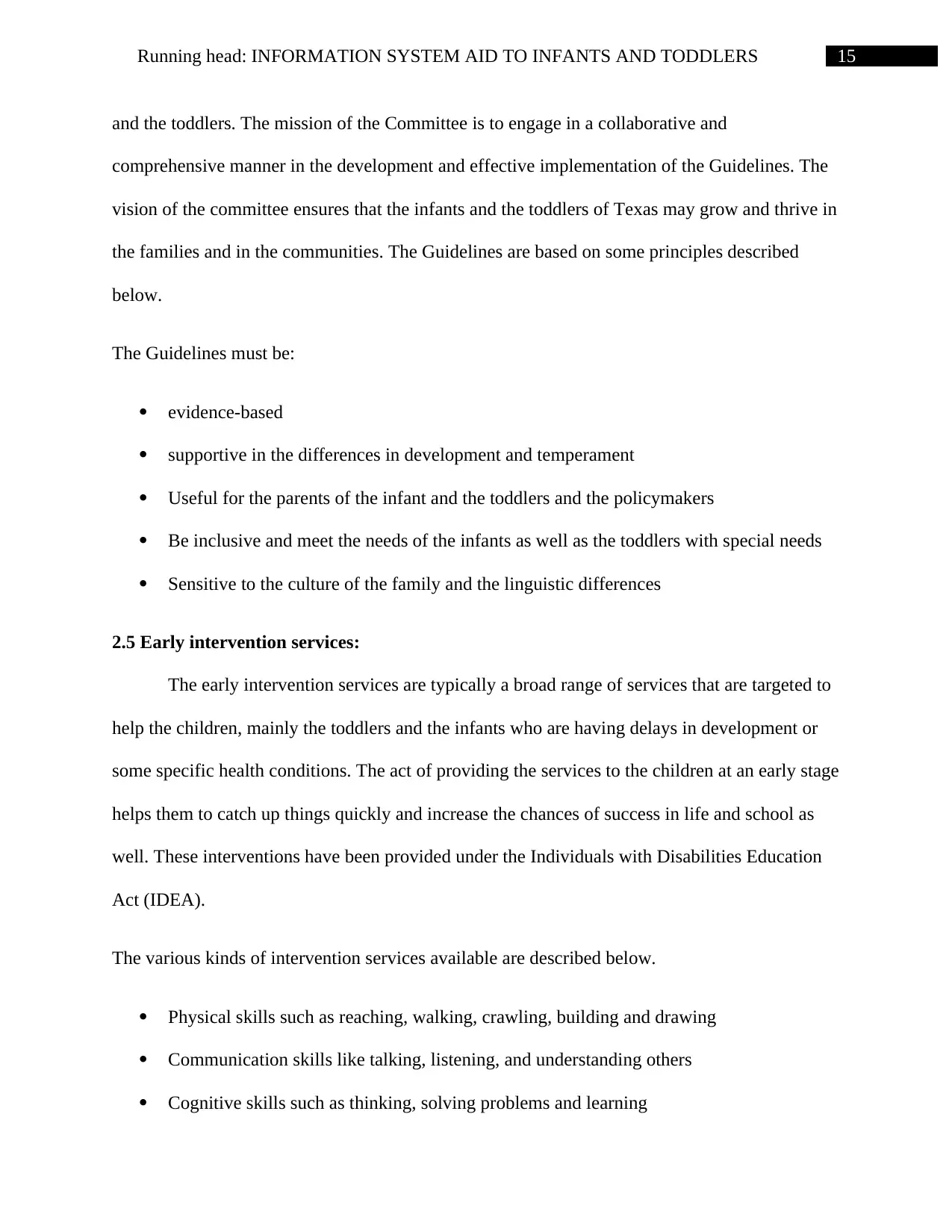
15Running head: INFORMATION SYSTEM AID TO INFANTS AND TODDLERS
and the toddlers. The mission of the Committee is to engage in a collaborative and
comprehensive manner in the development and effective implementation of the Guidelines. The
vision of the committee ensures that the infants and the toddlers of Texas may grow and thrive in
the families and in the communities. The Guidelines are based on some principles described
below.
The Guidelines must be:
evidence-based
supportive in the differences in development and temperament
Useful for the parents of the infant and the toddlers and the policymakers
Be inclusive and meet the needs of the infants as well as the toddlers with special needs
Sensitive to the culture of the family and the linguistic differences
2.5 Early intervention services:
The early intervention services are typically a broad range of services that are targeted to
help the children, mainly the toddlers and the infants who are having delays in development or
some specific health conditions. The act of providing the services to the children at an early stage
helps them to catch up things quickly and increase the chances of success in life and school as
well. These interventions have been provided under the Individuals with Disabilities Education
Act (IDEA).
The various kinds of intervention services available are described below.
Physical skills such as reaching, walking, crawling, building and drawing
Communication skills like talking, listening, and understanding others
Cognitive skills such as thinking, solving problems and learning
and the toddlers. The mission of the Committee is to engage in a collaborative and
comprehensive manner in the development and effective implementation of the Guidelines. The
vision of the committee ensures that the infants and the toddlers of Texas may grow and thrive in
the families and in the communities. The Guidelines are based on some principles described
below.
The Guidelines must be:
evidence-based
supportive in the differences in development and temperament
Useful for the parents of the infant and the toddlers and the policymakers
Be inclusive and meet the needs of the infants as well as the toddlers with special needs
Sensitive to the culture of the family and the linguistic differences
2.5 Early intervention services:
The early intervention services are typically a broad range of services that are targeted to
help the children, mainly the toddlers and the infants who are having delays in development or
some specific health conditions. The act of providing the services to the children at an early stage
helps them to catch up things quickly and increase the chances of success in life and school as
well. These interventions have been provided under the Individuals with Disabilities Education
Act (IDEA).
The various kinds of intervention services available are described below.
Physical skills such as reaching, walking, crawling, building and drawing
Communication skills like talking, listening, and understanding others
Cognitive skills such as thinking, solving problems and learning
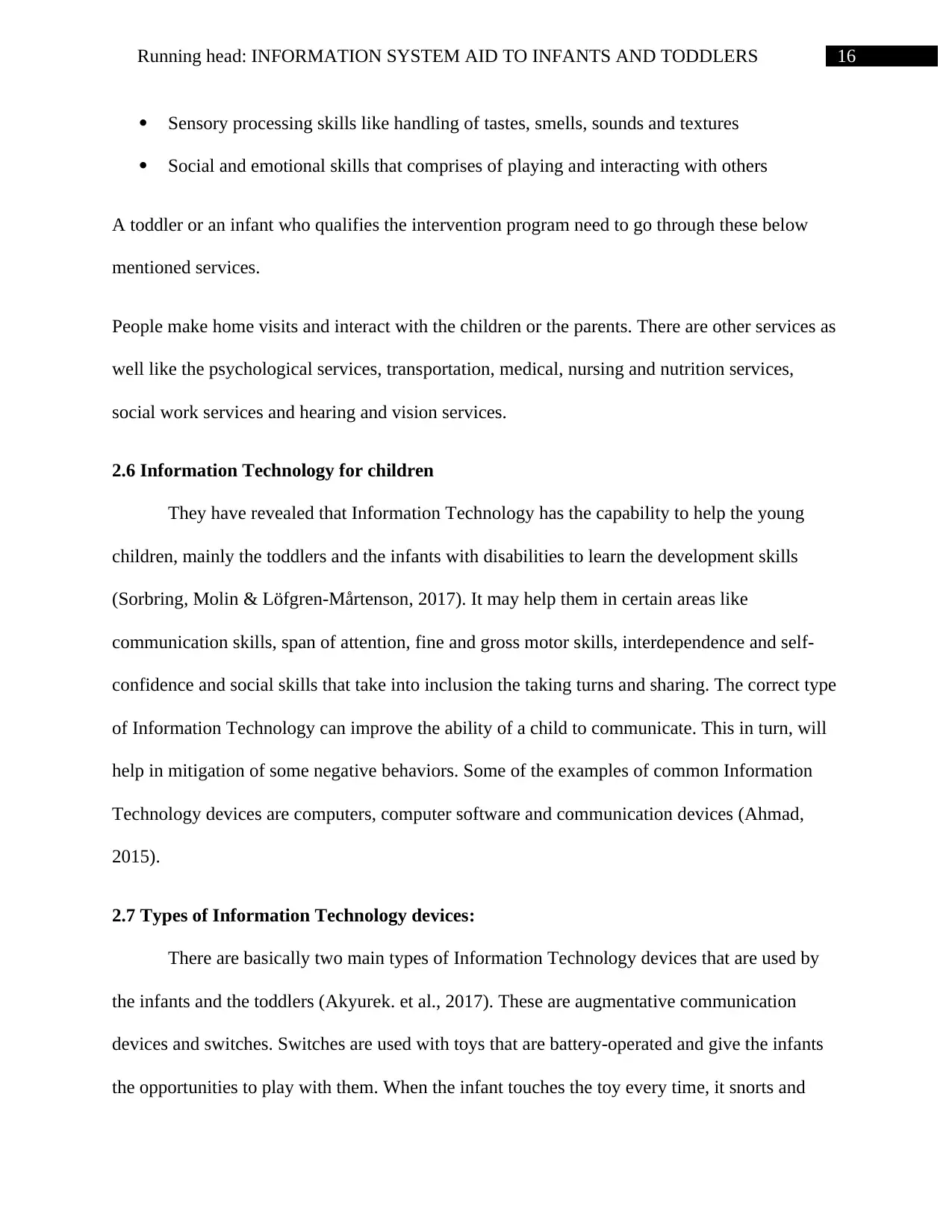
16Running head: INFORMATION SYSTEM AID TO INFANTS AND TODDLERS
Sensory processing skills like handling of tastes, smells, sounds and textures
Social and emotional skills that comprises of playing and interacting with others
A toddler or an infant who qualifies the intervention program need to go through these below
mentioned services.
People make home visits and interact with the children or the parents. There are other services as
well like the psychological services, transportation, medical, nursing and nutrition services,
social work services and hearing and vision services.
2.6 Information Technology for children
They have revealed that Information Technology has the capability to help the young
children, mainly the toddlers and the infants with disabilities to learn the development skills
(Sorbring, Molin & Löfgren-Mårtenson, 2017). It may help them in certain areas like
communication skills, span of attention, fine and gross motor skills, interdependence and self-
confidence and social skills that take into inclusion the taking turns and sharing. The correct type
of Information Technology can improve the ability of a child to communicate. This in turn, will
help in mitigation of some negative behaviors. Some of the examples of common Information
Technology devices are computers, computer software and communication devices (Ahmad,
2015).
2.7 Types of Information Technology devices:
There are basically two main types of Information Technology devices that are used by
the infants and the toddlers (Akyurek. et al., 2017). These are augmentative communication
devices and switches. Switches are used with toys that are battery-operated and give the infants
the opportunities to play with them. When the infant touches the toy every time, it snorts and
Sensory processing skills like handling of tastes, smells, sounds and textures
Social and emotional skills that comprises of playing and interacting with others
A toddler or an infant who qualifies the intervention program need to go through these below
mentioned services.
People make home visits and interact with the children or the parents. There are other services as
well like the psychological services, transportation, medical, nursing and nutrition services,
social work services and hearing and vision services.
2.6 Information Technology for children
They have revealed that Information Technology has the capability to help the young
children, mainly the toddlers and the infants with disabilities to learn the development skills
(Sorbring, Molin & Löfgren-Mårtenson, 2017). It may help them in certain areas like
communication skills, span of attention, fine and gross motor skills, interdependence and self-
confidence and social skills that take into inclusion the taking turns and sharing. The correct type
of Information Technology can improve the ability of a child to communicate. This in turn, will
help in mitigation of some negative behaviors. Some of the examples of common Information
Technology devices are computers, computer software and communication devices (Ahmad,
2015).
2.7 Types of Information Technology devices:
There are basically two main types of Information Technology devices that are used by
the infants and the toddlers (Akyurek. et al., 2017). These are augmentative communication
devices and switches. Switches are used with toys that are battery-operated and give the infants
the opportunities to play with them. When the infant touches the toy every time, it snorts and
Secure Best Marks with AI Grader
Need help grading? Try our AI Grader for instant feedback on your assignments.

17Running head: INFORMATION SYSTEM AID TO INFANTS AND TODDLERS
wiggles. Switches can be used to turn them on and off. Toddlers will be able to learn to press the
switch in turning the devices on or usage of interactive devices. Children who are having the
disabilities will also be able to use the switches. A switch is generally placed next to the infant’s
head and every time he moves his head to the left or right, a musical mobile hanging overhead is
played.
Augmentative communication materials help the young children, who are unable to speak
and communicate with the world (Costello, Santiago & Blackstone, 2015). These devices are
generally very simple such as pointing to a photo on a board. They can be complicated such as
presenting message buttons on the devices that can activate pre-recorded messages.
Information Technology is important as most of the skills are learned in the infancy and
help the toddlers and the infants having disabilities, to learn many vital and crucial development
skills (Roth. wt al., 2016). The technology helps them to learn the same things as that of non-
disabled children but in a different way. The communications skills are very important for the
children who are suffering from disabilities since most of the things an infant or a toddler learns
is about interacting with each other (Sousa, 2016). Information technology is also important
since the expectations of an infant or a toddler increases as he grows up. Augmentative
communication devices encourage a child to enhance the communication efforts and skills. The
parents have a dream that their child will be diagnosed with the help of the information
technology.
Chapter 3: Research methodology:
Research methodology deals with the different types of techniques and the methods of
the research. Research methodology can also be stated as a systematic process that helps in
wiggles. Switches can be used to turn them on and off. Toddlers will be able to learn to press the
switch in turning the devices on or usage of interactive devices. Children who are having the
disabilities will also be able to use the switches. A switch is generally placed next to the infant’s
head and every time he moves his head to the left or right, a musical mobile hanging overhead is
played.
Augmentative communication materials help the young children, who are unable to speak
and communicate with the world (Costello, Santiago & Blackstone, 2015). These devices are
generally very simple such as pointing to a photo on a board. They can be complicated such as
presenting message buttons on the devices that can activate pre-recorded messages.
Information Technology is important as most of the skills are learned in the infancy and
help the toddlers and the infants having disabilities, to learn many vital and crucial development
skills (Roth. wt al., 2016). The technology helps them to learn the same things as that of non-
disabled children but in a different way. The communications skills are very important for the
children who are suffering from disabilities since most of the things an infant or a toddler learns
is about interacting with each other (Sousa, 2016). Information technology is also important
since the expectations of an infant or a toddler increases as he grows up. Augmentative
communication devices encourage a child to enhance the communication efforts and skills. The
parents have a dream that their child will be diagnosed with the help of the information
technology.
Chapter 3: Research methodology:
Research methodology deals with the different types of techniques and the methods of
the research. Research methodology can also be stated as a systematic process that helps in
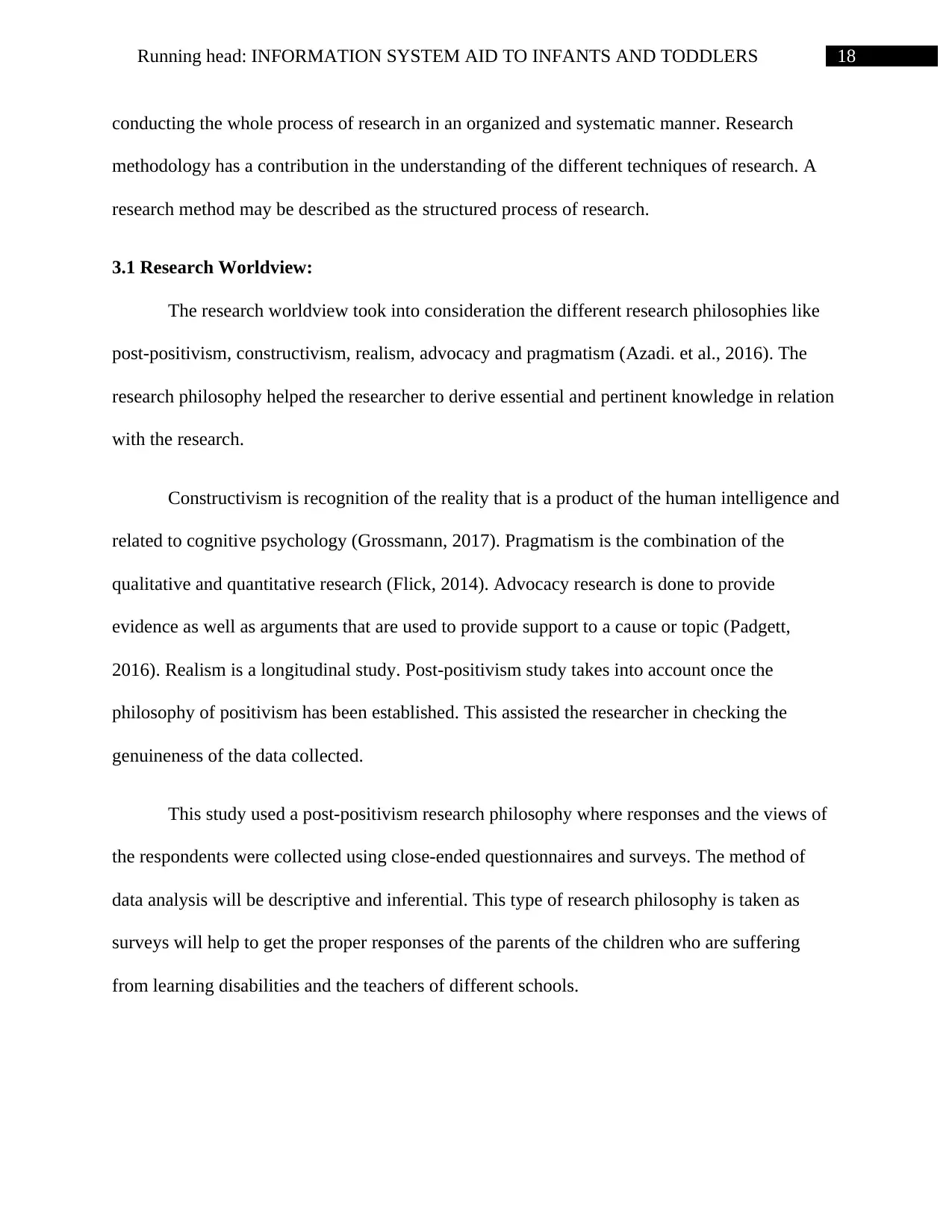
18Running head: INFORMATION SYSTEM AID TO INFANTS AND TODDLERS
conducting the whole process of research in an organized and systematic manner. Research
methodology has a contribution in the understanding of the different techniques of research. A
research method may be described as the structured process of research.
3.1 Research Worldview:
The research worldview took into consideration the different research philosophies like
post-positivism, constructivism, realism, advocacy and pragmatism (Azadi. et al., 2016). The
research philosophy helped the researcher to derive essential and pertinent knowledge in relation
with the research.
Constructivism is recognition of the reality that is a product of the human intelligence and
related to cognitive psychology (Grossmann, 2017). Pragmatism is the combination of the
qualitative and quantitative research (Flick, 2014). Advocacy research is done to provide
evidence as well as arguments that are used to provide support to a cause or topic (Padgett,
2016). Realism is a longitudinal study. Post-positivism study takes into account once the
philosophy of positivism has been established. This assisted the researcher in checking the
genuineness of the data collected.
This study used a post-positivism research philosophy where responses and the views of
the respondents were collected using close-ended questionnaires and surveys. The method of
data analysis will be descriptive and inferential. This type of research philosophy is taken as
surveys will help to get the proper responses of the parents of the children who are suffering
from learning disabilities and the teachers of different schools.
conducting the whole process of research in an organized and systematic manner. Research
methodology has a contribution in the understanding of the different techniques of research. A
research method may be described as the structured process of research.
3.1 Research Worldview:
The research worldview took into consideration the different research philosophies like
post-positivism, constructivism, realism, advocacy and pragmatism (Azadi. et al., 2016). The
research philosophy helped the researcher to derive essential and pertinent knowledge in relation
with the research.
Constructivism is recognition of the reality that is a product of the human intelligence and
related to cognitive psychology (Grossmann, 2017). Pragmatism is the combination of the
qualitative and quantitative research (Flick, 2014). Advocacy research is done to provide
evidence as well as arguments that are used to provide support to a cause or topic (Padgett,
2016). Realism is a longitudinal study. Post-positivism study takes into account once the
philosophy of positivism has been established. This assisted the researcher in checking the
genuineness of the data collected.
This study used a post-positivism research philosophy where responses and the views of
the respondents were collected using close-ended questionnaires and surveys. The method of
data analysis will be descriptive and inferential. This type of research philosophy is taken as
surveys will help to get the proper responses of the parents of the children who are suffering
from learning disabilities and the teachers of different schools.

19Running head: INFORMATION SYSTEM AID TO INFANTS AND TODDLERS
3.2 Research Design:
The research study took into account the descriptive research design which had been best
suited for the research. Quantitative research was conducted so that research was focused and
conclusive and focuses on hypothesis testing. The hypothesis was narrowed by their testing and
predictions in the research study.
3.3 Research Strategy:
The strategy for the research will be through surveys and questionnaires and the analysis
will be done accordingly. The questions in the questionnaire had been closed ended. There are
two types of research approaches. They are inductive and deductive. The inductive approach of
research follows observation, data analysis, and collection of data from primary and secondary
sources and establishment of the theories (Ary. et al., 2013). Deductive approach on the other
hand, defines the selection of necessary theories, hypothesis testing, data analysis and
implementation of the relevant theories for the analysis of the data and confirming the theoretical
evidences (Glaser, 2017). The approach of the research for this topic had been deductive or the
top down approach where conclusions were drawn from the theories that are already there and
the data will be matched with them.
3.4 Method of Data Collection:
For the conduction of a research process, several data are required. The data to be
collected for a research are of two types, primary and secondary. Primary data is referred to as
the data that are collected from the surveys, interviews and questionnaires (Fallon, 2016). These
types of data are collected from the respondents after asking them some questions about the
relevant topic. Secondary data, on the other hand, can be collected from the various sources like
3.2 Research Design:
The research study took into account the descriptive research design which had been best
suited for the research. Quantitative research was conducted so that research was focused and
conclusive and focuses on hypothesis testing. The hypothesis was narrowed by their testing and
predictions in the research study.
3.3 Research Strategy:
The strategy for the research will be through surveys and questionnaires and the analysis
will be done accordingly. The questions in the questionnaire had been closed ended. There are
two types of research approaches. They are inductive and deductive. The inductive approach of
research follows observation, data analysis, and collection of data from primary and secondary
sources and establishment of the theories (Ary. et al., 2013). Deductive approach on the other
hand, defines the selection of necessary theories, hypothesis testing, data analysis and
implementation of the relevant theories for the analysis of the data and confirming the theoretical
evidences (Glaser, 2017). The approach of the research for this topic had been deductive or the
top down approach where conclusions were drawn from the theories that are already there and
the data will be matched with them.
3.4 Method of Data Collection:
For the conduction of a research process, several data are required. The data to be
collected for a research are of two types, primary and secondary. Primary data is referred to as
the data that are collected from the surveys, interviews and questionnaires (Fallon, 2016). These
types of data are collected from the respondents after asking them some questions about the
relevant topic. Secondary data, on the other hand, can be collected from the various sources like
Paraphrase This Document
Need a fresh take? Get an instant paraphrase of this document with our AI Paraphraser
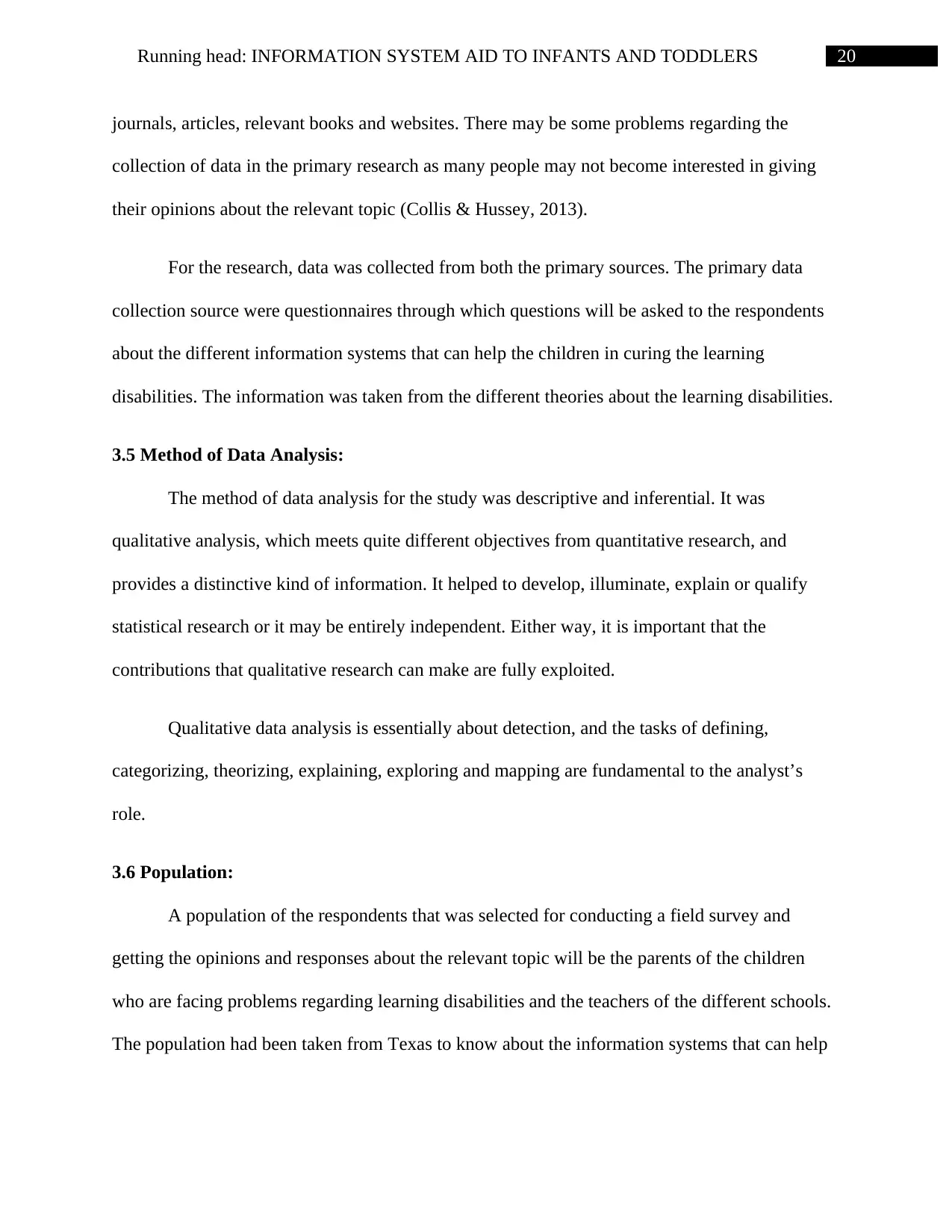
20Running head: INFORMATION SYSTEM AID TO INFANTS AND TODDLERS
journals, articles, relevant books and websites. There may be some problems regarding the
collection of data in the primary research as many people may not become interested in giving
their opinions about the relevant topic (Collis & Hussey, 2013).
For the research, data was collected from both the primary sources. The primary data
collection source were questionnaires through which questions will be asked to the respondents
about the different information systems that can help the children in curing the learning
disabilities. The information was taken from the different theories about the learning disabilities.
3.5 Method of Data Analysis:
The method of data analysis for the study was descriptive and inferential. It was
qualitative analysis, which meets quite different objectives from quantitative research, and
provides a distinctive kind of information. It helped to develop, illuminate, explain or qualify
statistical research or it may be entirely independent. Either way, it is important that the
contributions that qualitative research can make are fully exploited.
Qualitative data analysis is essentially about detection, and the tasks of defining,
categorizing, theorizing, explaining, exploring and mapping are fundamental to the analyst’s
role.
3.6 Population:
A population of the respondents that was selected for conducting a field survey and
getting the opinions and responses about the relevant topic will be the parents of the children
who are facing problems regarding learning disabilities and the teachers of the different schools.
The population had been taken from Texas to know about the information systems that can help
journals, articles, relevant books and websites. There may be some problems regarding the
collection of data in the primary research as many people may not become interested in giving
their opinions about the relevant topic (Collis & Hussey, 2013).
For the research, data was collected from both the primary sources. The primary data
collection source were questionnaires through which questions will be asked to the respondents
about the different information systems that can help the children in curing the learning
disabilities. The information was taken from the different theories about the learning disabilities.
3.5 Method of Data Analysis:
The method of data analysis for the study was descriptive and inferential. It was
qualitative analysis, which meets quite different objectives from quantitative research, and
provides a distinctive kind of information. It helped to develop, illuminate, explain or qualify
statistical research or it may be entirely independent. Either way, it is important that the
contributions that qualitative research can make are fully exploited.
Qualitative data analysis is essentially about detection, and the tasks of defining,
categorizing, theorizing, explaining, exploring and mapping are fundamental to the analyst’s
role.
3.6 Population:
A population of the respondents that was selected for conducting a field survey and
getting the opinions and responses about the relevant topic will be the parents of the children
who are facing problems regarding learning disabilities and the teachers of the different schools.
The population had been taken from Texas to know about the information systems that can help
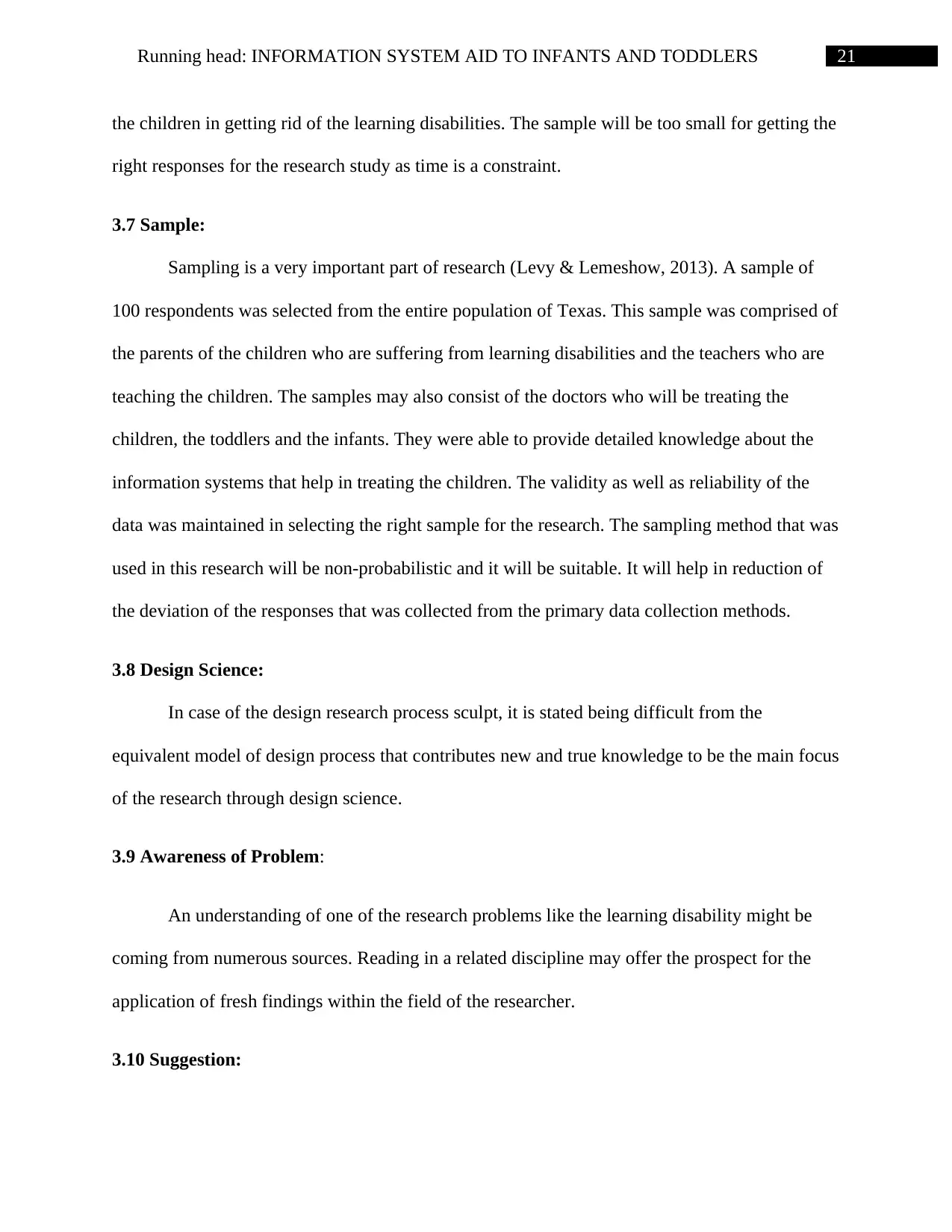
21Running head: INFORMATION SYSTEM AID TO INFANTS AND TODDLERS
the children in getting rid of the learning disabilities. The sample will be too small for getting the
right responses for the research study as time is a constraint.
3.7 Sample:
Sampling is a very important part of research (Levy & Lemeshow, 2013). A sample of
100 respondents was selected from the entire population of Texas. This sample was comprised of
the parents of the children who are suffering from learning disabilities and the teachers who are
teaching the children. The samples may also consist of the doctors who will be treating the
children, the toddlers and the infants. They were able to provide detailed knowledge about the
information systems that help in treating the children. The validity as well as reliability of the
data was maintained in selecting the right sample for the research. The sampling method that was
used in this research will be non-probabilistic and it will be suitable. It will help in reduction of
the deviation of the responses that was collected from the primary data collection methods.
3.8 Design Science:
In case of the design research process sculpt, it is stated being difficult from the
equivalent model of design process that contributes new and true knowledge to be the main focus
of the research through design science.
3.9 Awareness of Problem:
An understanding of one of the research problems like the learning disability might be
coming from numerous sources. Reading in a related discipline may offer the prospect for the
application of fresh findings within the field of the researcher.
3.10 Suggestion:
the children in getting rid of the learning disabilities. The sample will be too small for getting the
right responses for the research study as time is a constraint.
3.7 Sample:
Sampling is a very important part of research (Levy & Lemeshow, 2013). A sample of
100 respondents was selected from the entire population of Texas. This sample was comprised of
the parents of the children who are suffering from learning disabilities and the teachers who are
teaching the children. The samples may also consist of the doctors who will be treating the
children, the toddlers and the infants. They were able to provide detailed knowledge about the
information systems that help in treating the children. The validity as well as reliability of the
data was maintained in selecting the right sample for the research. The sampling method that was
used in this research will be non-probabilistic and it will be suitable. It will help in reduction of
the deviation of the responses that was collected from the primary data collection methods.
3.8 Design Science:
In case of the design research process sculpt, it is stated being difficult from the
equivalent model of design process that contributes new and true knowledge to be the main focus
of the research through design science.
3.9 Awareness of Problem:
An understanding of one of the research problems like the learning disability might be
coming from numerous sources. Reading in a related discipline may offer the prospect for the
application of fresh findings within the field of the researcher.
3.10 Suggestion:
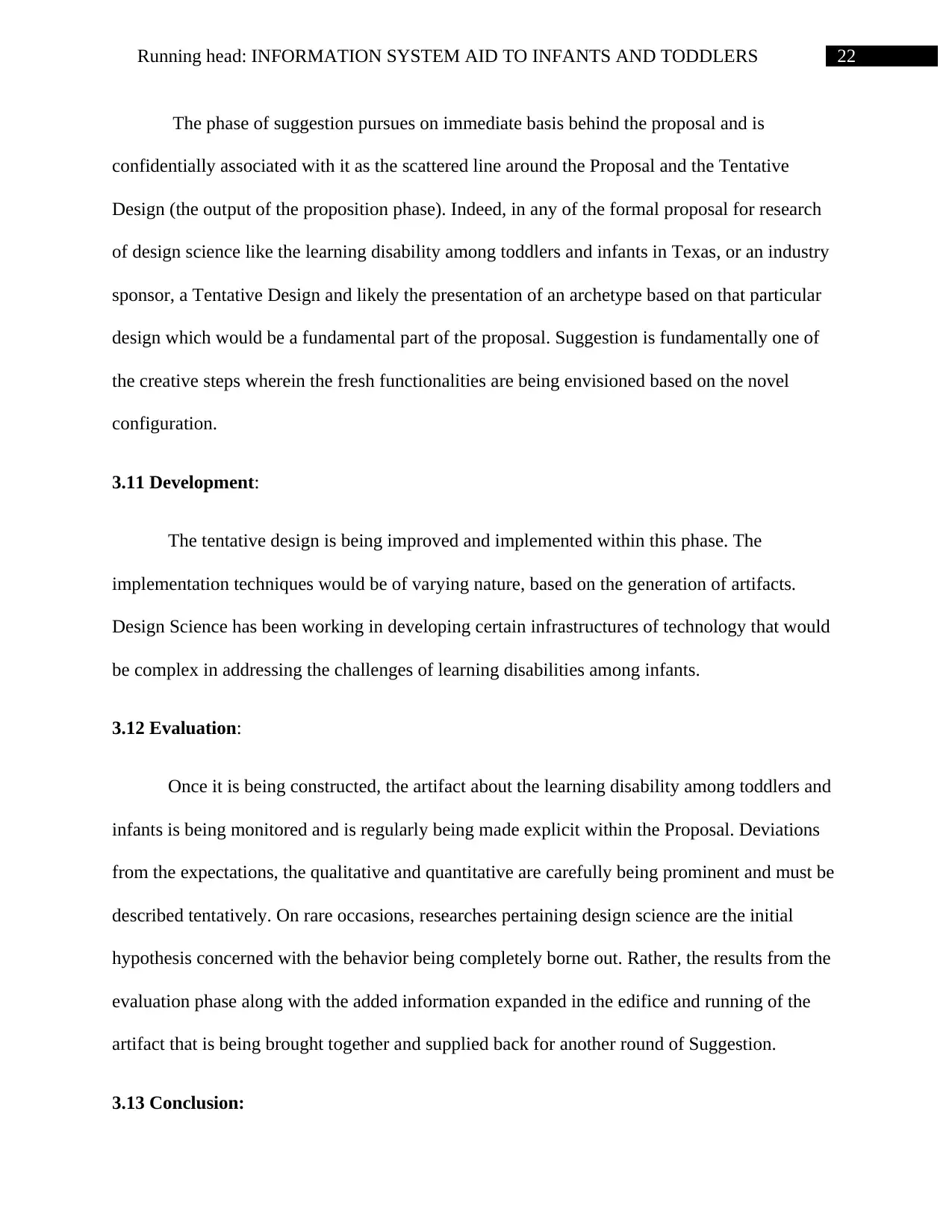
22Running head: INFORMATION SYSTEM AID TO INFANTS AND TODDLERS
The phase of suggestion pursues on immediate basis behind the proposal and is
confidentially associated with it as the scattered line around the Proposal and the Tentative
Design (the output of the proposition phase). Indeed, in any of the formal proposal for research
of design science like the learning disability among toddlers and infants in Texas, or an industry
sponsor, a Tentative Design and likely the presentation of an archetype based on that particular
design which would be a fundamental part of the proposal. Suggestion is fundamentally one of
the creative steps wherein the fresh functionalities are being envisioned based on the novel
configuration.
3.11 Development:
The tentative design is being improved and implemented within this phase. The
implementation techniques would be of varying nature, based on the generation of artifacts.
Design Science has been working in developing certain infrastructures of technology that would
be complex in addressing the challenges of learning disabilities among infants.
3.12 Evaluation:
Once it is being constructed, the artifact about the learning disability among toddlers and
infants is being monitored and is regularly being made explicit within the Proposal. Deviations
from the expectations, the qualitative and quantitative are carefully being prominent and must be
described tentatively. On rare occasions, researches pertaining design science are the initial
hypothesis concerned with the behavior being completely borne out. Rather, the results from the
evaluation phase along with the added information expanded in the edifice and running of the
artifact that is being brought together and supplied back for another round of Suggestion.
3.13 Conclusion:
The phase of suggestion pursues on immediate basis behind the proposal and is
confidentially associated with it as the scattered line around the Proposal and the Tentative
Design (the output of the proposition phase). Indeed, in any of the formal proposal for research
of design science like the learning disability among toddlers and infants in Texas, or an industry
sponsor, a Tentative Design and likely the presentation of an archetype based on that particular
design which would be a fundamental part of the proposal. Suggestion is fundamentally one of
the creative steps wherein the fresh functionalities are being envisioned based on the novel
configuration.
3.11 Development:
The tentative design is being improved and implemented within this phase. The
implementation techniques would be of varying nature, based on the generation of artifacts.
Design Science has been working in developing certain infrastructures of technology that would
be complex in addressing the challenges of learning disabilities among infants.
3.12 Evaluation:
Once it is being constructed, the artifact about the learning disability among toddlers and
infants is being monitored and is regularly being made explicit within the Proposal. Deviations
from the expectations, the qualitative and quantitative are carefully being prominent and must be
described tentatively. On rare occasions, researches pertaining design science are the initial
hypothesis concerned with the behavior being completely borne out. Rather, the results from the
evaluation phase along with the added information expanded in the edifice and running of the
artifact that is being brought together and supplied back for another round of Suggestion.
3.13 Conclusion:
Secure Best Marks with AI Grader
Need help grading? Try our AI Grader for instant feedback on your assignments.
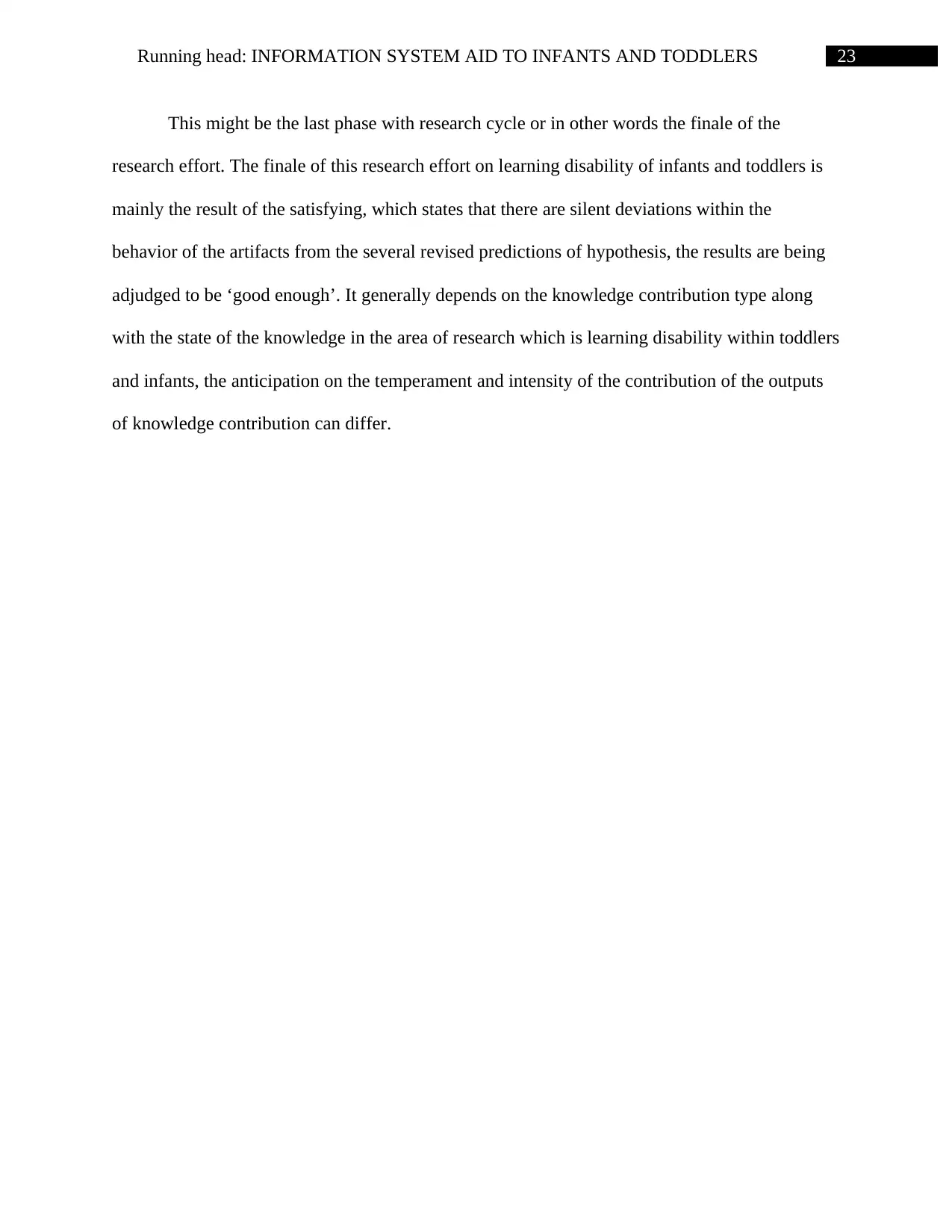
23Running head: INFORMATION SYSTEM AID TO INFANTS AND TODDLERS
This might be the last phase with research cycle or in other words the finale of the
research effort. The finale of this research effort on learning disability of infants and toddlers is
mainly the result of the satisfying, which states that there are silent deviations within the
behavior of the artifacts from the several revised predictions of hypothesis, the results are being
adjudged to be ‘good enough’. It generally depends on the knowledge contribution type along
with the state of the knowledge in the area of research which is learning disability within toddlers
and infants, the anticipation on the temperament and intensity of the contribution of the outputs
of knowledge contribution can differ.
This might be the last phase with research cycle or in other words the finale of the
research effort. The finale of this research effort on learning disability of infants and toddlers is
mainly the result of the satisfying, which states that there are silent deviations within the
behavior of the artifacts from the several revised predictions of hypothesis, the results are being
adjudged to be ‘good enough’. It generally depends on the knowledge contribution type along
with the state of the knowledge in the area of research which is learning disability within toddlers
and infants, the anticipation on the temperament and intensity of the contribution of the outputs
of knowledge contribution can differ.
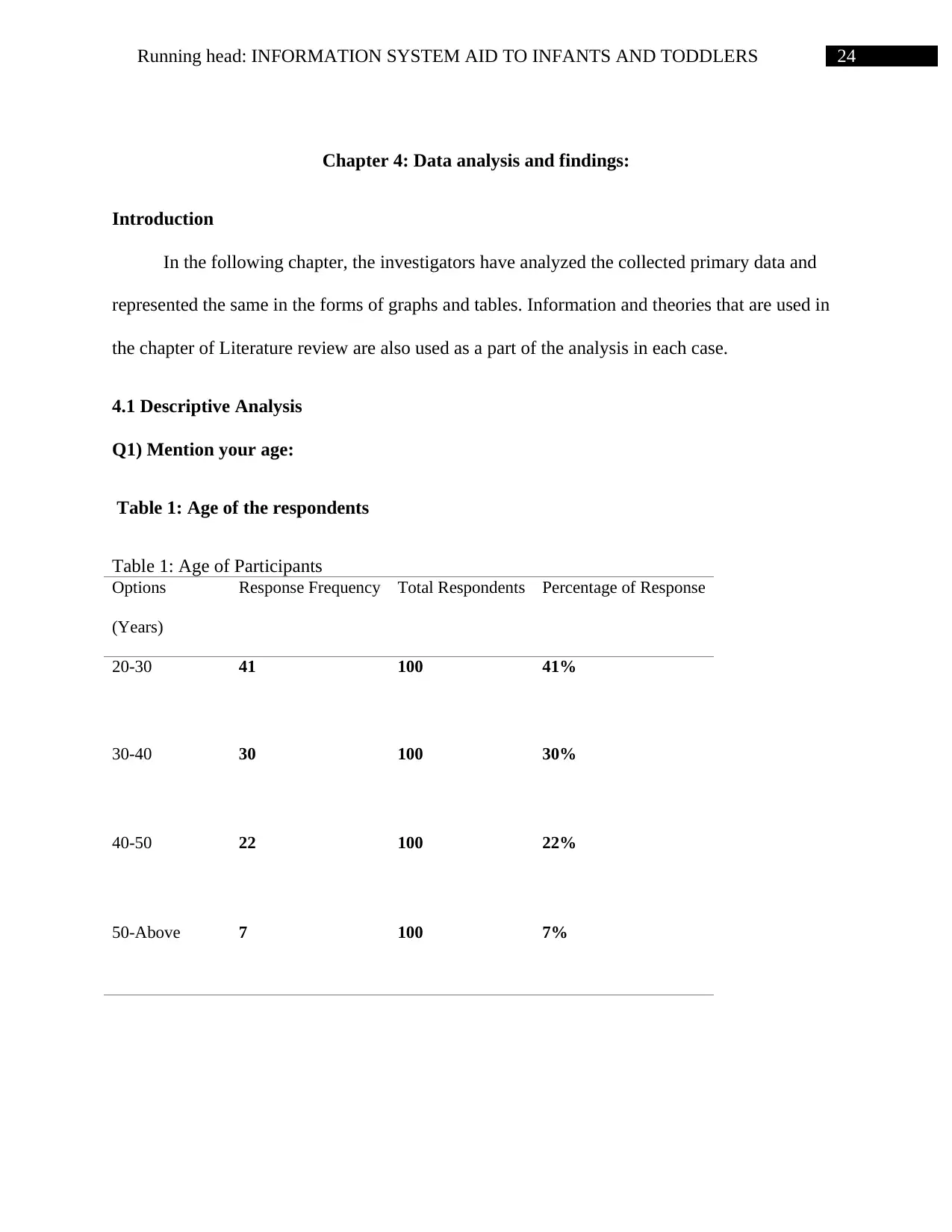
24Running head: INFORMATION SYSTEM AID TO INFANTS AND TODDLERS
Chapter 4: Data analysis and findings:
Introduction
In the following chapter, the investigators have analyzed the collected primary data and
represented the same in the forms of graphs and tables. Information and theories that are used in
the chapter of Literature review are also used as a part of the analysis in each case.
4.1 Descriptive Analysis
Q1) Mention your age:
Table 1: Age of the respondents
Table 1: Age of Participants
Options
(Years)
Response Frequency Total Respondents Percentage of Response
20-30 41 100 41%
30-40 30 100 30%
40-50 22 100 22%
50-Above 7 100 7%
Chapter 4: Data analysis and findings:
Introduction
In the following chapter, the investigators have analyzed the collected primary data and
represented the same in the forms of graphs and tables. Information and theories that are used in
the chapter of Literature review are also used as a part of the analysis in each case.
4.1 Descriptive Analysis
Q1) Mention your age:
Table 1: Age of the respondents
Table 1: Age of Participants
Options
(Years)
Response Frequency Total Respondents Percentage of Response
20-30 41 100 41%
30-40 30 100 30%
40-50 22 100 22%
50-Above 7 100 7%

25Running head: INFORMATION SYSTEM AID TO INFANTS AND TODDLERS
20-30 30-40 40-50 50-Above
0
5
10
15
20
25
30
35
40
45
Response Frequency
Figure 4.1.1: Age of the respondents
From the given data, it is important to note that 71% of the parents, who participated in
the survey are within the age of 40 years. Hence, it can be said that most of the younger parents
have to suffer due to the learning disability of their children. It can also be said that the
challenges that are encountered by an individual due to learning disability is mostly during the
younger age. Most of the childcare doctors, who participated in the survey is also young.
Q2) Do you agree with the fact that in Texas learning disability is the primary cause of
poor education performance among the young child?
Table 2: Primary cause of Poor performance in education
Table 2: Primary Cause of Poor Performance in Education
Options Response Frequency Total Respondents Percentage of Responses
(%)
20-30 30-40 40-50 50-Above
0
5
10
15
20
25
30
35
40
45
Response Frequency
Figure 4.1.1: Age of the respondents
From the given data, it is important to note that 71% of the parents, who participated in
the survey are within the age of 40 years. Hence, it can be said that most of the younger parents
have to suffer due to the learning disability of their children. It can also be said that the
challenges that are encountered by an individual due to learning disability is mostly during the
younger age. Most of the childcare doctors, who participated in the survey is also young.
Q2) Do you agree with the fact that in Texas learning disability is the primary cause of
poor education performance among the young child?
Table 2: Primary cause of Poor performance in education
Table 2: Primary Cause of Poor Performance in Education
Options Response Frequency Total Respondents Percentage of Responses
(%)
Paraphrase This Document
Need a fresh take? Get an instant paraphrase of this document with our AI Paraphraser
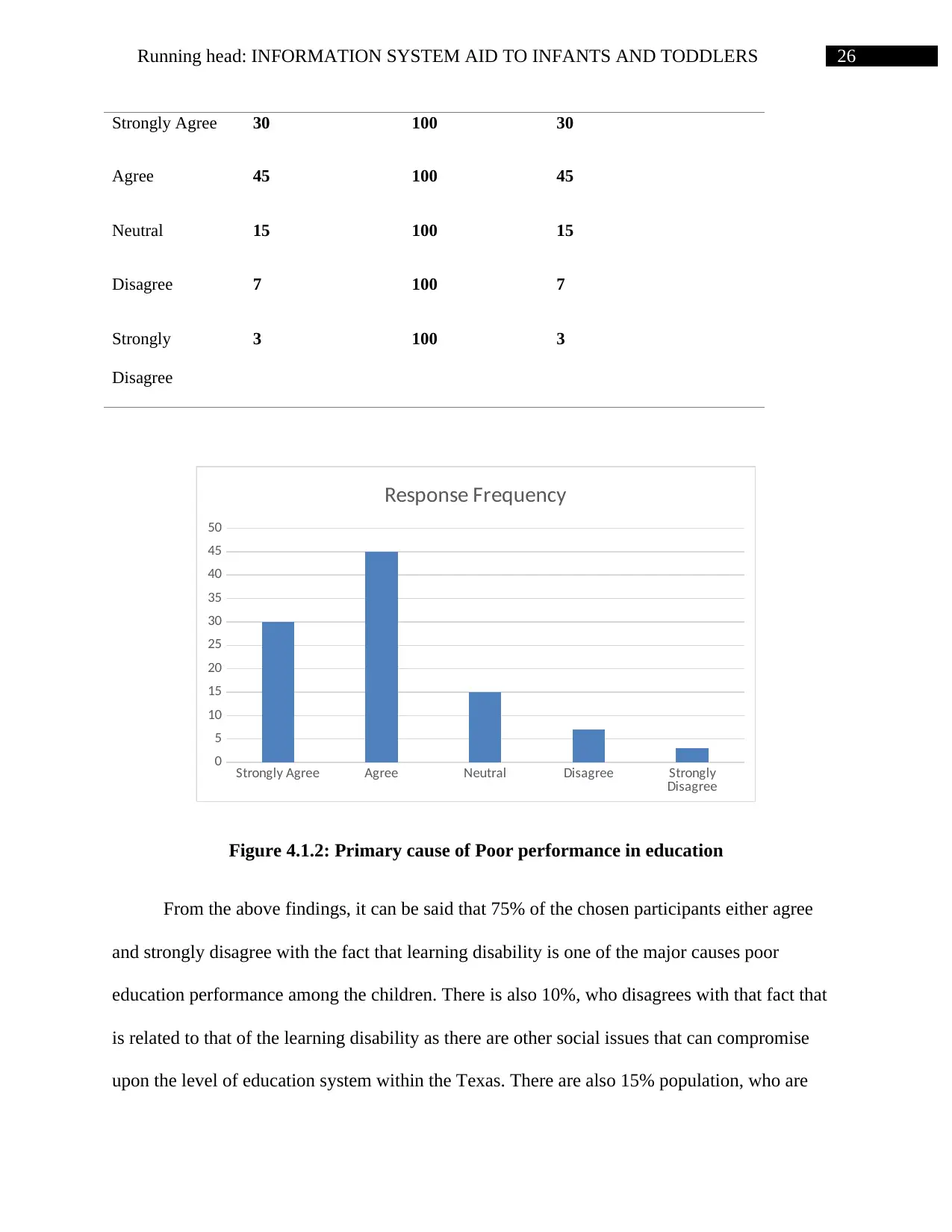
26Running head: INFORMATION SYSTEM AID TO INFANTS AND TODDLERS
Strongly Agree 30 100 30
Agree 45 100 45
Neutral 15 100 15
Disagree 7 100 7
Strongly
Disagree
3 100 3
Strongly Agree Agree Neutral Disagree Strongly
Disagree
0
5
10
15
20
25
30
35
40
45
50
Response Frequency
Figure 4.1.2: Primary cause of Poor performance in education
From the above findings, it can be said that 75% of the chosen participants either agree
and strongly disagree with the fact that learning disability is one of the major causes poor
education performance among the children. There is also 10%, who disagrees with that fact that
is related to that of the learning disability as there are other social issues that can compromise
upon the level of education system within the Texas. There are also 15% population, who are
Strongly Agree 30 100 30
Agree 45 100 45
Neutral 15 100 15
Disagree 7 100 7
Strongly
Disagree
3 100 3
Strongly Agree Agree Neutral Disagree Strongly
Disagree
0
5
10
15
20
25
30
35
40
45
50
Response Frequency
Figure 4.1.2: Primary cause of Poor performance in education
From the above findings, it can be said that 75% of the chosen participants either agree
and strongly disagree with the fact that learning disability is one of the major causes poor
education performance among the children. There is also 10%, who disagrees with that fact that
is related to that of the learning disability as there are other social issues that can compromise
upon the level of education system within the Texas. There are also 15% population, who are
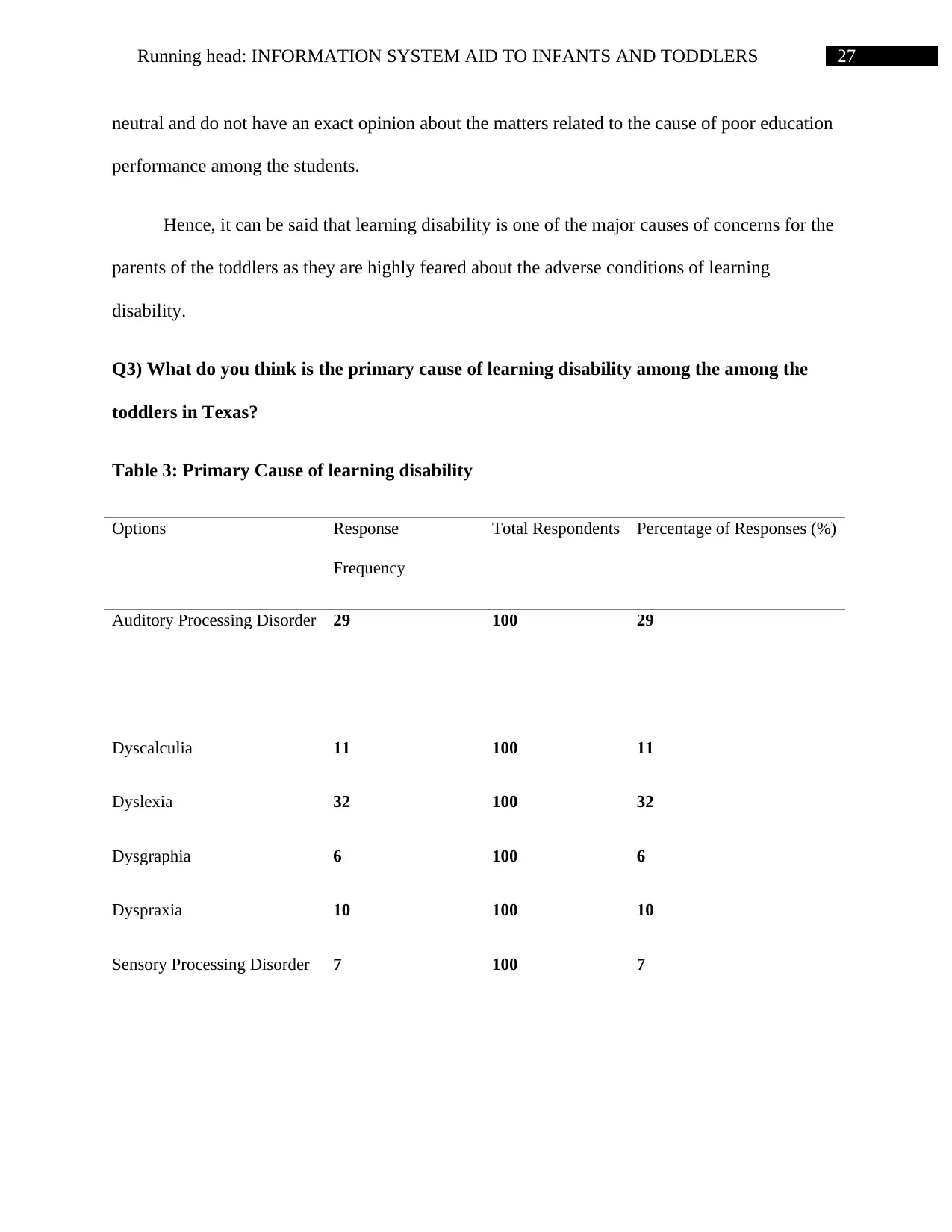
27Running head: INFORMATION SYSTEM AID TO INFANTS AND TODDLERS
neutral and do not have an exact opinion about the matters related to the cause of poor education
performance among the students.
Hence, it can be said that learning disability is one of the major causes of concerns for the
parents of the toddlers as they are highly feared about the adverse conditions of learning
disability.
Q3) What do you think is the primary cause of learning disability among the among the
toddlers in Texas?
Table 3: Primary Cause of learning disability
Options Response
Frequency
Total Respondents Percentage of Responses (%)
Auditory Processing Disorder 29 100 29
Dyscalculia 11 100 11
Dyslexia 32 100 32
Dysgraphia 6 100 6
Dyspraxia 10 100 10
Sensory Processing Disorder 7 100 7
neutral and do not have an exact opinion about the matters related to the cause of poor education
performance among the students.
Hence, it can be said that learning disability is one of the major causes of concerns for the
parents of the toddlers as they are highly feared about the adverse conditions of learning
disability.
Q3) What do you think is the primary cause of learning disability among the among the
toddlers in Texas?
Table 3: Primary Cause of learning disability
Options Response
Frequency
Total Respondents Percentage of Responses (%)
Auditory Processing Disorder 29 100 29
Dyscalculia 11 100 11
Dyslexia 32 100 32
Dysgraphia 6 100 6
Dyspraxia 10 100 10
Sensory Processing Disorder 7 100 7

28Running head: INFORMATION SYSTEM AID TO INFANTS AND TODDLERS
Visual Processing Disorder 5 100 5
Auditory
Processing
Disorder
Dyscalculia Dyslexia Dysgraphia Dyspraxia Sensory
Processing
Disorder
Visual
Processing
Disorder
0
5
10
15
20
25
30
35
Primary Cause of learning disability
Figure 4.1.3: Primary Cause of learning disability
There are seven different types of learning challenges that has been reported within the
toddlers and children in the areas of Texas. The purpose of the above questions is to identify the
most frequently occurring learning disability challenges that occur in Texas. From the collected
data it is clear that Dyslexia and auditory processing disorder are the primary causes of learning
disability as 32% and 29% of the participants have agreed with the fact from the survey. With a
response of just 5%, visual processing disorder is the least occurring cause for the disability
challenges. This is followed by Dysgraphia that was expressed by the opinion of 6% of the
participants. Then comes the case of sensory processing disorders of 7% and Dyscalculia of
11%.
Visual Processing Disorder 5 100 5
Auditory
Processing
Disorder
Dyscalculia Dyslexia Dysgraphia Dyspraxia Sensory
Processing
Disorder
Visual
Processing
Disorder
0
5
10
15
20
25
30
35
Primary Cause of learning disability
Figure 4.1.3: Primary Cause of learning disability
There are seven different types of learning challenges that has been reported within the
toddlers and children in the areas of Texas. The purpose of the above questions is to identify the
most frequently occurring learning disability challenges that occur in Texas. From the collected
data it is clear that Dyslexia and auditory processing disorder are the primary causes of learning
disability as 32% and 29% of the participants have agreed with the fact from the survey. With a
response of just 5%, visual processing disorder is the least occurring cause for the disability
challenges. This is followed by Dysgraphia that was expressed by the opinion of 6% of the
participants. Then comes the case of sensory processing disorders of 7% and Dyscalculia of
11%.
Secure Best Marks with AI Grader
Need help grading? Try our AI Grader for instant feedback on your assignments.
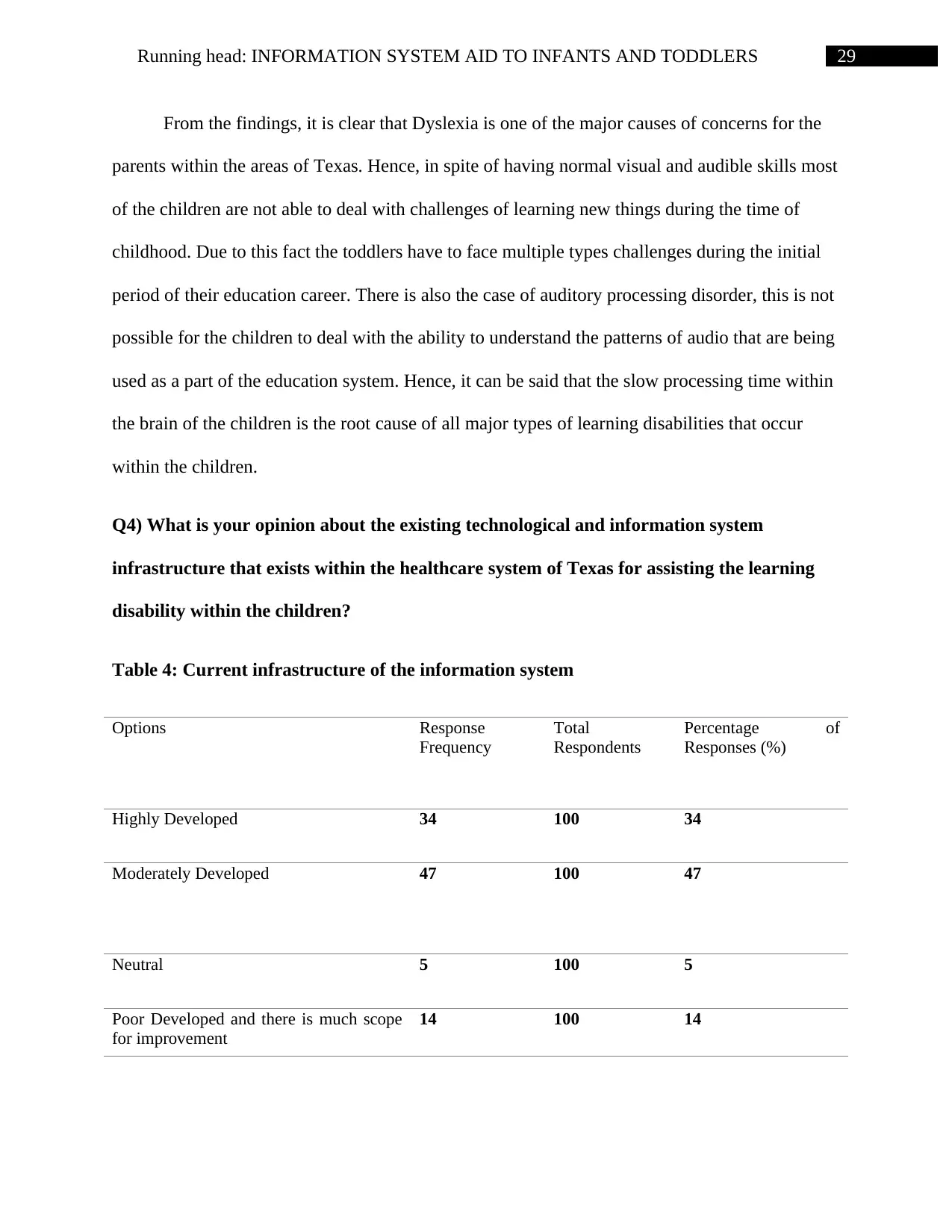
29Running head: INFORMATION SYSTEM AID TO INFANTS AND TODDLERS
From the findings, it is clear that Dyslexia is one of the major causes of concerns for the
parents within the areas of Texas. Hence, in spite of having normal visual and audible skills most
of the children are not able to deal with challenges of learning new things during the time of
childhood. Due to this fact the toddlers have to face multiple types challenges during the initial
period of their education career. There is also the case of auditory processing disorder, this is not
possible for the children to deal with the ability to understand the patterns of audio that are being
used as a part of the education system. Hence, it can be said that the slow processing time within
the brain of the children is the root cause of all major types of learning disabilities that occur
within the children.
Q4) What is your opinion about the existing technological and information system
infrastructure that exists within the healthcare system of Texas for assisting the learning
disability within the children?
Table 4: Current infrastructure of the information system
Options Response
Frequency
Total
Respondents
Percentage of
Responses (%)
Highly Developed 34 100 34
Moderately Developed 47 100 47
Neutral 5 100 5
Poor Developed and there is much scope
for improvement
14 100 14
From the findings, it is clear that Dyslexia is one of the major causes of concerns for the
parents within the areas of Texas. Hence, in spite of having normal visual and audible skills most
of the children are not able to deal with challenges of learning new things during the time of
childhood. Due to this fact the toddlers have to face multiple types challenges during the initial
period of their education career. There is also the case of auditory processing disorder, this is not
possible for the children to deal with the ability to understand the patterns of audio that are being
used as a part of the education system. Hence, it can be said that the slow processing time within
the brain of the children is the root cause of all major types of learning disabilities that occur
within the children.
Q4) What is your opinion about the existing technological and information system
infrastructure that exists within the healthcare system of Texas for assisting the learning
disability within the children?
Table 4: Current infrastructure of the information system
Options Response
Frequency
Total
Respondents
Percentage of
Responses (%)
Highly Developed 34 100 34
Moderately Developed 47 100 47
Neutral 5 100 5
Poor Developed and there is much scope
for improvement
14 100 14
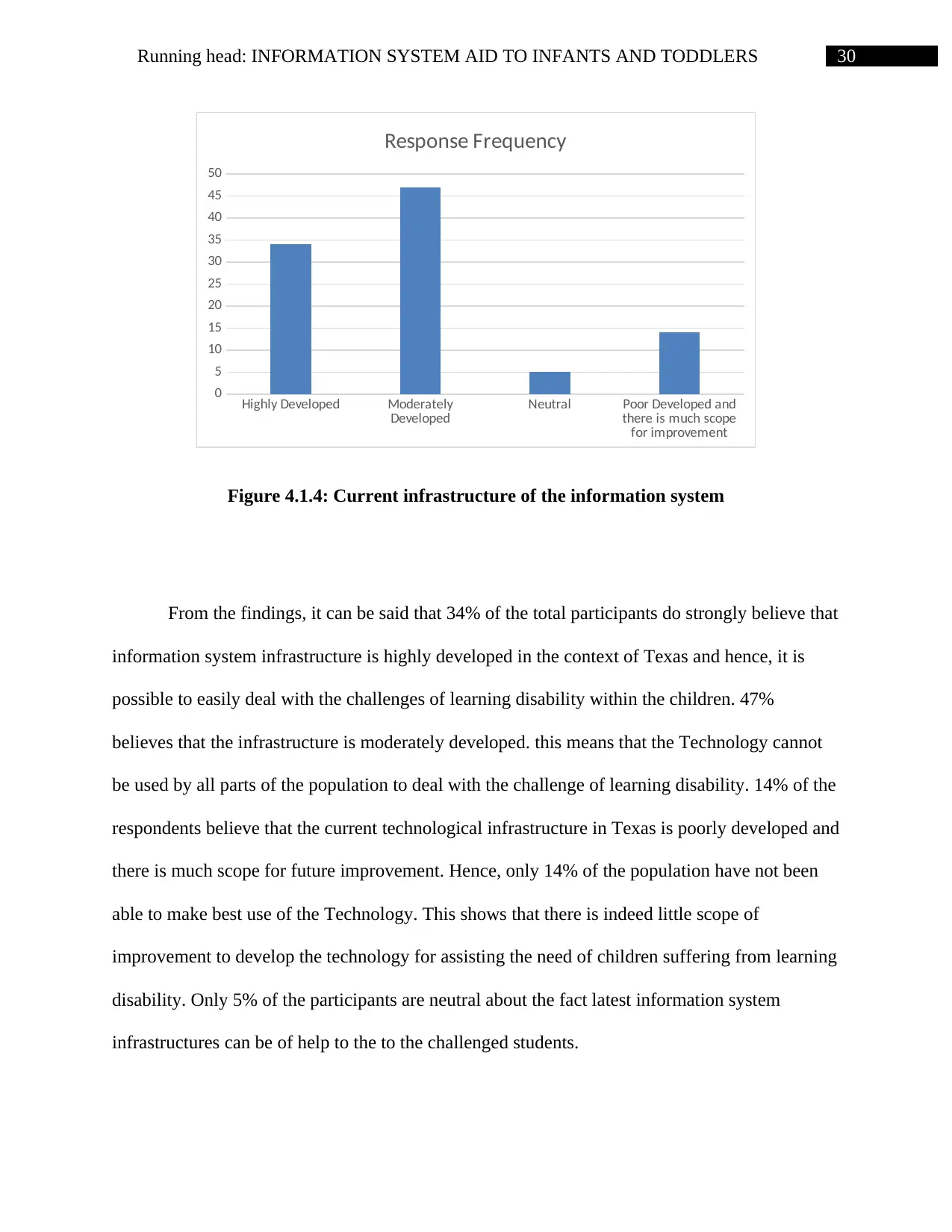
30Running head: INFORMATION SYSTEM AID TO INFANTS AND TODDLERS
Highly Developed Moderately
Developed Neutral Poor Developed and
there is much scope
for improvement
0
5
10
15
20
25
30
35
40
45
50
Response Frequency
Figure 4.1.4: Current infrastructure of the information system
From the findings, it can be said that 34% of the total participants do strongly believe that
information system infrastructure is highly developed in the context of Texas and hence, it is
possible to easily deal with the challenges of learning disability within the children. 47%
believes that the infrastructure is moderately developed. this means that the Technology cannot
be used by all parts of the population to deal with the challenge of learning disability. 14% of the
respondents believe that the current technological infrastructure in Texas is poorly developed and
there is much scope for future improvement. Hence, only 14% of the population have not been
able to make best use of the Technology. This shows that there is indeed little scope of
improvement to develop the technology for assisting the need of children suffering from learning
disability. Only 5% of the participants are neutral about the fact latest information system
infrastructures can be of help to the to the challenged students.
Highly Developed Moderately
Developed Neutral Poor Developed and
there is much scope
for improvement
0
5
10
15
20
25
30
35
40
45
50
Response Frequency
Figure 4.1.4: Current infrastructure of the information system
From the findings, it can be said that 34% of the total participants do strongly believe that
information system infrastructure is highly developed in the context of Texas and hence, it is
possible to easily deal with the challenges of learning disability within the children. 47%
believes that the infrastructure is moderately developed. this means that the Technology cannot
be used by all parts of the population to deal with the challenge of learning disability. 14% of the
respondents believe that the current technological infrastructure in Texas is poorly developed and
there is much scope for future improvement. Hence, only 14% of the population have not been
able to make best use of the Technology. This shows that there is indeed little scope of
improvement to develop the technology for assisting the need of children suffering from learning
disability. Only 5% of the participants are neutral about the fact latest information system
infrastructures can be of help to the to the challenged students.
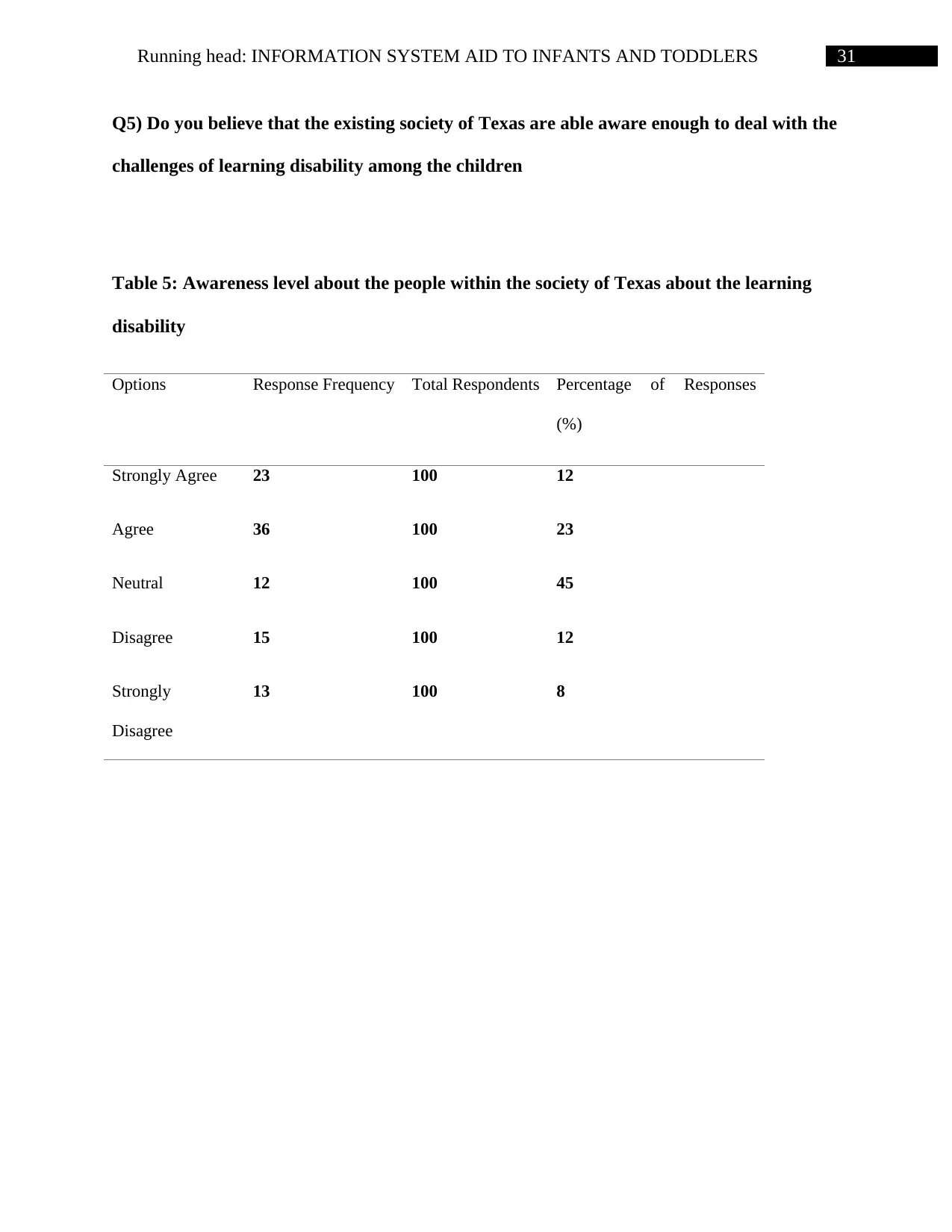
31Running head: INFORMATION SYSTEM AID TO INFANTS AND TODDLERS
Q5) Do you believe that the existing society of Texas are able aware enough to deal with the
challenges of learning disability among the children
Table 5: Awareness level about the people within the society of Texas about the learning
disability
Options Response Frequency Total Respondents Percentage of Responses
(%)
Strongly Agree 23 100 12
Agree 36 100 23
Neutral 12 100 45
Disagree 15 100 12
Strongly
Disagree
13 100 8
Q5) Do you believe that the existing society of Texas are able aware enough to deal with the
challenges of learning disability among the children
Table 5: Awareness level about the people within the society of Texas about the learning
disability
Options Response Frequency Total Respondents Percentage of Responses
(%)
Strongly Agree 23 100 12
Agree 36 100 23
Neutral 12 100 45
Disagree 15 100 12
Strongly
Disagree
13 100 8
Paraphrase This Document
Need a fresh take? Get an instant paraphrase of this document with our AI Paraphraser
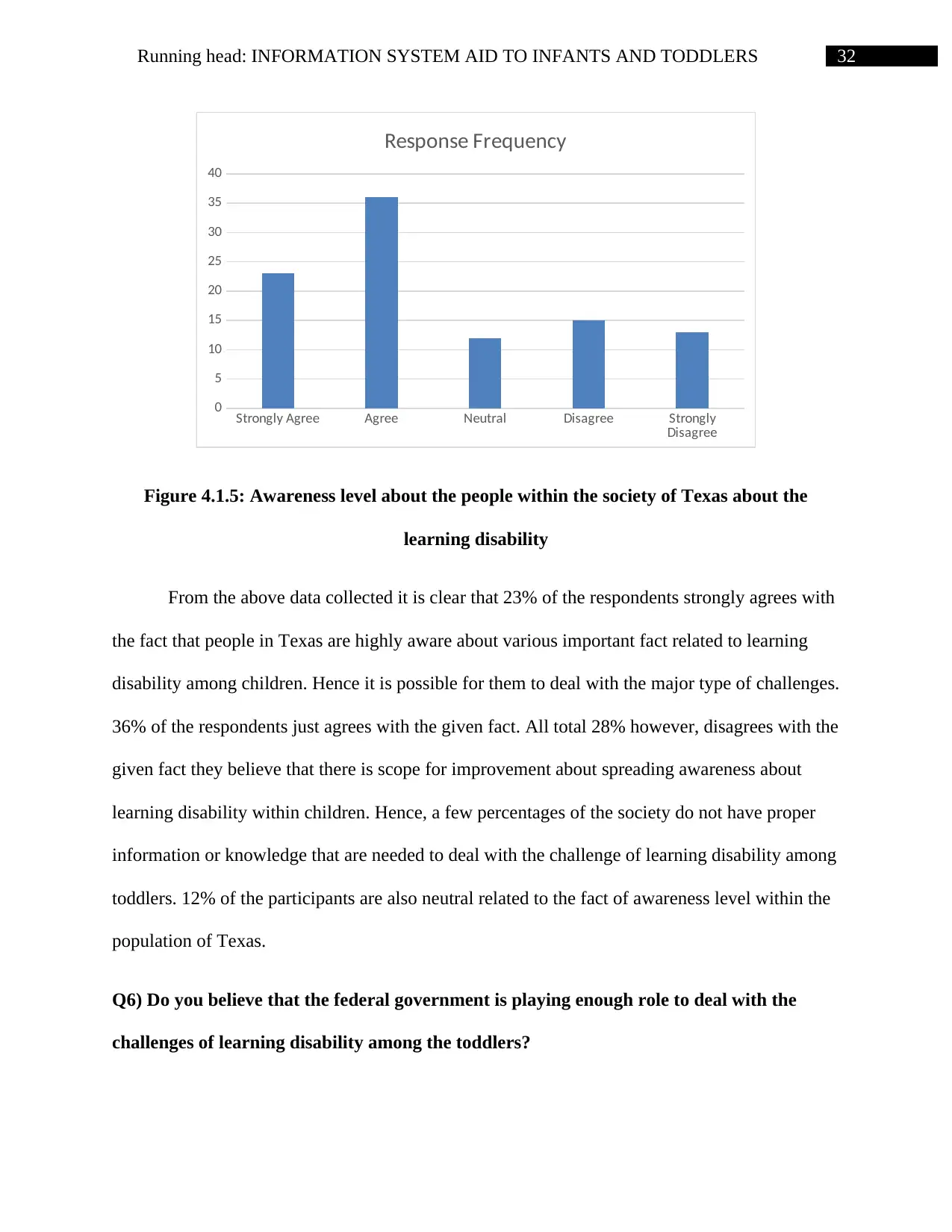
32Running head: INFORMATION SYSTEM AID TO INFANTS AND TODDLERS
Strongly Agree Agree Neutral Disagree Strongly
Disagree
0
5
10
15
20
25
30
35
40
Response Frequency
Figure 4.1.5: Awareness level about the people within the society of Texas about the
learning disability
From the above data collected it is clear that 23% of the respondents strongly agrees with
the fact that people in Texas are highly aware about various important fact related to learning
disability among children. Hence it is possible for them to deal with the major type of challenges.
36% of the respondents just agrees with the given fact. All total 28% however, disagrees with the
given fact they believe that there is scope for improvement about spreading awareness about
learning disability within children. Hence, a few percentages of the society do not have proper
information or knowledge that are needed to deal with the challenge of learning disability among
toddlers. 12% of the participants are also neutral related to the fact of awareness level within the
population of Texas.
Q6) Do you believe that the federal government is playing enough role to deal with the
challenges of learning disability among the toddlers?
Strongly Agree Agree Neutral Disagree Strongly
Disagree
0
5
10
15
20
25
30
35
40
Response Frequency
Figure 4.1.5: Awareness level about the people within the society of Texas about the
learning disability
From the above data collected it is clear that 23% of the respondents strongly agrees with
the fact that people in Texas are highly aware about various important fact related to learning
disability among children. Hence it is possible for them to deal with the major type of challenges.
36% of the respondents just agrees with the given fact. All total 28% however, disagrees with the
given fact they believe that there is scope for improvement about spreading awareness about
learning disability within children. Hence, a few percentages of the society do not have proper
information or knowledge that are needed to deal with the challenge of learning disability among
toddlers. 12% of the participants are also neutral related to the fact of awareness level within the
population of Texas.
Q6) Do you believe that the federal government is playing enough role to deal with the
challenges of learning disability among the toddlers?
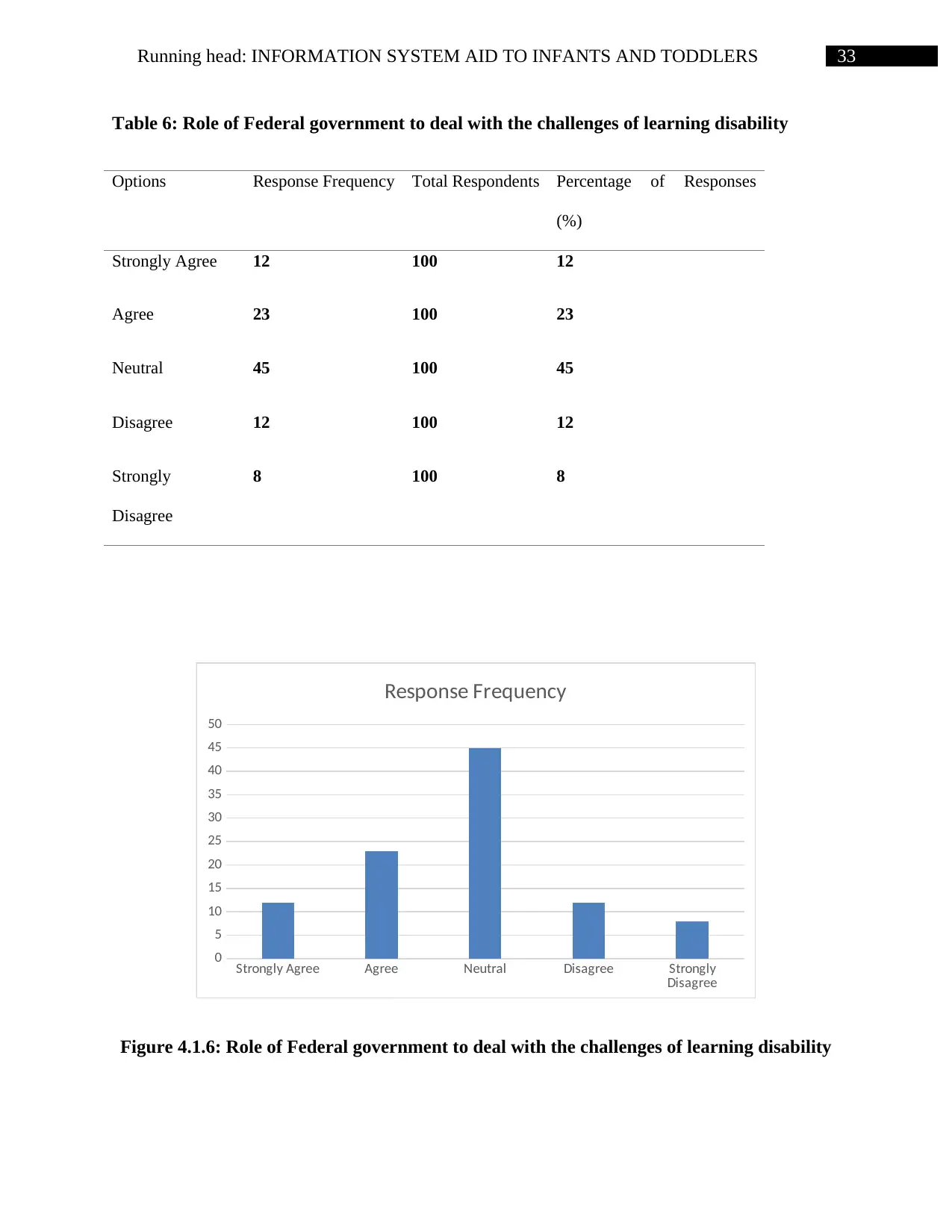
33Running head: INFORMATION SYSTEM AID TO INFANTS AND TODDLERS
Table 6: Role of Federal government to deal with the challenges of learning disability
Options Response Frequency Total Respondents Percentage of Responses
(%)
Strongly Agree 12 100 12
Agree 23 100 23
Neutral 45 100 45
Disagree 12 100 12
Strongly
Disagree
8 100 8
Strongly Agree Agree Neutral Disagree Strongly
Disagree
0
5
10
15
20
25
30
35
40
45
50
Response Frequency
Figure 4.1.6: Role of Federal government to deal with the challenges of learning disability
Table 6: Role of Federal government to deal with the challenges of learning disability
Options Response Frequency Total Respondents Percentage of Responses
(%)
Strongly Agree 12 100 12
Agree 23 100 23
Neutral 45 100 45
Disagree 12 100 12
Strongly
Disagree
8 100 8
Strongly Agree Agree Neutral Disagree Strongly
Disagree
0
5
10
15
20
25
30
35
40
45
50
Response Frequency
Figure 4.1.6: Role of Federal government to deal with the challenges of learning disability

34Running head: INFORMATION SYSTEM AID TO INFANTS AND TODDLERS
From the collected data it is clear that 45% of the participants are neutral about the
related to the role of Federal government to initiate policies to deal with the challenge of learning
disability among children. This clearly shows that the role of government in the following cases
not clear to a greater part of the population in Texas. Only 35% of the population agrees about
the fact that the government is playing a major role in dealing with the challenge of learning
disability. Rest is 20% of the population do not agree about the role played by the government
has helped to deal with the challenge of learning disability within children.
Q7) Do you believe that the psychological theories and models can be implicated in the
context dealing with the challenges of learning disability within children?
Table 7: Use of psychological theories to deal with learning disability
Options Response Frequency Total Respondents Percentage of Responses
(%)
Strongly Agree 12 100 12
Agree 15 100 15
Neutral 24 100 24
Disagree 30 100 30
Strongly
Disagree
19 100 19
From the collected data it is clear that 45% of the participants are neutral about the
related to the role of Federal government to initiate policies to deal with the challenge of learning
disability among children. This clearly shows that the role of government in the following cases
not clear to a greater part of the population in Texas. Only 35% of the population agrees about
the fact that the government is playing a major role in dealing with the challenge of learning
disability. Rest is 20% of the population do not agree about the role played by the government
has helped to deal with the challenge of learning disability within children.
Q7) Do you believe that the psychological theories and models can be implicated in the
context dealing with the challenges of learning disability within children?
Table 7: Use of psychological theories to deal with learning disability
Options Response Frequency Total Respondents Percentage of Responses
(%)
Strongly Agree 12 100 12
Agree 15 100 15
Neutral 24 100 24
Disagree 30 100 30
Strongly
Disagree
19 100 19
Secure Best Marks with AI Grader
Need help grading? Try our AI Grader for instant feedback on your assignments.
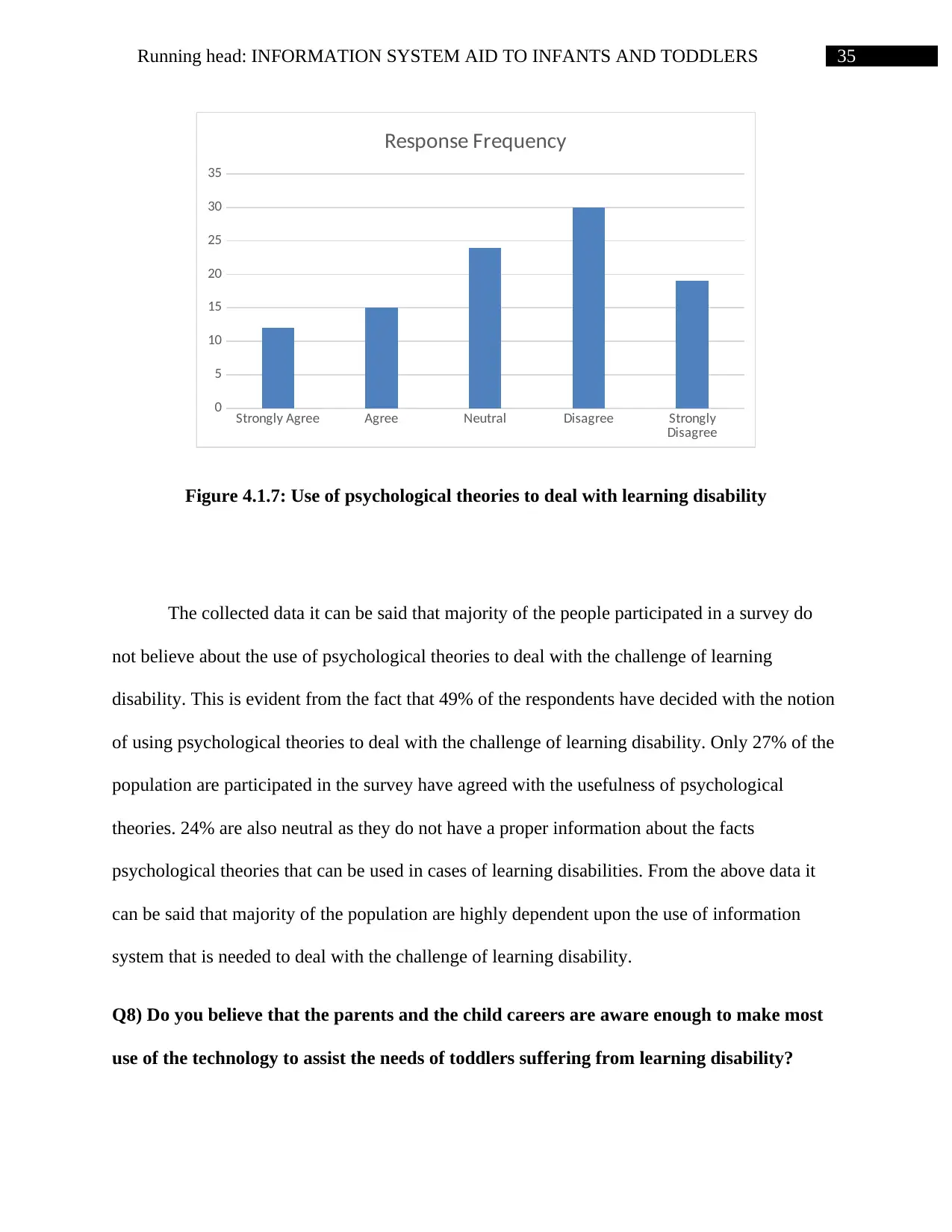
35Running head: INFORMATION SYSTEM AID TO INFANTS AND TODDLERS
Strongly Agree Agree Neutral Disagree Strongly
Disagree
0
5
10
15
20
25
30
35
Response Frequency
Figure 4.1.7: Use of psychological theories to deal with learning disability
The collected data it can be said that majority of the people participated in a survey do
not believe about the use of psychological theories to deal with the challenge of learning
disability. This is evident from the fact that 49% of the respondents have decided with the notion
of using psychological theories to deal with the challenge of learning disability. Only 27% of the
population are participated in the survey have agreed with the usefulness of psychological
theories. 24% are also neutral as they do not have a proper information about the facts
psychological theories that can be used in cases of learning disabilities. From the above data it
can be said that majority of the population are highly dependent upon the use of information
system that is needed to deal with the challenge of learning disability.
Q8) Do you believe that the parents and the child careers are aware enough to make most
use of the technology to assist the needs of toddlers suffering from learning disability?
Strongly Agree Agree Neutral Disagree Strongly
Disagree
0
5
10
15
20
25
30
35
Response Frequency
Figure 4.1.7: Use of psychological theories to deal with learning disability
The collected data it can be said that majority of the people participated in a survey do
not believe about the use of psychological theories to deal with the challenge of learning
disability. This is evident from the fact that 49% of the respondents have decided with the notion
of using psychological theories to deal with the challenge of learning disability. Only 27% of the
population are participated in the survey have agreed with the usefulness of psychological
theories. 24% are also neutral as they do not have a proper information about the facts
psychological theories that can be used in cases of learning disabilities. From the above data it
can be said that majority of the population are highly dependent upon the use of information
system that is needed to deal with the challenge of learning disability.
Q8) Do you believe that the parents and the child careers are aware enough to make most
use of the technology to assist the needs of toddlers suffering from learning disability?
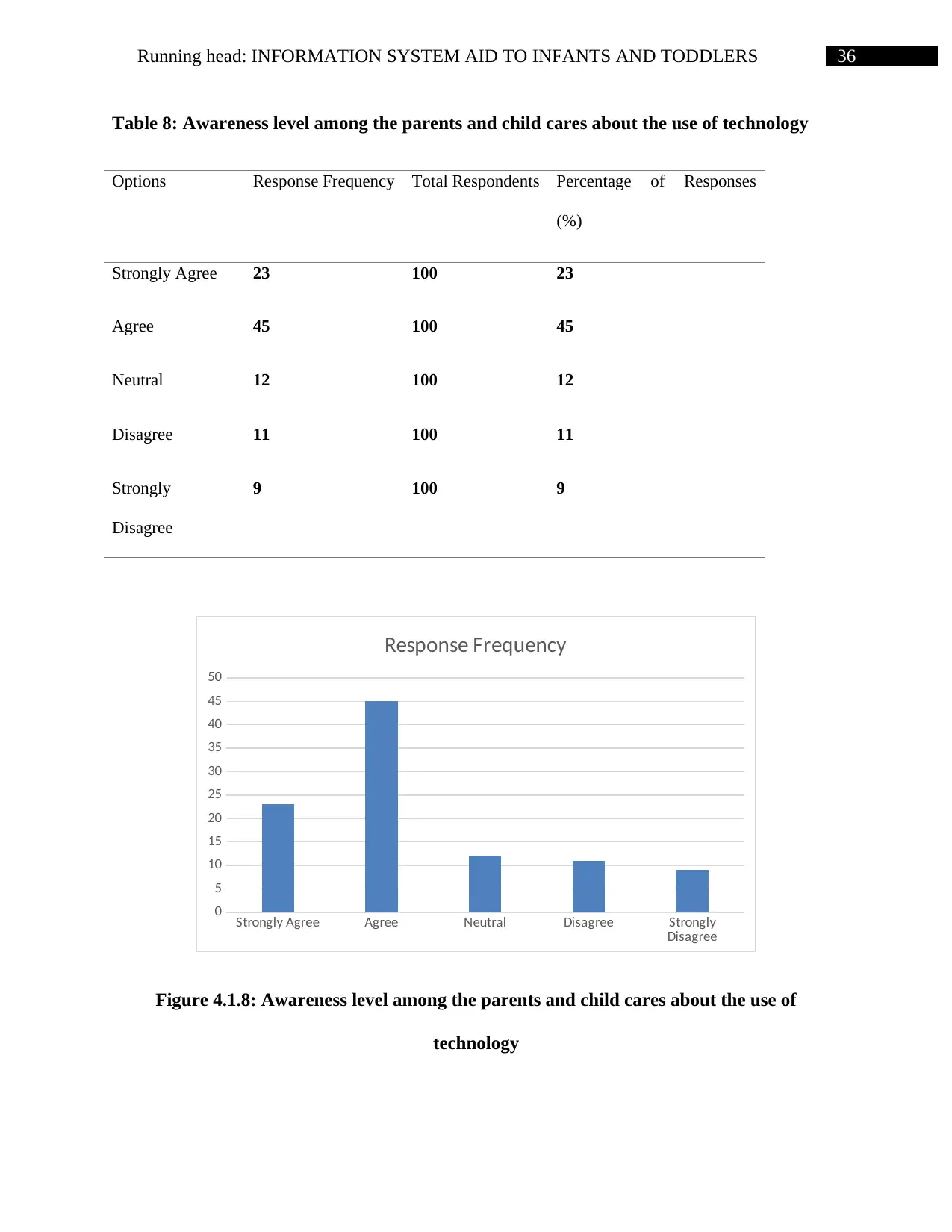
36Running head: INFORMATION SYSTEM AID TO INFANTS AND TODDLERS
Table 8: Awareness level among the parents and child cares about the use of technology
Options Response Frequency Total Respondents Percentage of Responses
(%)
Strongly Agree 23 100 23
Agree 45 100 45
Neutral 12 100 12
Disagree 11 100 11
Strongly
Disagree
9 100 9
Strongly Agree Agree Neutral Disagree Strongly
Disagree
0
5
10
15
20
25
30
35
40
45
50
Response Frequency
Figure 4.1.8: Awareness level among the parents and child cares about the use of
technology
Table 8: Awareness level among the parents and child cares about the use of technology
Options Response Frequency Total Respondents Percentage of Responses
(%)
Strongly Agree 23 100 23
Agree 45 100 45
Neutral 12 100 12
Disagree 11 100 11
Strongly
Disagree
9 100 9
Strongly Agree Agree Neutral Disagree Strongly
Disagree
0
5
10
15
20
25
30
35
40
45
50
Response Frequency
Figure 4.1.8: Awareness level among the parents and child cares about the use of
technology

37Running head: INFORMATION SYSTEM AID TO INFANTS AND TODDLERS
From the above collected data it is clear that the use of technology any information
system is very common among the parents and caregivers, who have to deal with children
suffering from learning disabilities learning disabilities. This is also one of the 68% of the
participants have agreed about the fact that caregivers and parents have been able to make the
best use of the technology to deal with the challenges and assist the needs of the children, who
are suffering from the symptoms of learning disability. Only 20% of the population have
disagreed about the fact related to use of technology for assisting the need of learning disabled
children. There are 12% of the population, who are neutral about the use of Technology. This
group of people are dependent upon other sources to assist the need of children suffering from
learning disability.
From the above collected data it is clear that the use of technology any information
system is very common among the parents and caregivers, who have to deal with children
suffering from learning disabilities learning disabilities. This is also one of the 68% of the
participants have agreed about the fact that caregivers and parents have been able to make the
best use of the technology to deal with the challenges and assist the needs of the children, who
are suffering from the symptoms of learning disability. Only 20% of the population have
disagreed about the fact related to use of technology for assisting the need of learning disabled
children. There are 12% of the population, who are neutral about the use of Technology. This
group of people are dependent upon other sources to assist the need of children suffering from
learning disability.
Paraphrase This Document
Need a fresh take? Get an instant paraphrase of this document with our AI Paraphraser

38Running head: INFORMATION SYSTEM AID TO INFANTS AND TODDLERS
4.2 Inferential Analysis
4.2 Inferential Analysis
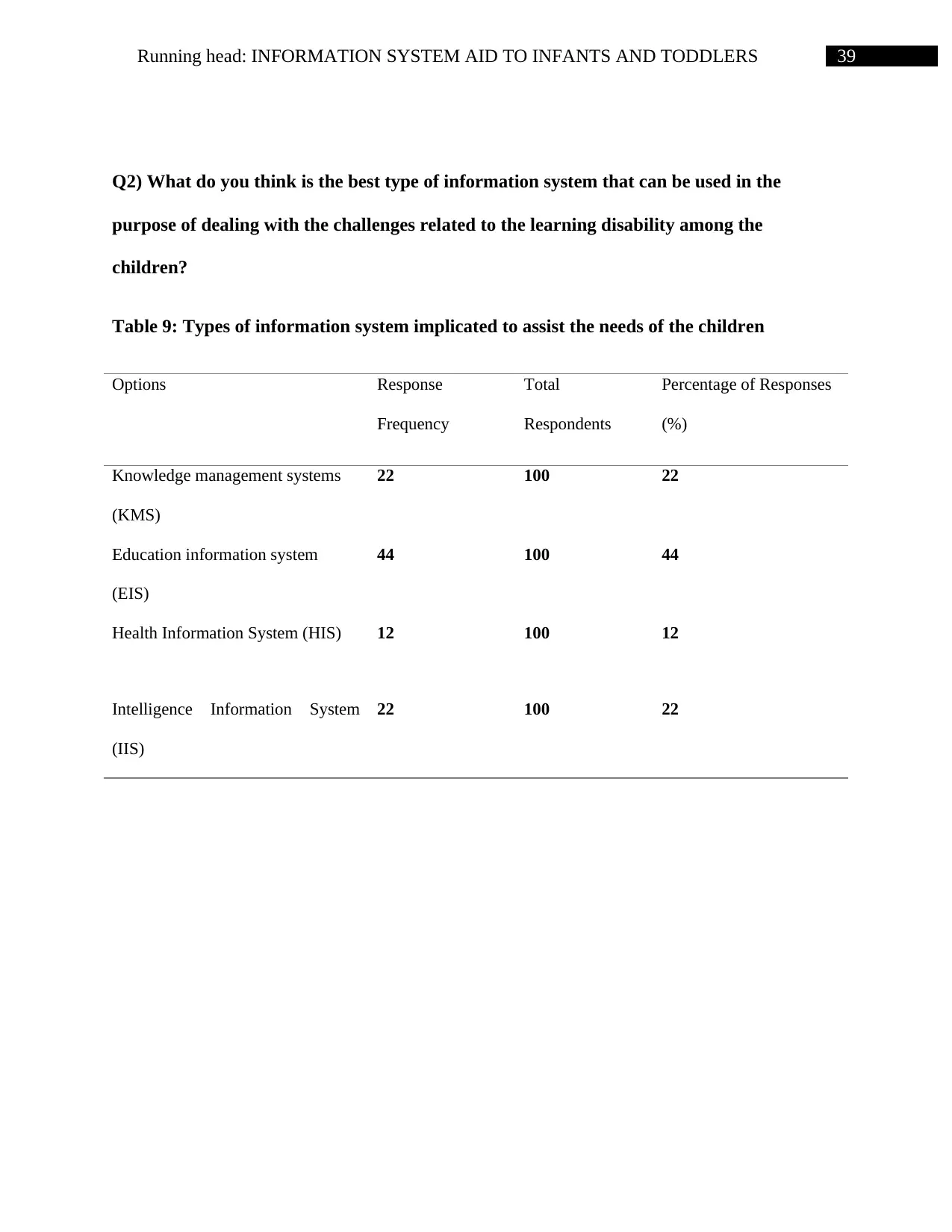
39Running head: INFORMATION SYSTEM AID TO INFANTS AND TODDLERS
Q2) What do you think is the best type of information system that can be used in the
purpose of dealing with the challenges related to the learning disability among the
children?
Table 9: Types of information system implicated to assist the needs of the children
Options Response
Frequency
Total
Respondents
Percentage of Responses
(%)
Knowledge management systems
(KMS)
22 100 22
Education information system
(EIS)
44 100 44
Health Information System (HIS) 12 100 12
Intelligence Information System
(IIS)
22 100 22
Q2) What do you think is the best type of information system that can be used in the
purpose of dealing with the challenges related to the learning disability among the
children?
Table 9: Types of information system implicated to assist the needs of the children
Options Response
Frequency
Total
Respondents
Percentage of Responses
(%)
Knowledge management systems
(KMS)
22 100 22
Education information system
(EIS)
44 100 44
Health Information System (HIS) 12 100 12
Intelligence Information System
(IIS)
22 100 22
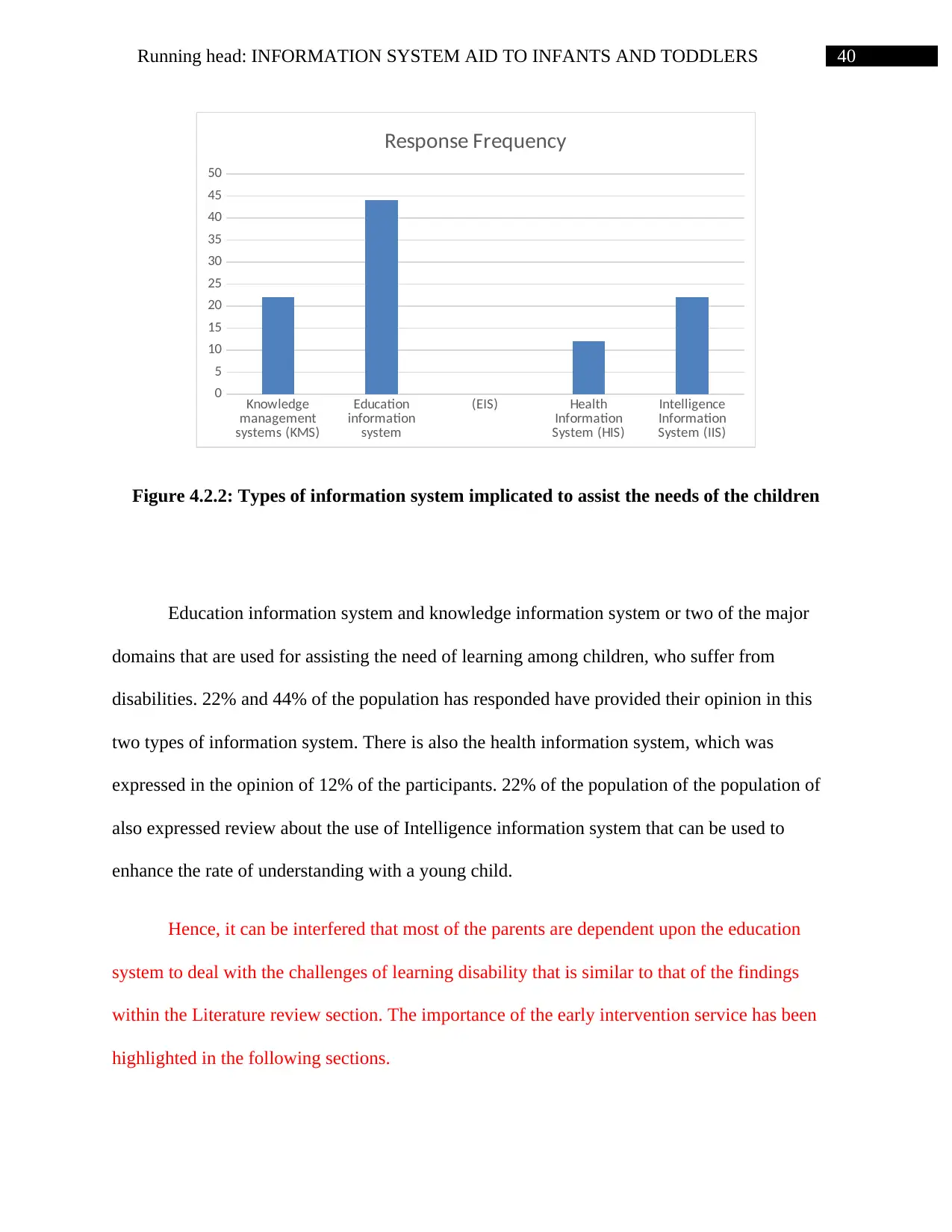
40Running head: INFORMATION SYSTEM AID TO INFANTS AND TODDLERS
Knowledge
management
systems (KMS)
Education
information
system
(EIS) Health
Information
System (HIS)
Intelligence
Information
System (IIS)
0
5
10
15
20
25
30
35
40
45
50
Response Frequency
Figure 4.2.2: Types of information system implicated to assist the needs of the children
Education information system and knowledge information system or two of the major
domains that are used for assisting the need of learning among children, who suffer from
disabilities. 22% and 44% of the population has responded have provided their opinion in this
two types of information system. There is also the health information system, which was
expressed in the opinion of 12% of the participants. 22% of the population of the population of
also expressed review about the use of Intelligence information system that can be used to
enhance the rate of understanding with a young child.
Hence, it can be interfered that most of the parents are dependent upon the education
system to deal with the challenges of learning disability that is similar to that of the findings
within the Literature review section. The importance of the early intervention service has been
highlighted in the following sections.
Knowledge
management
systems (KMS)
Education
information
system
(EIS) Health
Information
System (HIS)
Intelligence
Information
System (IIS)
0
5
10
15
20
25
30
35
40
45
50
Response Frequency
Figure 4.2.2: Types of information system implicated to assist the needs of the children
Education information system and knowledge information system or two of the major
domains that are used for assisting the need of learning among children, who suffer from
disabilities. 22% and 44% of the population has responded have provided their opinion in this
two types of information system. There is also the health information system, which was
expressed in the opinion of 12% of the participants. 22% of the population of the population of
also expressed review about the use of Intelligence information system that can be used to
enhance the rate of understanding with a young child.
Hence, it can be interfered that most of the parents are dependent upon the education
system to deal with the challenges of learning disability that is similar to that of the findings
within the Literature review section. The importance of the early intervention service has been
highlighted in the following sections.
Secure Best Marks with AI Grader
Need help grading? Try our AI Grader for instant feedback on your assignments.
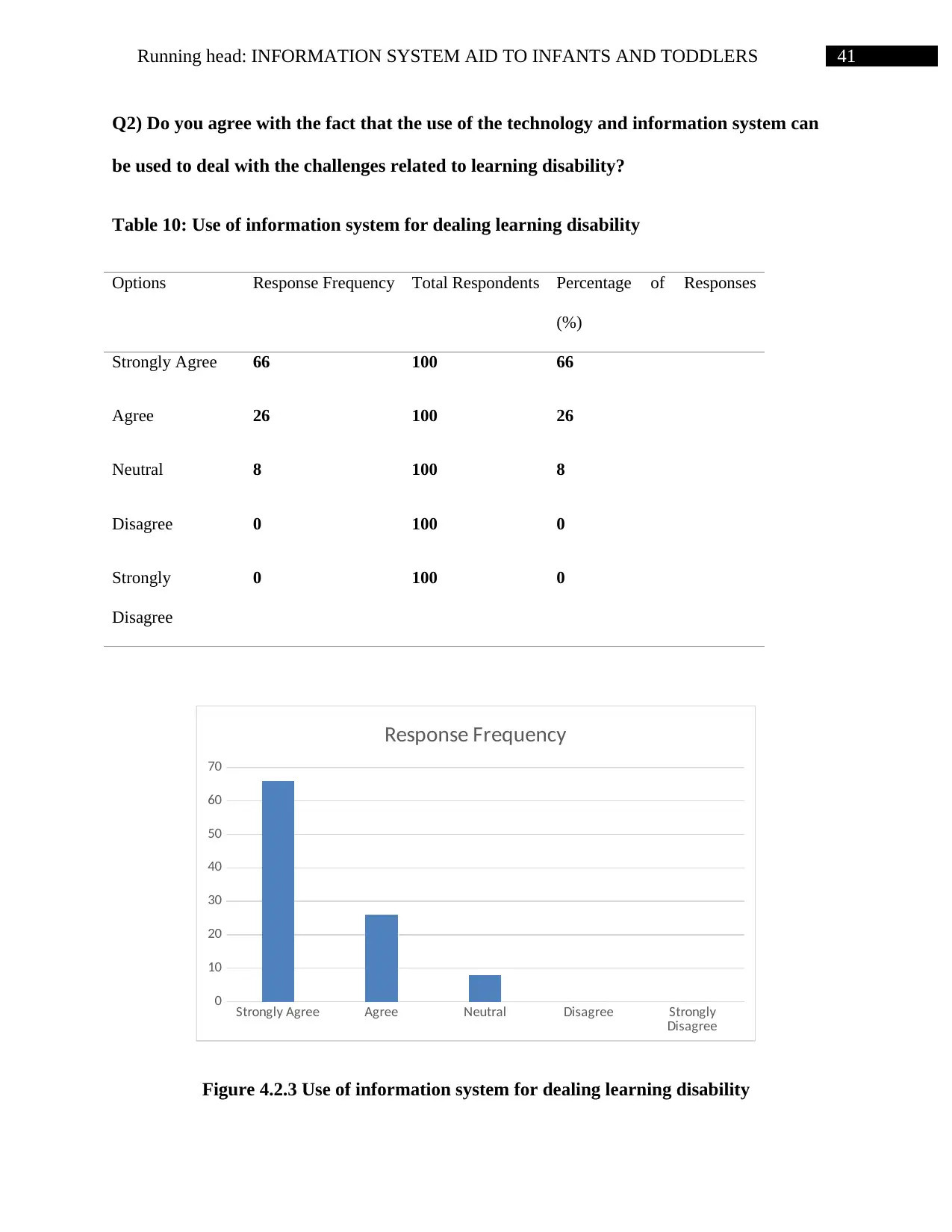
41Running head: INFORMATION SYSTEM AID TO INFANTS AND TODDLERS
Q2) Do you agree with the fact that the use of the technology and information system can
be used to deal with the challenges related to learning disability?
Table 10: Use of information system for dealing learning disability
Options Response Frequency Total Respondents Percentage of Responses
(%)
Strongly Agree 66 100 66
Agree 26 100 26
Neutral 8 100 8
Disagree 0 100 0
Strongly
Disagree
0 100 0
Strongly Agree Agree Neutral Disagree Strongly
Disagree
0
10
20
30
40
50
60
70
Response Frequency
Figure 4.2.3 Use of information system for dealing learning disability
Q2) Do you agree with the fact that the use of the technology and information system can
be used to deal with the challenges related to learning disability?
Table 10: Use of information system for dealing learning disability
Options Response Frequency Total Respondents Percentage of Responses
(%)
Strongly Agree 66 100 66
Agree 26 100 26
Neutral 8 100 8
Disagree 0 100 0
Strongly
Disagree
0 100 0
Strongly Agree Agree Neutral Disagree Strongly
Disagree
0
10
20
30
40
50
60
70
Response Frequency
Figure 4.2.3 Use of information system for dealing learning disability
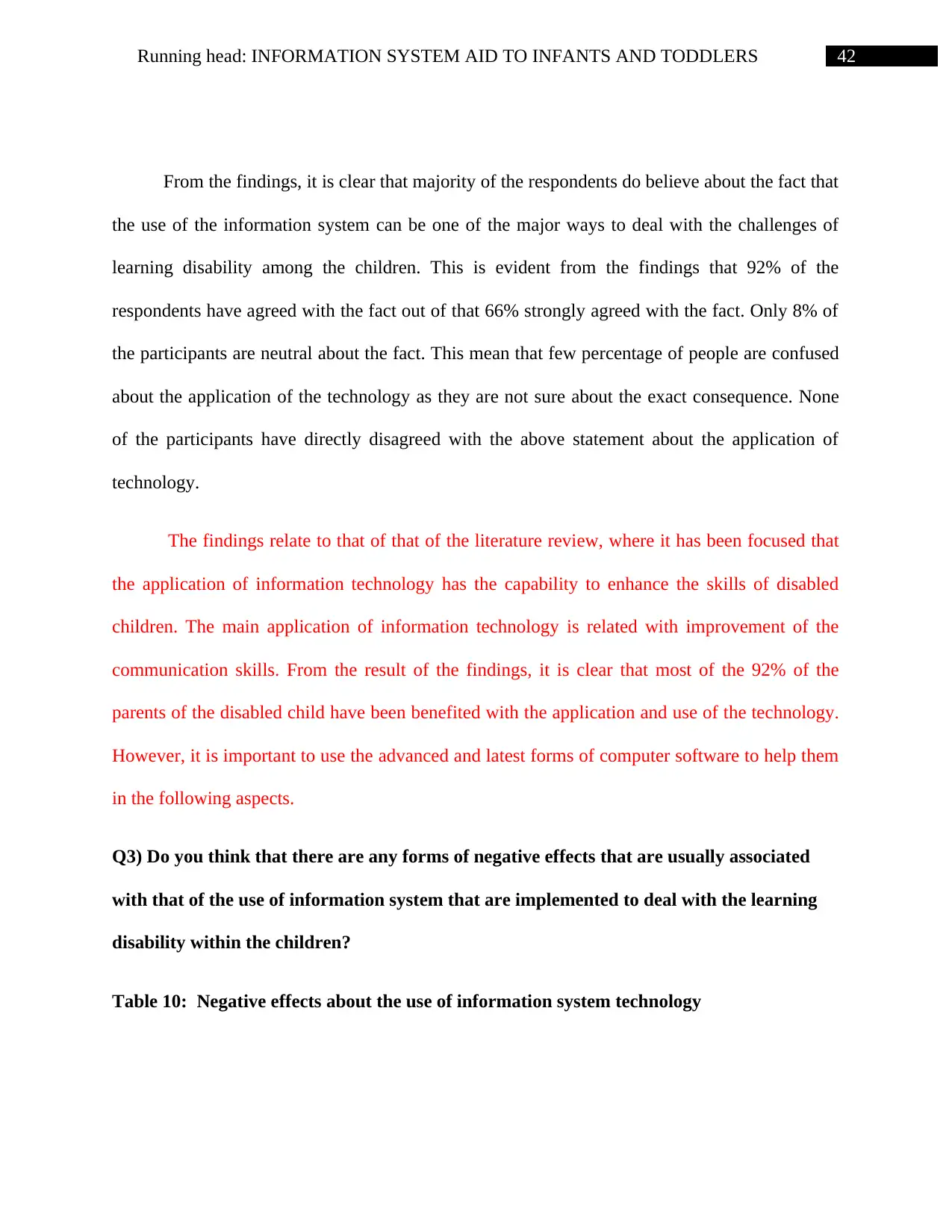
42Running head: INFORMATION SYSTEM AID TO INFANTS AND TODDLERS
From the findings, it is clear that majority of the respondents do believe about the fact that
the use of the information system can be one of the major ways to deal with the challenges of
learning disability among the children. This is evident from the findings that 92% of the
respondents have agreed with the fact out of that 66% strongly agreed with the fact. Only 8% of
the participants are neutral about the fact. This mean that few percentage of people are confused
about the application of the technology as they are not sure about the exact consequence. None
of the participants have directly disagreed with the above statement about the application of
technology.
The findings relate to that of that of the literature review, where it has been focused that
the application of information technology has the capability to enhance the skills of disabled
children. The main application of information technology is related with improvement of the
communication skills. From the result of the findings, it is clear that most of the 92% of the
parents of the disabled child have been benefited with the application and use of the technology.
However, it is important to use the advanced and latest forms of computer software to help them
in the following aspects.
Q3) Do you think that there are any forms of negative effects that are usually associated
with that of the use of information system that are implemented to deal with the learning
disability within the children?
Table 10: Negative effects about the use of information system technology
From the findings, it is clear that majority of the respondents do believe about the fact that
the use of the information system can be one of the major ways to deal with the challenges of
learning disability among the children. This is evident from the findings that 92% of the
respondents have agreed with the fact out of that 66% strongly agreed with the fact. Only 8% of
the participants are neutral about the fact. This mean that few percentage of people are confused
about the application of the technology as they are not sure about the exact consequence. None
of the participants have directly disagreed with the above statement about the application of
technology.
The findings relate to that of that of the literature review, where it has been focused that
the application of information technology has the capability to enhance the skills of disabled
children. The main application of information technology is related with improvement of the
communication skills. From the result of the findings, it is clear that most of the 92% of the
parents of the disabled child have been benefited with the application and use of the technology.
However, it is important to use the advanced and latest forms of computer software to help them
in the following aspects.
Q3) Do you think that there are any forms of negative effects that are usually associated
with that of the use of information system that are implemented to deal with the learning
disability within the children?
Table 10: Negative effects about the use of information system technology
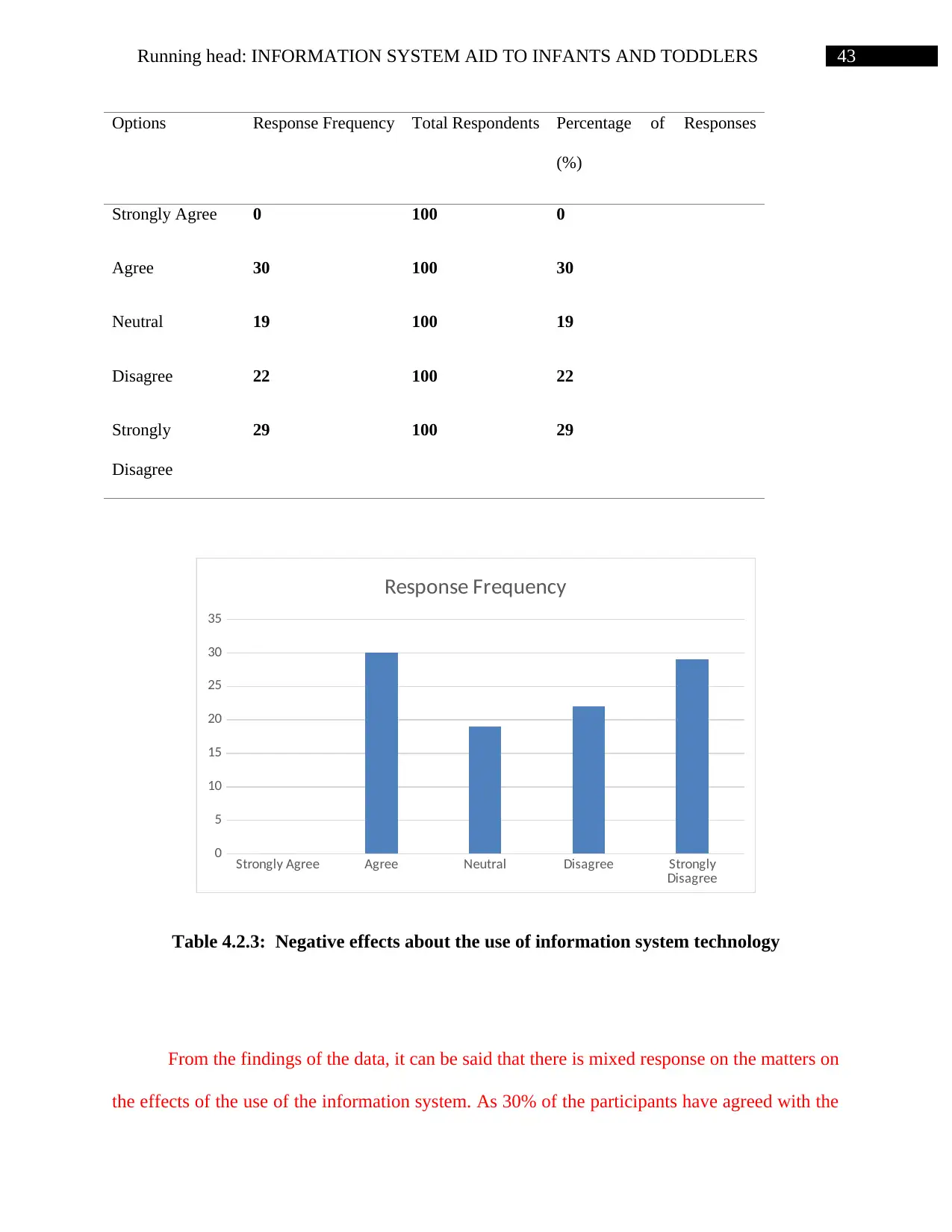
43Running head: INFORMATION SYSTEM AID TO INFANTS AND TODDLERS
Options Response Frequency Total Respondents Percentage of Responses
(%)
Strongly Agree 0 100 0
Agree 30 100 30
Neutral 19 100 19
Disagree 22 100 22
Strongly
Disagree
29 100 29
Strongly Agree Agree Neutral Disagree Strongly
Disagree
0
5
10
15
20
25
30
35
Response Frequency
Table 4.2.3: Negative effects about the use of information system technology
From the findings of the data, it can be said that there is mixed response on the matters on
the effects of the use of the information system. As 30% of the participants have agreed with the
Options Response Frequency Total Respondents Percentage of Responses
(%)
Strongly Agree 0 100 0
Agree 30 100 30
Neutral 19 100 19
Disagree 22 100 22
Strongly
Disagree
29 100 29
Strongly Agree Agree Neutral Disagree Strongly
Disagree
0
5
10
15
20
25
30
35
Response Frequency
Table 4.2.3: Negative effects about the use of information system technology
From the findings of the data, it can be said that there is mixed response on the matters on
the effects of the use of the information system. As 30% of the participants have agreed with the
Paraphrase This Document
Need a fresh take? Get an instant paraphrase of this document with our AI Paraphraser

44Running head: INFORMATION SYSTEM AID TO INFANTS AND TODDLERS
negative impact, it can be inferred from the fact that wide range of the audience have not been
benefited with the same. The past studies related to the given subject has not highlighted upon
the negative impact of the same. Hence, from the result of the above analysis, it is clear that most
of the negative effects also needs to be addressed.
negative impact, it can be inferred from the fact that wide range of the audience have not been
benefited with the same. The past studies related to the given subject has not highlighted upon
the negative impact of the same. Hence, from the result of the above analysis, it is clear that most
of the negative effects also needs to be addressed.
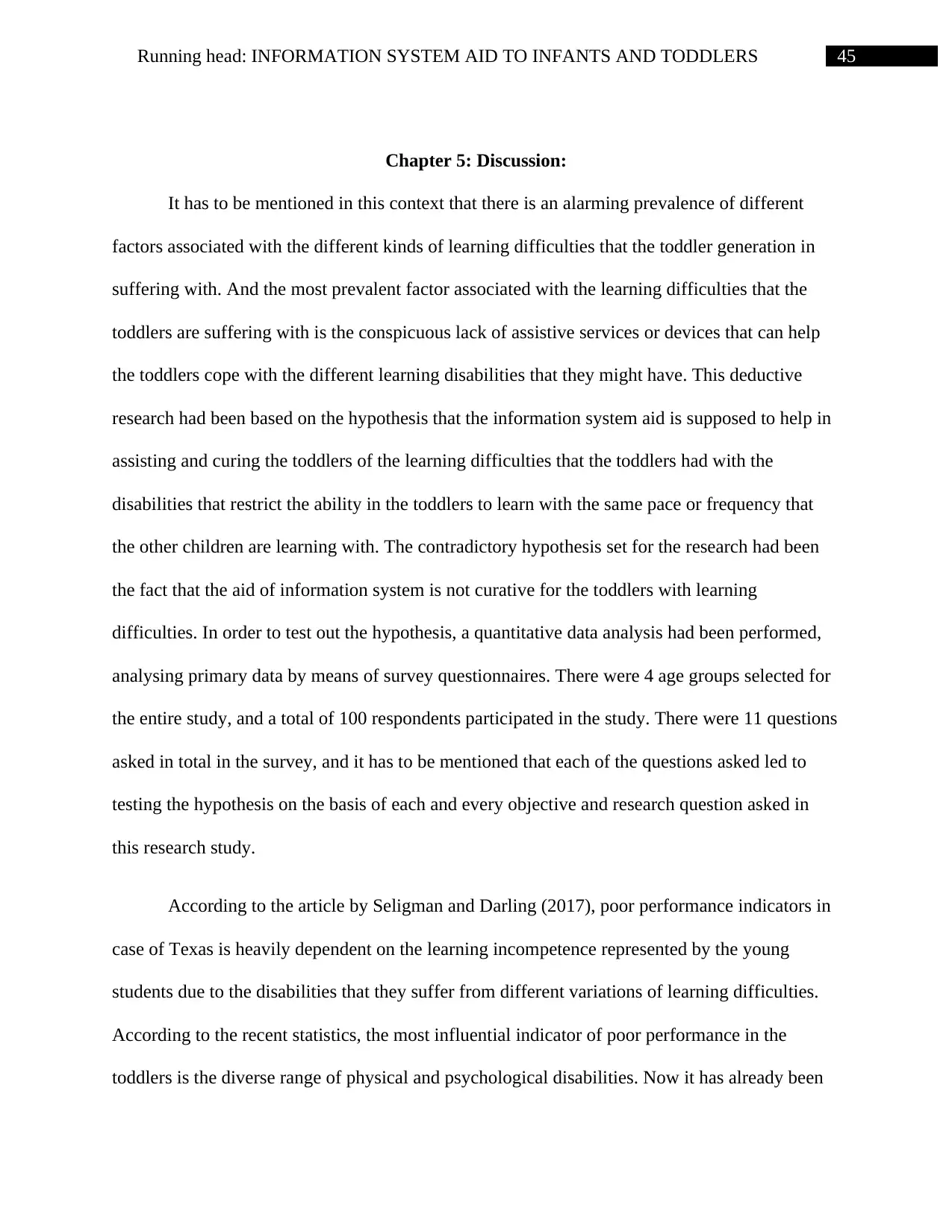
45Running head: INFORMATION SYSTEM AID TO INFANTS AND TODDLERS
Chapter 5: Discussion:
It has to be mentioned in this context that there is an alarming prevalence of different
factors associated with the different kinds of learning difficulties that the toddler generation in
suffering with. And the most prevalent factor associated with the learning difficulties that the
toddlers are suffering with is the conspicuous lack of assistive services or devices that can help
the toddlers cope with the different learning disabilities that they might have. This deductive
research had been based on the hypothesis that the information system aid is supposed to help in
assisting and curing the toddlers of the learning difficulties that the toddlers had with the
disabilities that restrict the ability in the toddlers to learn with the same pace or frequency that
the other children are learning with. The contradictory hypothesis set for the research had been
the fact that the aid of information system is not curative for the toddlers with learning
difficulties. In order to test out the hypothesis, a quantitative data analysis had been performed,
analysing primary data by means of survey questionnaires. There were 4 age groups selected for
the entire study, and a total of 100 respondents participated in the study. There were 11 questions
asked in total in the survey, and it has to be mentioned that each of the questions asked led to
testing the hypothesis on the basis of each and every objective and research question asked in
this research study.
According to the article by Seligman and Darling (2017), poor performance indicators in
case of Texas is heavily dependent on the learning incompetence represented by the young
students due to the disabilities that they suffer from different variations of learning difficulties.
According to the recent statistics, the most influential indicator of poor performance in the
toddlers is the diverse range of physical and psychological disabilities. Now it has already been
Chapter 5: Discussion:
It has to be mentioned in this context that there is an alarming prevalence of different
factors associated with the different kinds of learning difficulties that the toddler generation in
suffering with. And the most prevalent factor associated with the learning difficulties that the
toddlers are suffering with is the conspicuous lack of assistive services or devices that can help
the toddlers cope with the different learning disabilities that they might have. This deductive
research had been based on the hypothesis that the information system aid is supposed to help in
assisting and curing the toddlers of the learning difficulties that the toddlers had with the
disabilities that restrict the ability in the toddlers to learn with the same pace or frequency that
the other children are learning with. The contradictory hypothesis set for the research had been
the fact that the aid of information system is not curative for the toddlers with learning
difficulties. In order to test out the hypothesis, a quantitative data analysis had been performed,
analysing primary data by means of survey questionnaires. There were 4 age groups selected for
the entire study, and a total of 100 respondents participated in the study. There were 11 questions
asked in total in the survey, and it has to be mentioned that each of the questions asked led to
testing the hypothesis on the basis of each and every objective and research question asked in
this research study.
According to the article by Seligman and Darling (2017), poor performance indicators in
case of Texas is heavily dependent on the learning incompetence represented by the young
students due to the disabilities that they suffer from different variations of learning difficulties.
According to the recent statistics, the most influential indicator of poor performance in the
toddlers is the diverse range of physical and psychological disabilities. Now it has already been
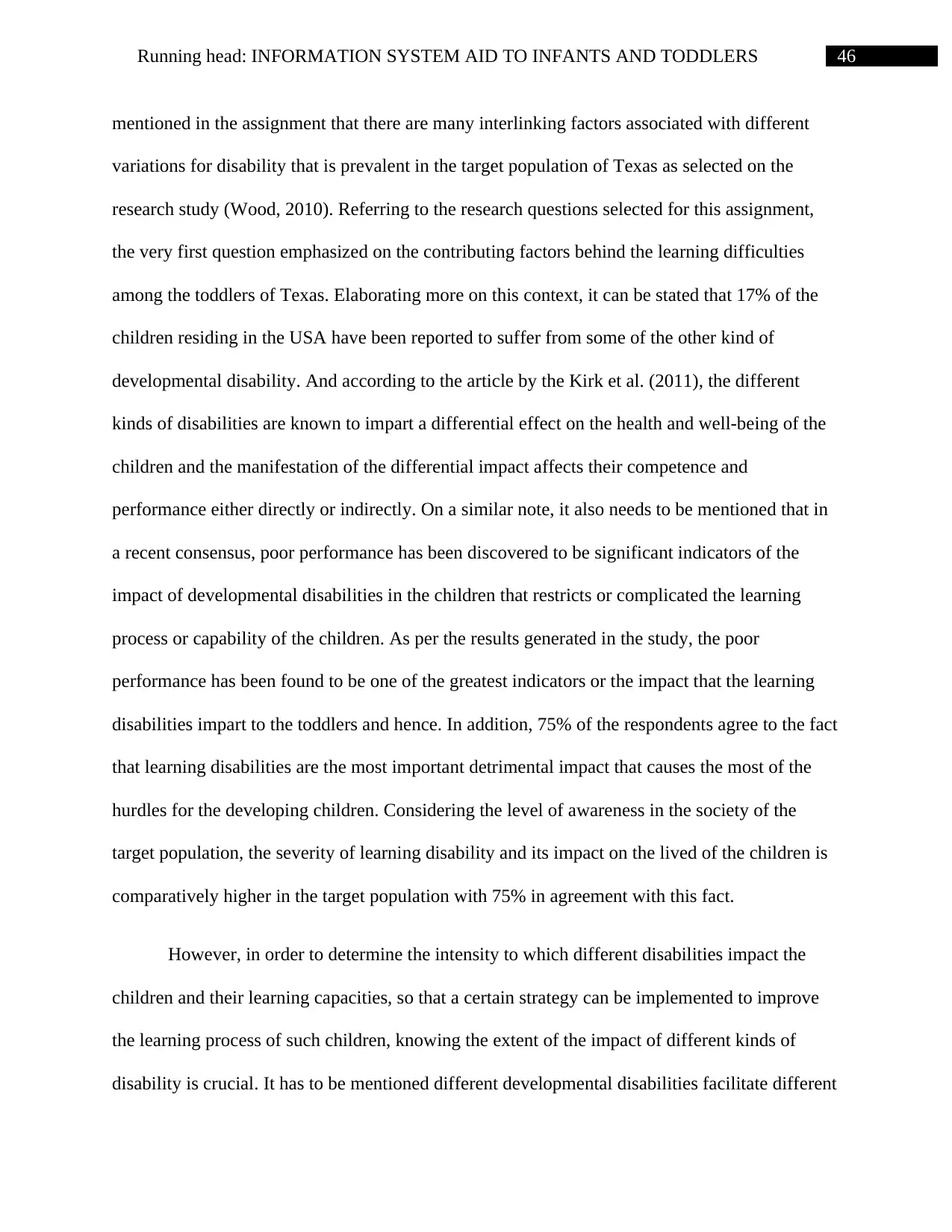
46Running head: INFORMATION SYSTEM AID TO INFANTS AND TODDLERS
mentioned in the assignment that there are many interlinking factors associated with different
variations for disability that is prevalent in the target population of Texas as selected on the
research study (Wood, 2010). Referring to the research questions selected for this assignment,
the very first question emphasized on the contributing factors behind the learning difficulties
among the toddlers of Texas. Elaborating more on this context, it can be stated that 17% of the
children residing in the USA have been reported to suffer from some of the other kind of
developmental disability. And according to the article by the Kirk et al. (2011), the different
kinds of disabilities are known to impart a differential effect on the health and well-being of the
children and the manifestation of the differential impact affects their competence and
performance either directly or indirectly. On a similar note, it also needs to be mentioned that in
a recent consensus, poor performance has been discovered to be significant indicators of the
impact of developmental disabilities in the children that restricts or complicated the learning
process or capability of the children. As per the results generated in the study, the poor
performance has been found to be one of the greatest indicators or the impact that the learning
disabilities impart to the toddlers and hence. In addition, 75% of the respondents agree to the fact
that learning disabilities are the most important detrimental impact that causes the most of the
hurdles for the developing children. Considering the level of awareness in the society of the
target population, the severity of learning disability and its impact on the lived of the children is
comparatively higher in the target population with 75% in agreement with this fact.
However, in order to determine the intensity to which different disabilities impact the
children and their learning capacities, so that a certain strategy can be implemented to improve
the learning process of such children, knowing the extent of the impact of different kinds of
disability is crucial. It has to be mentioned different developmental disabilities facilitate different
mentioned in the assignment that there are many interlinking factors associated with different
variations for disability that is prevalent in the target population of Texas as selected on the
research study (Wood, 2010). Referring to the research questions selected for this assignment,
the very first question emphasized on the contributing factors behind the learning difficulties
among the toddlers of Texas. Elaborating more on this context, it can be stated that 17% of the
children residing in the USA have been reported to suffer from some of the other kind of
developmental disability. And according to the article by the Kirk et al. (2011), the different
kinds of disabilities are known to impart a differential effect on the health and well-being of the
children and the manifestation of the differential impact affects their competence and
performance either directly or indirectly. On a similar note, it also needs to be mentioned that in
a recent consensus, poor performance has been discovered to be significant indicators of the
impact of developmental disabilities in the children that restricts or complicated the learning
process or capability of the children. As per the results generated in the study, the poor
performance has been found to be one of the greatest indicators or the impact that the learning
disabilities impart to the toddlers and hence. In addition, 75% of the respondents agree to the fact
that learning disabilities are the most important detrimental impact that causes the most of the
hurdles for the developing children. Considering the level of awareness in the society of the
target population, the severity of learning disability and its impact on the lived of the children is
comparatively higher in the target population with 75% in agreement with this fact.
However, in order to determine the intensity to which different disabilities impact the
children and their learning capacities, so that a certain strategy can be implemented to improve
the learning process of such children, knowing the extent of the impact of different kinds of
disability is crucial. It has to be mentioned different developmental disabilities facilitate different
Secure Best Marks with AI Grader
Need help grading? Try our AI Grader for instant feedback on your assignments.
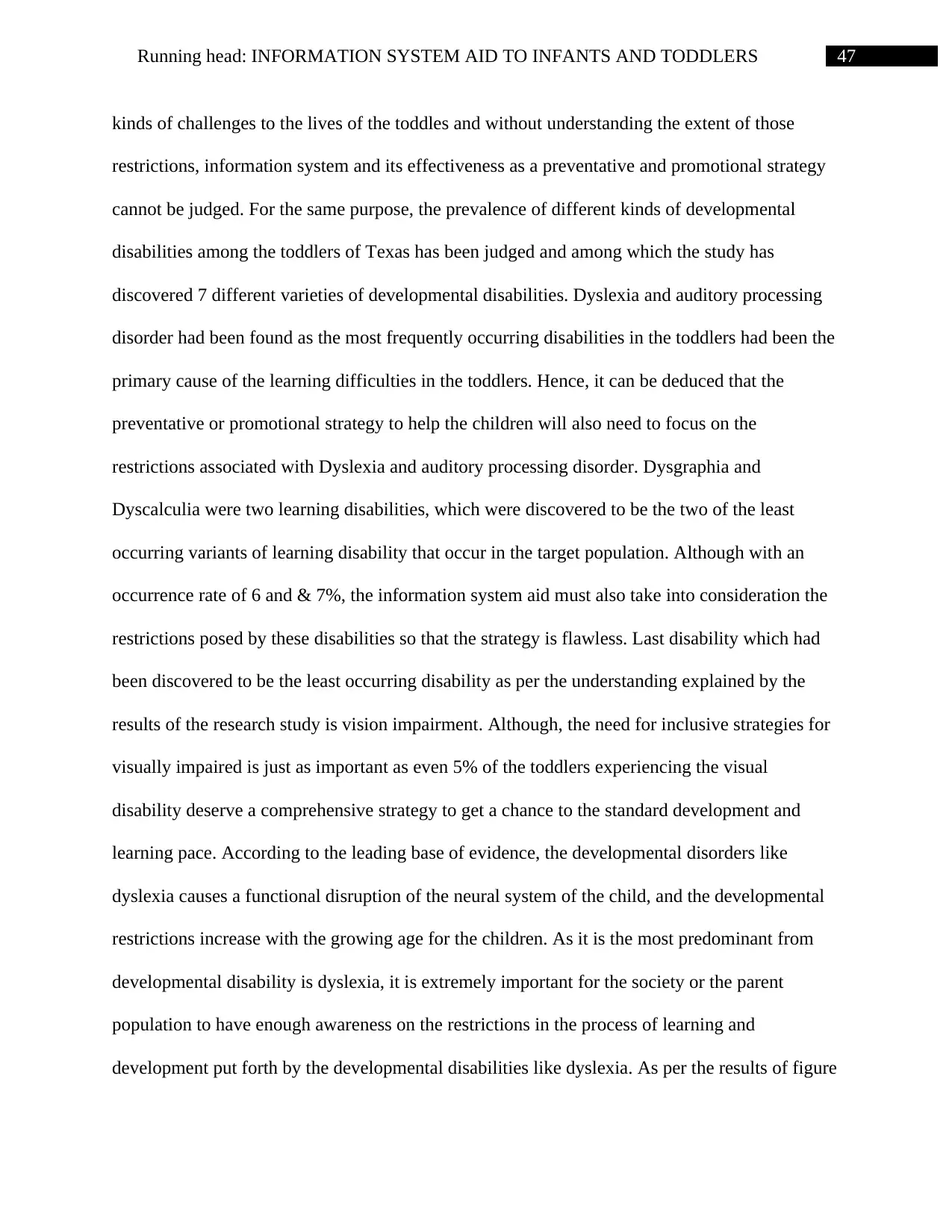
47Running head: INFORMATION SYSTEM AID TO INFANTS AND TODDLERS
kinds of challenges to the lives of the toddles and without understanding the extent of those
restrictions, information system and its effectiveness as a preventative and promotional strategy
cannot be judged. For the same purpose, the prevalence of different kinds of developmental
disabilities among the toddlers of Texas has been judged and among which the study has
discovered 7 different varieties of developmental disabilities. Dyslexia and auditory processing
disorder had been found as the most frequently occurring disabilities in the toddlers had been the
primary cause of the learning difficulties in the toddlers. Hence, it can be deduced that the
preventative or promotional strategy to help the children will also need to focus on the
restrictions associated with Dyslexia and auditory processing disorder. Dysgraphia and
Dyscalculia were two learning disabilities, which were discovered to be the two of the least
occurring variants of learning disability that occur in the target population. Although with an
occurrence rate of 6 and & 7%, the information system aid must also take into consideration the
restrictions posed by these disabilities so that the strategy is flawless. Last disability which had
been discovered to be the least occurring disability as per the understanding explained by the
results of the research study is vision impairment. Although, the need for inclusive strategies for
visually impaired is just as important as even 5% of the toddlers experiencing the visual
disability deserve a comprehensive strategy to get a chance to the standard development and
learning pace. According to the leading base of evidence, the developmental disorders like
dyslexia causes a functional disruption of the neural system of the child, and the developmental
restrictions increase with the growing age for the children. As it is the most predominant from
developmental disability is dyslexia, it is extremely important for the society or the parent
population to have enough awareness on the restrictions in the process of learning and
development put forth by the developmental disabilities like dyslexia. As per the results of figure
kinds of challenges to the lives of the toddles and without understanding the extent of those
restrictions, information system and its effectiveness as a preventative and promotional strategy
cannot be judged. For the same purpose, the prevalence of different kinds of developmental
disabilities among the toddlers of Texas has been judged and among which the study has
discovered 7 different varieties of developmental disabilities. Dyslexia and auditory processing
disorder had been found as the most frequently occurring disabilities in the toddlers had been the
primary cause of the learning difficulties in the toddlers. Hence, it can be deduced that the
preventative or promotional strategy to help the children will also need to focus on the
restrictions associated with Dyslexia and auditory processing disorder. Dysgraphia and
Dyscalculia were two learning disabilities, which were discovered to be the two of the least
occurring variants of learning disability that occur in the target population. Although with an
occurrence rate of 6 and & 7%, the information system aid must also take into consideration the
restrictions posed by these disabilities so that the strategy is flawless. Last disability which had
been discovered to be the least occurring disability as per the understanding explained by the
results of the research study is vision impairment. Although, the need for inclusive strategies for
visually impaired is just as important as even 5% of the toddlers experiencing the visual
disability deserve a comprehensive strategy to get a chance to the standard development and
learning pace. According to the leading base of evidence, the developmental disorders like
dyslexia causes a functional disruption of the neural system of the child, and the developmental
restrictions increase with the growing age for the children. As it is the most predominant from
developmental disability is dyslexia, it is extremely important for the society or the parent
population to have enough awareness on the restrictions in the process of learning and
development put forth by the developmental disabilities like dyslexia. As per the results of figure
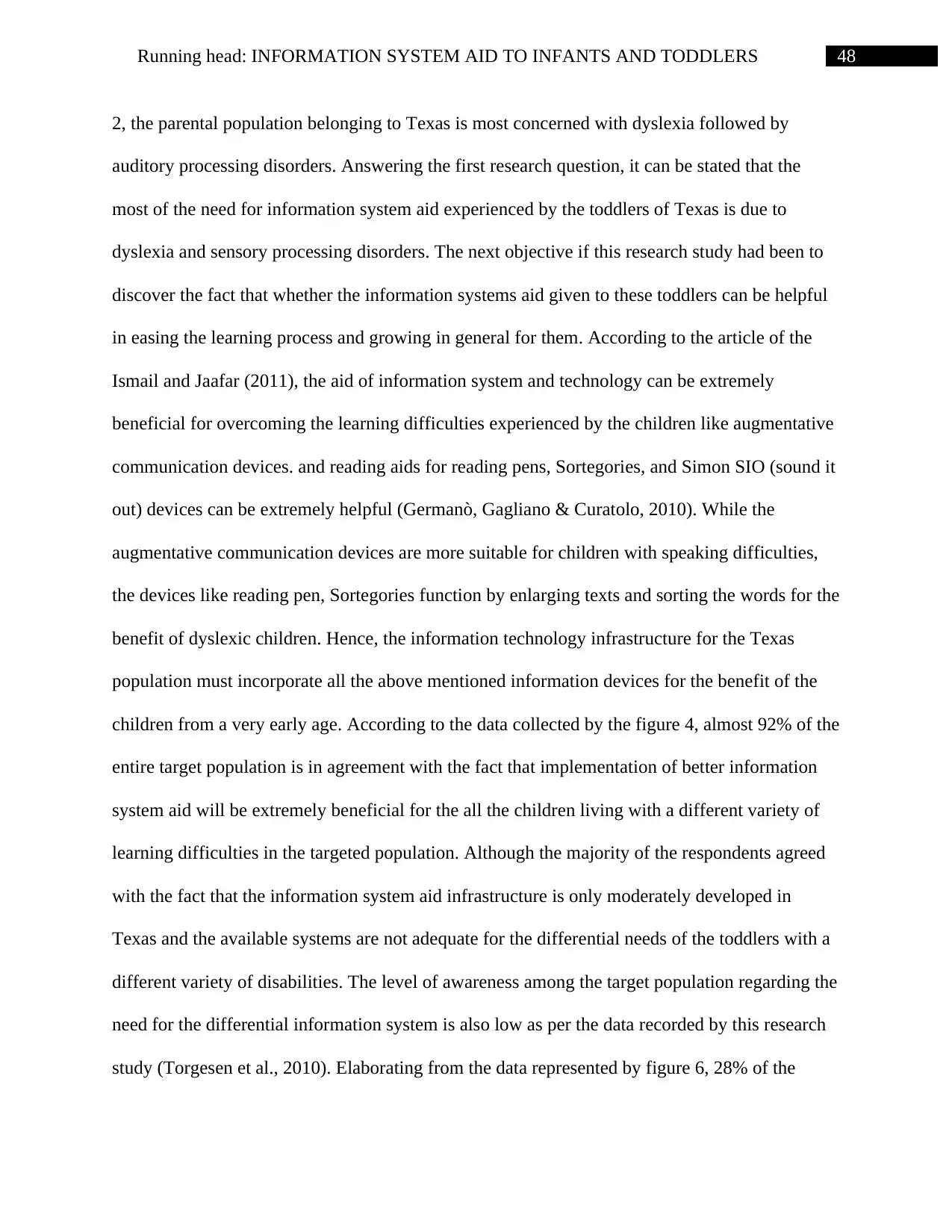
48Running head: INFORMATION SYSTEM AID TO INFANTS AND TODDLERS
2, the parental population belonging to Texas is most concerned with dyslexia followed by
auditory processing disorders. Answering the first research question, it can be stated that the
most of the need for information system aid experienced by the toddlers of Texas is due to
dyslexia and sensory processing disorders. The next objective if this research study had been to
discover the fact that whether the information systems aid given to these toddlers can be helpful
in easing the learning process and growing in general for them. According to the article of the
Ismail and Jaafar (2011), the aid of information system and technology can be extremely
beneficial for overcoming the learning difficulties experienced by the children like augmentative
communication devices. and reading aids for reading pens, Sortegories, and Simon SIO (sound it
out) devices can be extremely helpful (Germanò, Gagliano & Curatolo, 2010). While the
augmentative communication devices are more suitable for children with speaking difficulties,
the devices like reading pen, Sortegories function by enlarging texts and sorting the words for the
benefit of dyslexic children. Hence, the information technology infrastructure for the Texas
population must incorporate all the above mentioned information devices for the benefit of the
children from a very early age. According to the data collected by the figure 4, almost 92% of the
entire target population is in agreement with the fact that implementation of better information
system aid will be extremely beneficial for the all the children living with a different variety of
learning difficulties in the targeted population. Although the majority of the respondents agreed
with the fact that the information system aid infrastructure is only moderately developed in
Texas and the available systems are not adequate for the differential needs of the toddlers with a
different variety of disabilities. The level of awareness among the target population regarding the
need for the differential information system is also low as per the data recorded by this research
study (Torgesen et al., 2010). Elaborating from the data represented by figure 6, 28% of the
2, the parental population belonging to Texas is most concerned with dyslexia followed by
auditory processing disorders. Answering the first research question, it can be stated that the
most of the need for information system aid experienced by the toddlers of Texas is due to
dyslexia and sensory processing disorders. The next objective if this research study had been to
discover the fact that whether the information systems aid given to these toddlers can be helpful
in easing the learning process and growing in general for them. According to the article of the
Ismail and Jaafar (2011), the aid of information system and technology can be extremely
beneficial for overcoming the learning difficulties experienced by the children like augmentative
communication devices. and reading aids for reading pens, Sortegories, and Simon SIO (sound it
out) devices can be extremely helpful (Germanò, Gagliano & Curatolo, 2010). While the
augmentative communication devices are more suitable for children with speaking difficulties,
the devices like reading pen, Sortegories function by enlarging texts and sorting the words for the
benefit of dyslexic children. Hence, the information technology infrastructure for the Texas
population must incorporate all the above mentioned information devices for the benefit of the
children from a very early age. According to the data collected by the figure 4, almost 92% of the
entire target population is in agreement with the fact that implementation of better information
system aid will be extremely beneficial for the all the children living with a different variety of
learning difficulties in the targeted population. Although the majority of the respondents agreed
with the fact that the information system aid infrastructure is only moderately developed in
Texas and the available systems are not adequate for the differential needs of the toddlers with a
different variety of disabilities. The level of awareness among the target population regarding the
need for the differential information system is also low as per the data recorded by this research
study (Torgesen et al., 2010). Elaborating from the data represented by figure 6, 28% of the

49Running head: INFORMATION SYSTEM AID TO INFANTS AND TODDLERS
Texas society is not acutely aware of the different needs and requirements of the children
growing with any learning disability. And hence, they are also unaware of the fact that there are
some limitations associated with technological aids or devices presently in use in the American
health care and social care structure, and there is the need for reform so that each and every
developmental need of the toddlers with a developmental disability can be addressed. According
to the article by the McCarthy and Swierenga (2010), the information system aid available for
the children at present is mostly based on the different augmentative communication devices and
visual learning aids. In addition, there is need for more refined disability aids to be incorporated
within the societal infrastructure so that the best care is provided to these children and they can
avail the most of the opportunities provided to them to aid in the process of growth and
development.
It has to be mentioned in this context that implementation of information system in the
social infrastructure and generating a proper awareness in the target population regarding the
benefits of needs of these devices or services depends heavily on string actions taken by the
federal government. As explained in figure 7, the majority of the target population are either
unaware or are unhappy with the government involvement with the entire procedure. In
agreement, Helland et al. (2011), has explained that the implementation of high-tech informative
aids or devices in all sectors of the society will require a considerable budget allocated to the
societal improvement and disability inclusion schemes. And a change like so in the community
can only be facilitated if the government authorities and all the stakeholders associated with this
situation are adequately involved in this procedure. Although, the results of the research study
indicates the fact that the national authorities of the target region lack enough emphasis or efforts
being invested in this sector. In addition, the level of awareness in the target population
Texas society is not acutely aware of the different needs and requirements of the children
growing with any learning disability. And hence, they are also unaware of the fact that there are
some limitations associated with technological aids or devices presently in use in the American
health care and social care structure, and there is the need for reform so that each and every
developmental need of the toddlers with a developmental disability can be addressed. According
to the article by the McCarthy and Swierenga (2010), the information system aid available for
the children at present is mostly based on the different augmentative communication devices and
visual learning aids. In addition, there is need for more refined disability aids to be incorporated
within the societal infrastructure so that the best care is provided to these children and they can
avail the most of the opportunities provided to them to aid in the process of growth and
development.
It has to be mentioned in this context that implementation of information system in the
social infrastructure and generating a proper awareness in the target population regarding the
benefits of needs of these devices or services depends heavily on string actions taken by the
federal government. As explained in figure 7, the majority of the target population are either
unaware or are unhappy with the government involvement with the entire procedure. In
agreement, Helland et al. (2011), has explained that the implementation of high-tech informative
aids or devices in all sectors of the society will require a considerable budget allocated to the
societal improvement and disability inclusion schemes. And a change like so in the community
can only be facilitated if the government authorities and all the stakeholders associated with this
situation are adequately involved in this procedure. Although, the results of the research study
indicates the fact that the national authorities of the target region lack enough emphasis or efforts
being invested in this sector. In addition, the level of awareness in the target population
Paraphrase This Document
Need a fresh take? Get an instant paraphrase of this document with our AI Paraphraser
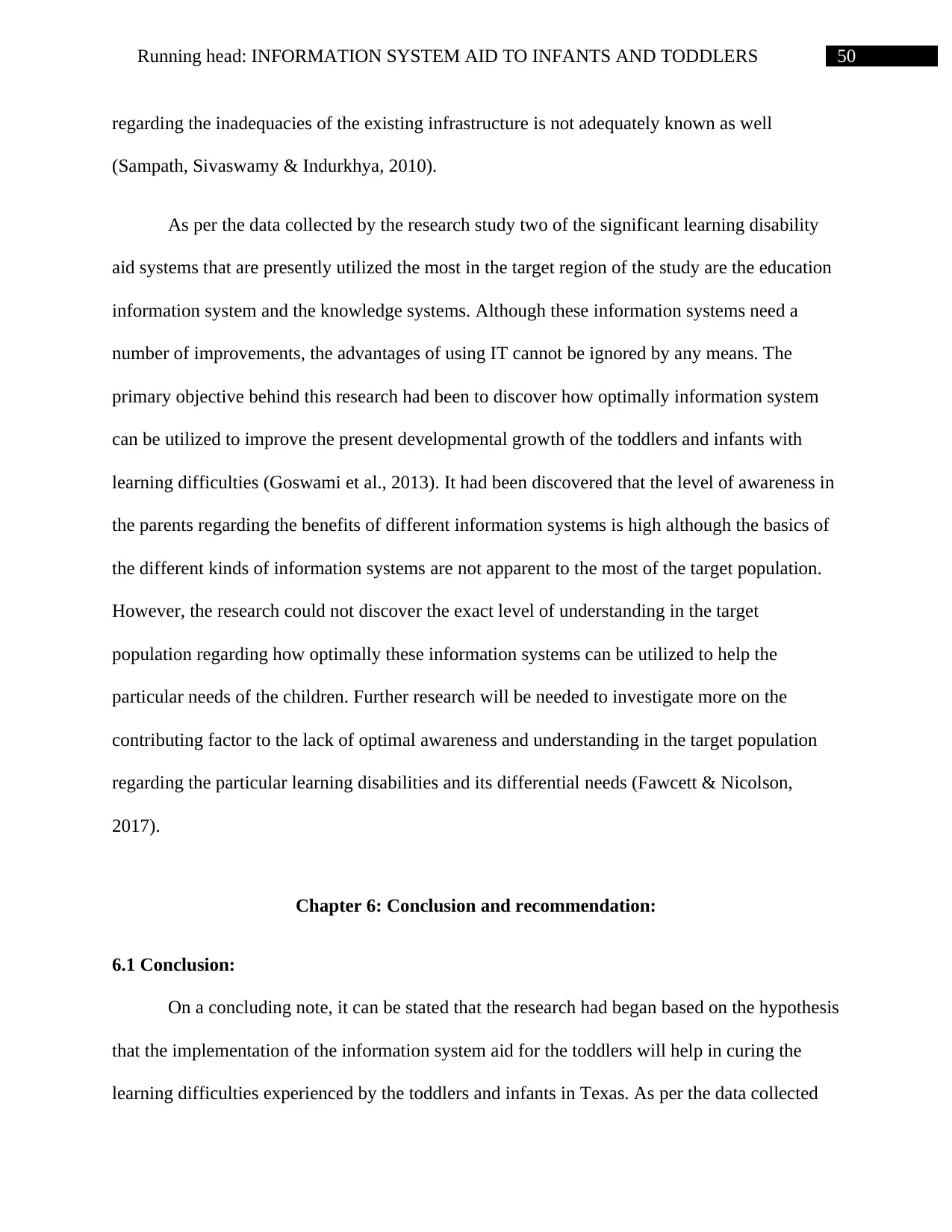
50Running head: INFORMATION SYSTEM AID TO INFANTS AND TODDLERS
regarding the inadequacies of the existing infrastructure is not adequately known as well
(Sampath, Sivaswamy & Indurkhya, 2010).
As per the data collected by the research study two of the significant learning disability
aid systems that are presently utilized the most in the target region of the study are the education
information system and the knowledge systems. Although these information systems need a
number of improvements, the advantages of using IT cannot be ignored by any means. The
primary objective behind this research had been to discover how optimally information system
can be utilized to improve the present developmental growth of the toddlers and infants with
learning difficulties (Goswami et al., 2013). It had been discovered that the level of awareness in
the parents regarding the benefits of different information systems is high although the basics of
the different kinds of information systems are not apparent to the most of the target population.
However, the research could not discover the exact level of understanding in the target
population regarding how optimally these information systems can be utilized to help the
particular needs of the children. Further research will be needed to investigate more on the
contributing factor to the lack of optimal awareness and understanding in the target population
regarding the particular learning disabilities and its differential needs (Fawcett & Nicolson,
2017).
Chapter 6: Conclusion and recommendation:
6.1 Conclusion:
On a concluding note, it can be stated that the research had began based on the hypothesis
that the implementation of the information system aid for the toddlers will help in curing the
learning difficulties experienced by the toddlers and infants in Texas. As per the data collected
regarding the inadequacies of the existing infrastructure is not adequately known as well
(Sampath, Sivaswamy & Indurkhya, 2010).
As per the data collected by the research study two of the significant learning disability
aid systems that are presently utilized the most in the target region of the study are the education
information system and the knowledge systems. Although these information systems need a
number of improvements, the advantages of using IT cannot be ignored by any means. The
primary objective behind this research had been to discover how optimally information system
can be utilized to improve the present developmental growth of the toddlers and infants with
learning difficulties (Goswami et al., 2013). It had been discovered that the level of awareness in
the parents regarding the benefits of different information systems is high although the basics of
the different kinds of information systems are not apparent to the most of the target population.
However, the research could not discover the exact level of understanding in the target
population regarding how optimally these information systems can be utilized to help the
particular needs of the children. Further research will be needed to investigate more on the
contributing factor to the lack of optimal awareness and understanding in the target population
regarding the particular learning disabilities and its differential needs (Fawcett & Nicolson,
2017).
Chapter 6: Conclusion and recommendation:
6.1 Conclusion:
On a concluding note, it can be stated that the research had began based on the hypothesis
that the implementation of the information system aid for the toddlers will help in curing the
learning difficulties experienced by the toddlers and infants in Texas. As per the data collected
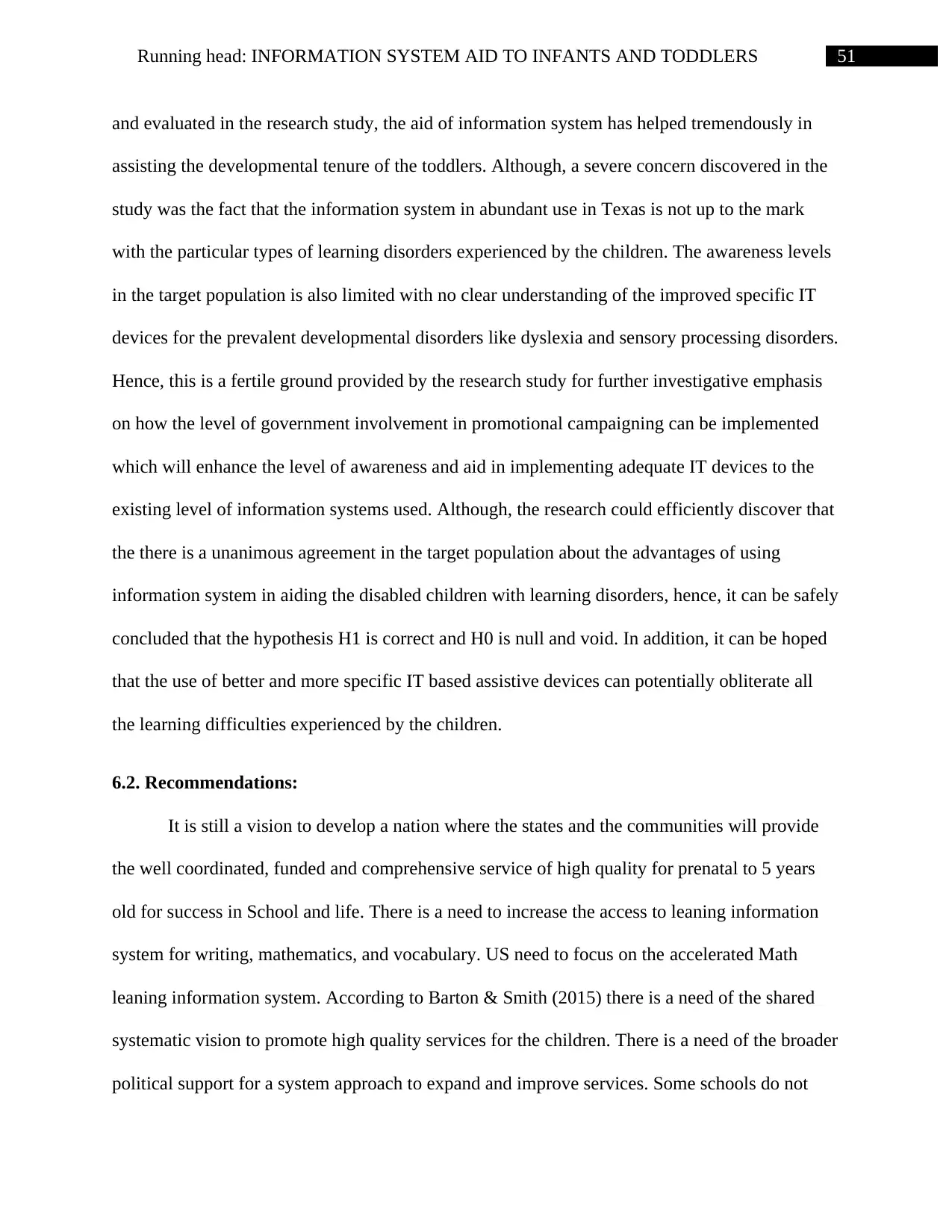
51Running head: INFORMATION SYSTEM AID TO INFANTS AND TODDLERS
and evaluated in the research study, the aid of information system has helped tremendously in
assisting the developmental tenure of the toddlers. Although, a severe concern discovered in the
study was the fact that the information system in abundant use in Texas is not up to the mark
with the particular types of learning disorders experienced by the children. The awareness levels
in the target population is also limited with no clear understanding of the improved specific IT
devices for the prevalent developmental disorders like dyslexia and sensory processing disorders.
Hence, this is a fertile ground provided by the research study for further investigative emphasis
on how the level of government involvement in promotional campaigning can be implemented
which will enhance the level of awareness and aid in implementing adequate IT devices to the
existing level of information systems used. Although, the research could efficiently discover that
the there is a unanimous agreement in the target population about the advantages of using
information system in aiding the disabled children with learning disorders, hence, it can be safely
concluded that the hypothesis H1 is correct and H0 is null and void. In addition, it can be hoped
that the use of better and more specific IT based assistive devices can potentially obliterate all
the learning difficulties experienced by the children.
6.2. Recommendations:
It is still a vision to develop a nation where the states and the communities will provide
the well coordinated, funded and comprehensive service of high quality for prenatal to 5 years
old for success in School and life. There is a need to increase the access to leaning information
system for writing, mathematics, and vocabulary. US need to focus on the accelerated Math
leaning information system. According to Barton & Smith (2015) there is a need of the shared
systematic vision to promote high quality services for the children. There is a need of the broader
political support for a system approach to expand and improve services. Some schools do not
and evaluated in the research study, the aid of information system has helped tremendously in
assisting the developmental tenure of the toddlers. Although, a severe concern discovered in the
study was the fact that the information system in abundant use in Texas is not up to the mark
with the particular types of learning disorders experienced by the children. The awareness levels
in the target population is also limited with no clear understanding of the improved specific IT
devices for the prevalent developmental disorders like dyslexia and sensory processing disorders.
Hence, this is a fertile ground provided by the research study for further investigative emphasis
on how the level of government involvement in promotional campaigning can be implemented
which will enhance the level of awareness and aid in implementing adequate IT devices to the
existing level of information systems used. Although, the research could efficiently discover that
the there is a unanimous agreement in the target population about the advantages of using
information system in aiding the disabled children with learning disorders, hence, it can be safely
concluded that the hypothesis H1 is correct and H0 is null and void. In addition, it can be hoped
that the use of better and more specific IT based assistive devices can potentially obliterate all
the learning difficulties experienced by the children.
6.2. Recommendations:
It is still a vision to develop a nation where the states and the communities will provide
the well coordinated, funded and comprehensive service of high quality for prenatal to 5 years
old for success in School and life. There is a need to increase the access to leaning information
system for writing, mathematics, and vocabulary. US need to focus on the accelerated Math
leaning information system. According to Barton & Smith (2015) there is a need of the shared
systematic vision to promote high quality services for the children. There is a need of the broader
political support for a system approach to expand and improve services. Some schools do not
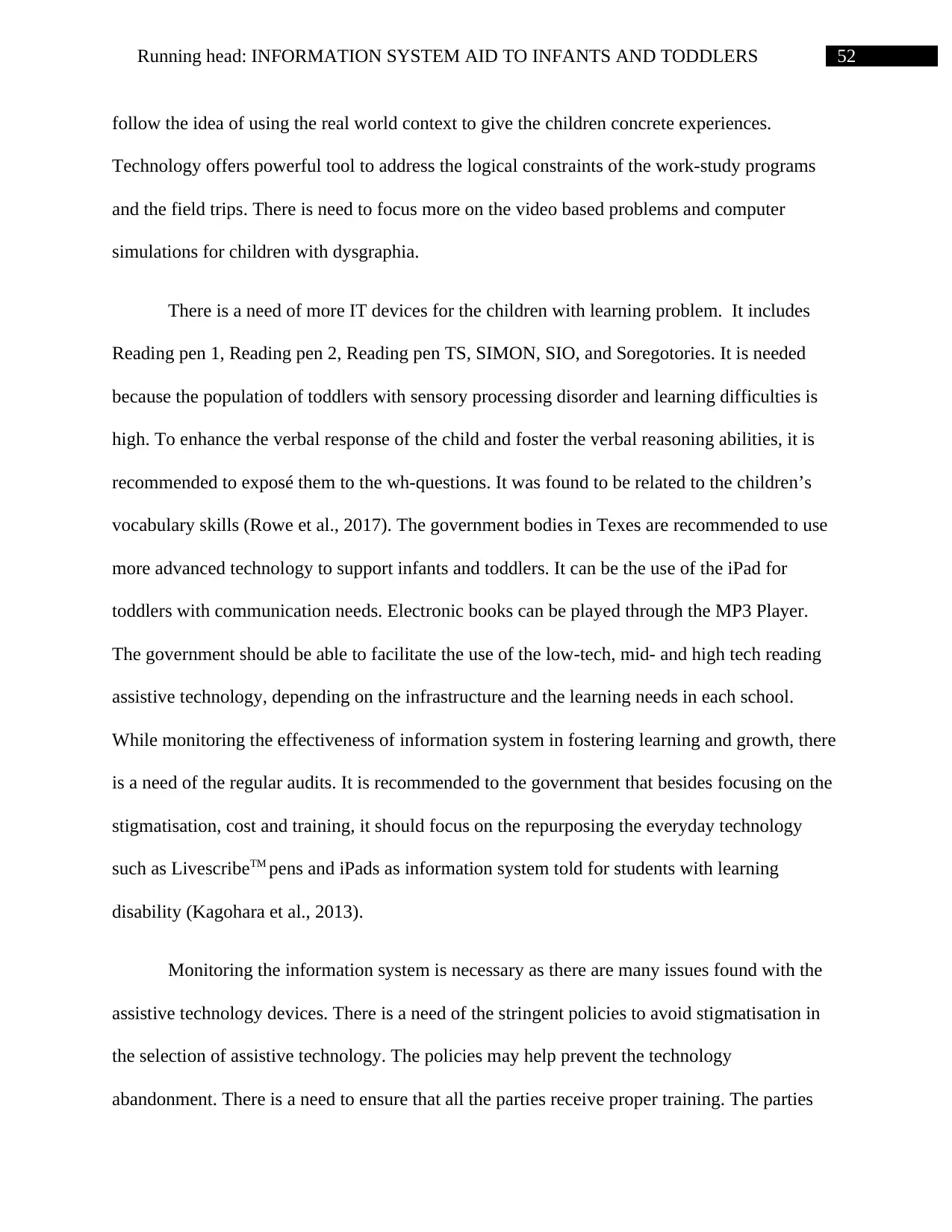
52Running head: INFORMATION SYSTEM AID TO INFANTS AND TODDLERS
follow the idea of using the real world context to give the children concrete experiences.
Technology offers powerful tool to address the logical constraints of the work-study programs
and the field trips. There is need to focus more on the video based problems and computer
simulations for children with dysgraphia.
There is a need of more IT devices for the children with learning problem. It includes
Reading pen 1, Reading pen 2, Reading pen TS, SIMON, SIO, and Soregotories. It is needed
because the population of toddlers with sensory processing disorder and learning difficulties is
high. To enhance the verbal response of the child and foster the verbal reasoning abilities, it is
recommended to exposé them to the wh-questions. It was found to be related to the children’s
vocabulary skills (Rowe et al., 2017). The government bodies in Texes are recommended to use
more advanced technology to support infants and toddlers. It can be the use of the iPad for
toddlers with communication needs. Electronic books can be played through the MP3 Player.
The government should be able to facilitate the use of the low-tech, mid- and high tech reading
assistive technology, depending on the infrastructure and the learning needs in each school.
While monitoring the effectiveness of information system in fostering learning and growth, there
is a need of the regular audits. It is recommended to the government that besides focusing on the
stigmatisation, cost and training, it should focus on the repurposing the everyday technology
such as LivescribeTM pens and iPads as information system told for students with learning
disability (Kagohara et al., 2013).
Monitoring the information system is necessary as there are many issues found with the
assistive technology devices. There is a need of the stringent policies to avoid stigmatisation in
the selection of assistive technology. The policies may help prevent the technology
abandonment. There is a need to ensure that all the parties receive proper training. The parties
follow the idea of using the real world context to give the children concrete experiences.
Technology offers powerful tool to address the logical constraints of the work-study programs
and the field trips. There is need to focus more on the video based problems and computer
simulations for children with dysgraphia.
There is a need of more IT devices for the children with learning problem. It includes
Reading pen 1, Reading pen 2, Reading pen TS, SIMON, SIO, and Soregotories. It is needed
because the population of toddlers with sensory processing disorder and learning difficulties is
high. To enhance the verbal response of the child and foster the verbal reasoning abilities, it is
recommended to exposé them to the wh-questions. It was found to be related to the children’s
vocabulary skills (Rowe et al., 2017). The government bodies in Texes are recommended to use
more advanced technology to support infants and toddlers. It can be the use of the iPad for
toddlers with communication needs. Electronic books can be played through the MP3 Player.
The government should be able to facilitate the use of the low-tech, mid- and high tech reading
assistive technology, depending on the infrastructure and the learning needs in each school.
While monitoring the effectiveness of information system in fostering learning and growth, there
is a need of the regular audits. It is recommended to the government that besides focusing on the
stigmatisation, cost and training, it should focus on the repurposing the everyday technology
such as LivescribeTM pens and iPads as information system told for students with learning
disability (Kagohara et al., 2013).
Monitoring the information system is necessary as there are many issues found with the
assistive technology devices. There is a need of the stringent policies to avoid stigmatisation in
the selection of assistive technology. The policies may help prevent the technology
abandonment. There is a need to ensure that all the parties receive proper training. The parties
Secure Best Marks with AI Grader
Need help grading? Try our AI Grader for instant feedback on your assignments.
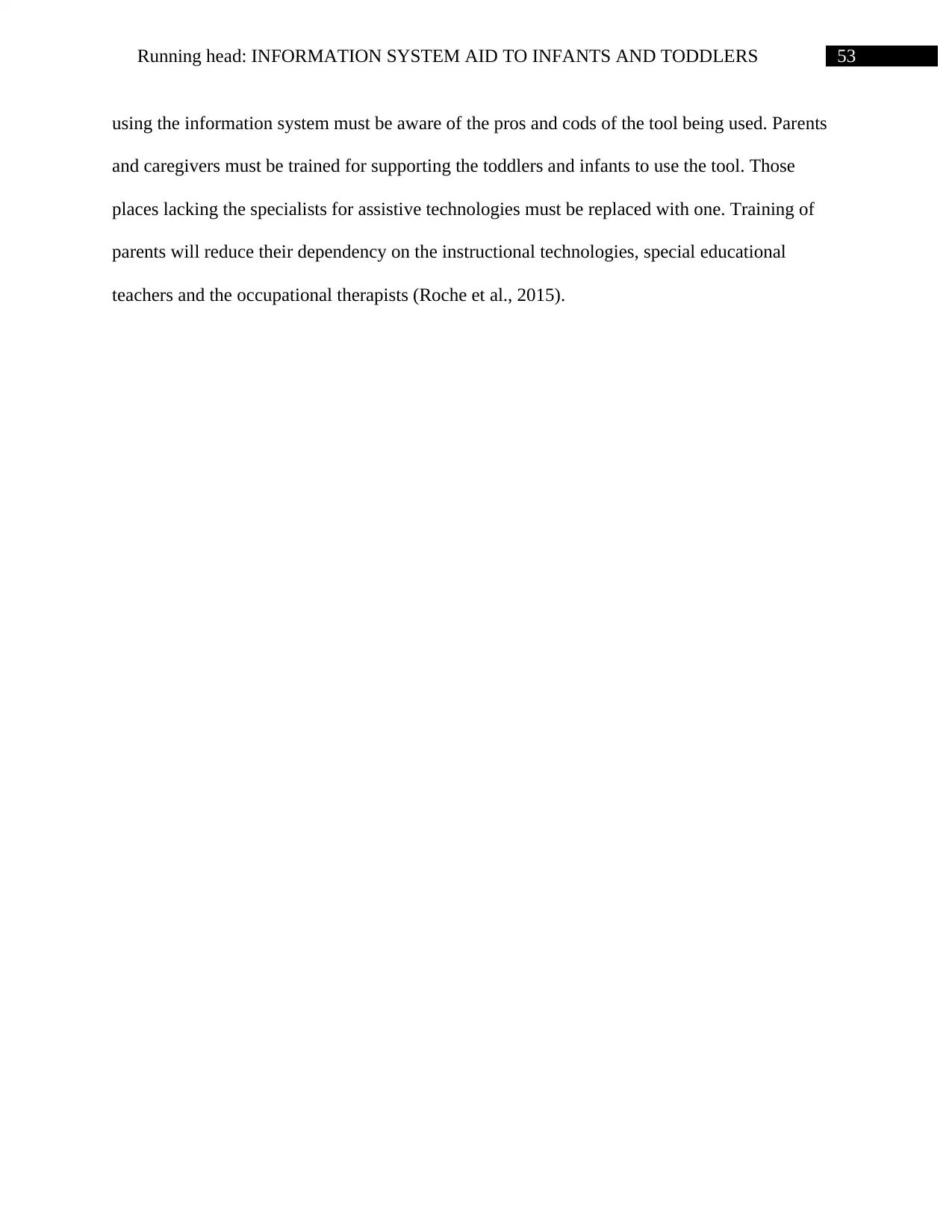
53Running head: INFORMATION SYSTEM AID TO INFANTS AND TODDLERS
using the information system must be aware of the pros and cods of the tool being used. Parents
and caregivers must be trained for supporting the toddlers and infants to use the tool. Those
places lacking the specialists for assistive technologies must be replaced with one. Training of
parents will reduce their dependency on the instructional technologies, special educational
teachers and the occupational therapists (Roche et al., 2015).
using the information system must be aware of the pros and cods of the tool being used. Parents
and caregivers must be trained for supporting the toddlers and infants to use the tool. Those
places lacking the specialists for assistive technologies must be replaced with one. Training of
parents will reduce their dependency on the instructional technologies, special educational
teachers and the occupational therapists (Roche et al., 2015).
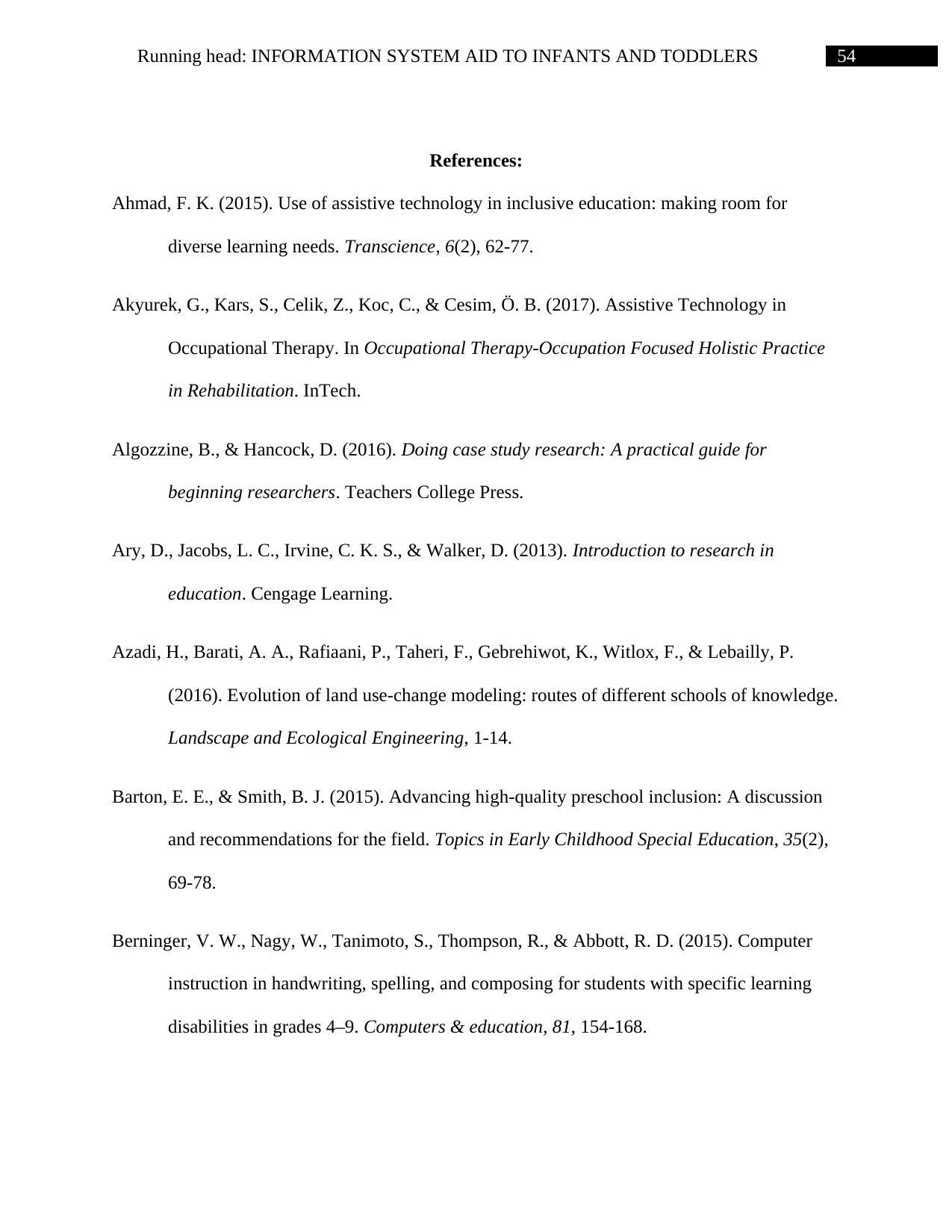
54Running head: INFORMATION SYSTEM AID TO INFANTS AND TODDLERS
References:
Ahmad, F. K. (2015). Use of assistive technology in inclusive education: making room for
diverse learning needs. Transcience, 6(2), 62-77.
Akyurek, G., Kars, S., Celik, Z., Koc, C., & Cesim, Ö. B. (2017). Assistive Technology in
Occupational Therapy. In Occupational Therapy-Occupation Focused Holistic Practice
in Rehabilitation. InTech.
Algozzine, B., & Hancock, D. (2016). Doing case study research: A practical guide for
beginning researchers. Teachers College Press.
Ary, D., Jacobs, L. C., Irvine, C. K. S., & Walker, D. (2013). Introduction to research in
education. Cengage Learning.
Azadi, H., Barati, A. A., Rafiaani, P., Taheri, F., Gebrehiwot, K., Witlox, F., & Lebailly, P.
(2016). Evolution of land use-change modeling: routes of different schools of knowledge.
Landscape and Ecological Engineering, 1-14.
Barton, E. E., & Smith, B. J. (2015). Advancing high-quality preschool inclusion: A discussion
and recommendations for the field. Topics in Early Childhood Special Education, 35(2),
69-78.
Berninger, V. W., Nagy, W., Tanimoto, S., Thompson, R., & Abbott, R. D. (2015). Computer
instruction in handwriting, spelling, and composing for students with specific learning
disabilities in grades 4–9. Computers & education, 81, 154-168.
References:
Ahmad, F. K. (2015). Use of assistive technology in inclusive education: making room for
diverse learning needs. Transcience, 6(2), 62-77.
Akyurek, G., Kars, S., Celik, Z., Koc, C., & Cesim, Ö. B. (2017). Assistive Technology in
Occupational Therapy. In Occupational Therapy-Occupation Focused Holistic Practice
in Rehabilitation. InTech.
Algozzine, B., & Hancock, D. (2016). Doing case study research: A practical guide for
beginning researchers. Teachers College Press.
Ary, D., Jacobs, L. C., Irvine, C. K. S., & Walker, D. (2013). Introduction to research in
education. Cengage Learning.
Azadi, H., Barati, A. A., Rafiaani, P., Taheri, F., Gebrehiwot, K., Witlox, F., & Lebailly, P.
(2016). Evolution of land use-change modeling: routes of different schools of knowledge.
Landscape and Ecological Engineering, 1-14.
Barton, E. E., & Smith, B. J. (2015). Advancing high-quality preschool inclusion: A discussion
and recommendations for the field. Topics in Early Childhood Special Education, 35(2),
69-78.
Berninger, V. W., Nagy, W., Tanimoto, S., Thompson, R., & Abbott, R. D. (2015). Computer
instruction in handwriting, spelling, and composing for students with specific learning
disabilities in grades 4–9. Computers & education, 81, 154-168.
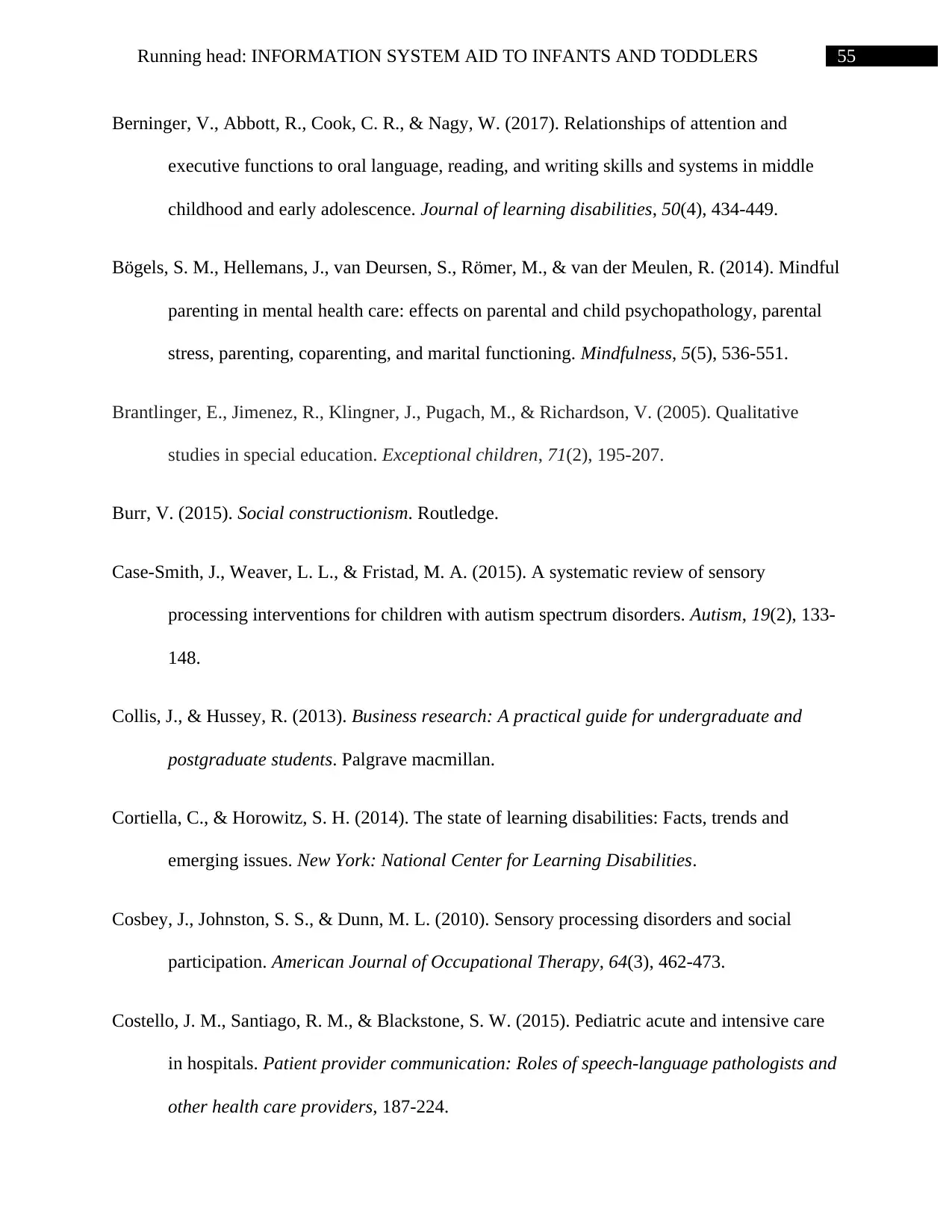
55Running head: INFORMATION SYSTEM AID TO INFANTS AND TODDLERS
Berninger, V., Abbott, R., Cook, C. R., & Nagy, W. (2017). Relationships of attention and
executive functions to oral language, reading, and writing skills and systems in middle
childhood and early adolescence. Journal of learning disabilities, 50(4), 434-449.
Bögels, S. M., Hellemans, J., van Deursen, S., Römer, M., & van der Meulen, R. (2014). Mindful
parenting in mental health care: effects on parental and child psychopathology, parental
stress, parenting, coparenting, and marital functioning. Mindfulness, 5(5), 536-551.
Brantlinger, E., Jimenez, R., Klingner, J., Pugach, M., & Richardson, V. (2005). Qualitative
studies in special education. Exceptional children, 71(2), 195-207.
Burr, V. (2015). Social constructionism. Routledge.
Case-Smith, J., Weaver, L. L., & Fristad, M. A. (2015). A systematic review of sensory
processing interventions for children with autism spectrum disorders. Autism, 19(2), 133-
148.
Collis, J., & Hussey, R. (2013). Business research: A practical guide for undergraduate and
postgraduate students. Palgrave macmillan.
Cortiella, C., & Horowitz, S. H. (2014). The state of learning disabilities: Facts, trends and
emerging issues. New York: National Center for Learning Disabilities.
Cosbey, J., Johnston, S. S., & Dunn, M. L. (2010). Sensory processing disorders and social
participation. American Journal of Occupational Therapy, 64(3), 462-473.
Costello, J. M., Santiago, R. M., & Blackstone, S. W. (2015). Pediatric acute and intensive care
in hospitals. Patient provider communication: Roles of speech-language pathologists and
other health care providers, 187-224.
Berninger, V., Abbott, R., Cook, C. R., & Nagy, W. (2017). Relationships of attention and
executive functions to oral language, reading, and writing skills and systems in middle
childhood and early adolescence. Journal of learning disabilities, 50(4), 434-449.
Bögels, S. M., Hellemans, J., van Deursen, S., Römer, M., & van der Meulen, R. (2014). Mindful
parenting in mental health care: effects on parental and child psychopathology, parental
stress, parenting, coparenting, and marital functioning. Mindfulness, 5(5), 536-551.
Brantlinger, E., Jimenez, R., Klingner, J., Pugach, M., & Richardson, V. (2005). Qualitative
studies in special education. Exceptional children, 71(2), 195-207.
Burr, V. (2015). Social constructionism. Routledge.
Case-Smith, J., Weaver, L. L., & Fristad, M. A. (2015). A systematic review of sensory
processing interventions for children with autism spectrum disorders. Autism, 19(2), 133-
148.
Collis, J., & Hussey, R. (2013). Business research: A practical guide for undergraduate and
postgraduate students. Palgrave macmillan.
Cortiella, C., & Horowitz, S. H. (2014). The state of learning disabilities: Facts, trends and
emerging issues. New York: National Center for Learning Disabilities.
Cosbey, J., Johnston, S. S., & Dunn, M. L. (2010). Sensory processing disorders and social
participation. American Journal of Occupational Therapy, 64(3), 462-473.
Costello, J. M., Santiago, R. M., & Blackstone, S. W. (2015). Pediatric acute and intensive care
in hospitals. Patient provider communication: Roles of speech-language pathologists and
other health care providers, 187-224.
Paraphrase This Document
Need a fresh take? Get an instant paraphrase of this document with our AI Paraphraser
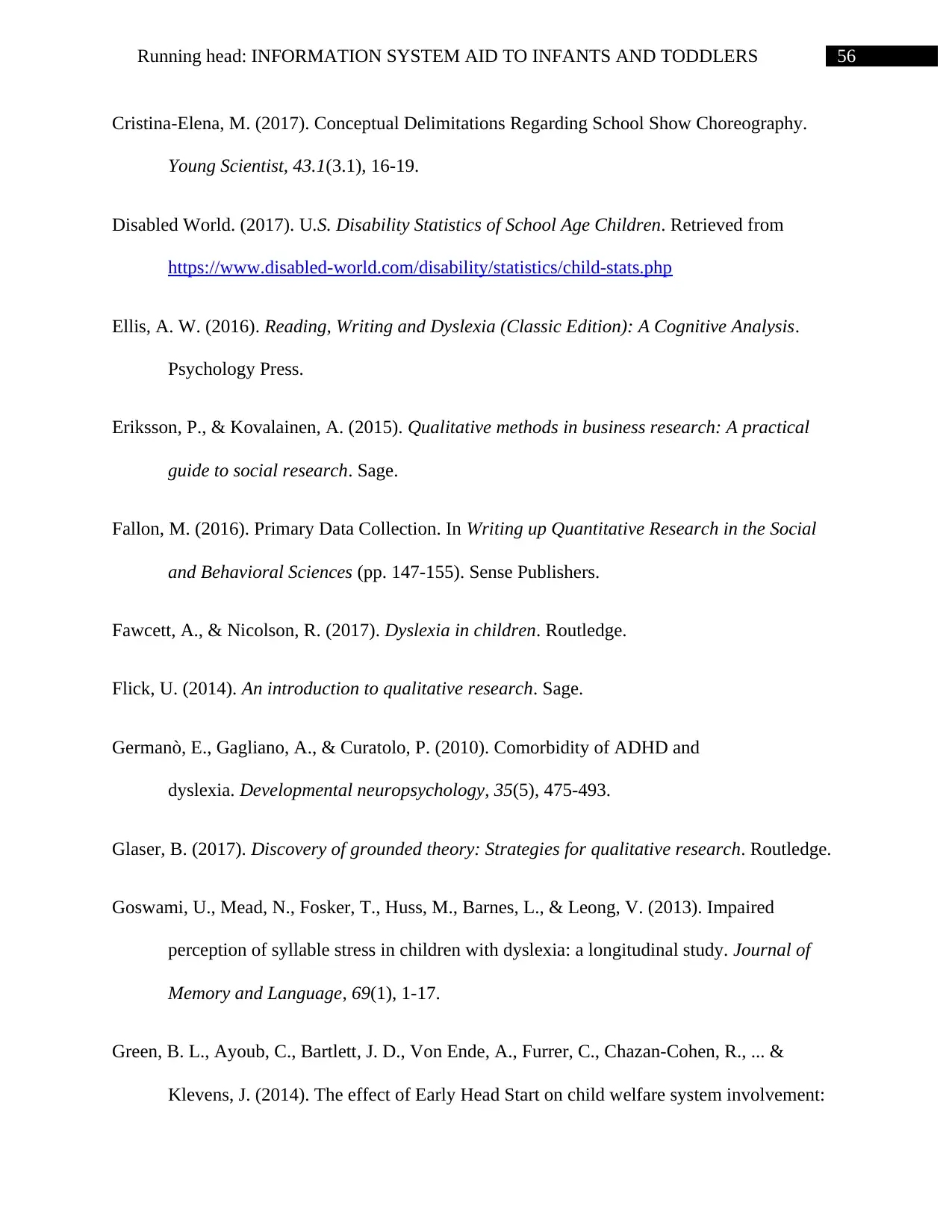
56Running head: INFORMATION SYSTEM AID TO INFANTS AND TODDLERS
Cristina-Elena, M. (2017). Conceptual Delimitations Regarding School Show Choreography.
Young Scientist, 43.1(3.1), 16-19.
Disabled World. (2017). U.S. Disability Statistics of School Age Children. Retrieved from
https://www.disabled-world.com/disability/statistics/child-stats.php
Ellis, A. W. (2016). Reading, Writing and Dyslexia (Classic Edition): A Cognitive Analysis.
Psychology Press.
Eriksson, P., & Kovalainen, A. (2015). Qualitative methods in business research: A practical
guide to social research. Sage.
Fallon, M. (2016). Primary Data Collection. In Writing up Quantitative Research in the Social
and Behavioral Sciences (pp. 147-155). Sense Publishers.
Fawcett, A., & Nicolson, R. (2017). Dyslexia in children. Routledge.
Flick, U. (2014). An introduction to qualitative research. Sage.
Germanò, E., Gagliano, A., & Curatolo, P. (2010). Comorbidity of ADHD and
dyslexia. Developmental neuropsychology, 35(5), 475-493.
Glaser, B. (2017). Discovery of grounded theory: Strategies for qualitative research. Routledge.
Goswami, U., Mead, N., Fosker, T., Huss, M., Barnes, L., & Leong, V. (2013). Impaired
perception of syllable stress in children with dyslexia: a longitudinal study. Journal of
Memory and Language, 69(1), 1-17.
Green, B. L., Ayoub, C., Bartlett, J. D., Von Ende, A., Furrer, C., Chazan-Cohen, R., ... &
Klevens, J. (2014). The effect of Early Head Start on child welfare system involvement:
Cristina-Elena, M. (2017). Conceptual Delimitations Regarding School Show Choreography.
Young Scientist, 43.1(3.1), 16-19.
Disabled World. (2017). U.S. Disability Statistics of School Age Children. Retrieved from
https://www.disabled-world.com/disability/statistics/child-stats.php
Ellis, A. W. (2016). Reading, Writing and Dyslexia (Classic Edition): A Cognitive Analysis.
Psychology Press.
Eriksson, P., & Kovalainen, A. (2015). Qualitative methods in business research: A practical
guide to social research. Sage.
Fallon, M. (2016). Primary Data Collection. In Writing up Quantitative Research in the Social
and Behavioral Sciences (pp. 147-155). Sense Publishers.
Fawcett, A., & Nicolson, R. (2017). Dyslexia in children. Routledge.
Flick, U. (2014). An introduction to qualitative research. Sage.
Germanò, E., Gagliano, A., & Curatolo, P. (2010). Comorbidity of ADHD and
dyslexia. Developmental neuropsychology, 35(5), 475-493.
Glaser, B. (2017). Discovery of grounded theory: Strategies for qualitative research. Routledge.
Goswami, U., Mead, N., Fosker, T., Huss, M., Barnes, L., & Leong, V. (2013). Impaired
perception of syllable stress in children with dyslexia: a longitudinal study. Journal of
Memory and Language, 69(1), 1-17.
Green, B. L., Ayoub, C., Bartlett, J. D., Von Ende, A., Furrer, C., Chazan-Cohen, R., ... &
Klevens, J. (2014). The effect of Early Head Start on child welfare system involvement:

57Running head: INFORMATION SYSTEM AID TO INFANTS AND TODDLERS
A first look at longitudinal child maltreatment outcomes. Children and youth services
review, 42, 127-135.
Grossmann, I. (2017). Wisdom and how to cultivate it: Review of emerging evidence for a
constructivist model of wise thinking.
Haegele, J. A., & Hodge, S. (2016). Disability discourse: Overview and critiques of the medical
and social models. Quest, 68(2), 193-206.
Helland, T., Tjus, T., Hovden, M., Ofte, S., & Heimann, M. (2011). Effects of bottom-up and
top-down intervention principles in emergent literacy in children at risk of developmental
dyslexia: A longitudinal study. Journal of Learning Disabilities, 44(2), 105-122.
Hockenberry, M. J., & Wilson, D. (2014). Wong's Nursing Care of Infants and Children-E-Book.
Elsevier Health Sciences.
Ismail, R., & Jaafar, A. (2011, November). Interactive screen-based design for dyslexic children.
In User Science and Engineering (i-USEr), 2011 International Conference on (pp. 168-
171). IEEE.
Kagohara, D. M., van der Meer, L., Ramdoss, S., O’Reilly, M. F., Lancioni, G. E., Davis, T.
N., ... & Green, V. A. (2013). Using iPods® and iPads® in teaching programs for
individuals with developmental disabilities: A systematic review. Research in
developmental disabilities, 34(1), 147-156.
Kirk, S., Gallagher, J. J., Coleman, M. R., & Anastasiow, N. J. (2011). Educating exceptional
children. Cengage Learning.
A first look at longitudinal child maltreatment outcomes. Children and youth services
review, 42, 127-135.
Grossmann, I. (2017). Wisdom and how to cultivate it: Review of emerging evidence for a
constructivist model of wise thinking.
Haegele, J. A., & Hodge, S. (2016). Disability discourse: Overview and critiques of the medical
and social models. Quest, 68(2), 193-206.
Helland, T., Tjus, T., Hovden, M., Ofte, S., & Heimann, M. (2011). Effects of bottom-up and
top-down intervention principles in emergent literacy in children at risk of developmental
dyslexia: A longitudinal study. Journal of Learning Disabilities, 44(2), 105-122.
Hockenberry, M. J., & Wilson, D. (2014). Wong's Nursing Care of Infants and Children-E-Book.
Elsevier Health Sciences.
Ismail, R., & Jaafar, A. (2011, November). Interactive screen-based design for dyslexic children.
In User Science and Engineering (i-USEr), 2011 International Conference on (pp. 168-
171). IEEE.
Kagohara, D. M., van der Meer, L., Ramdoss, S., O’Reilly, M. F., Lancioni, G. E., Davis, T.
N., ... & Green, V. A. (2013). Using iPods® and iPads® in teaching programs for
individuals with developmental disabilities: A systematic review. Research in
developmental disabilities, 34(1), 147-156.
Kirk, S., Gallagher, J. J., Coleman, M. R., & Anastasiow, N. J. (2011). Educating exceptional
children. Cengage Learning.
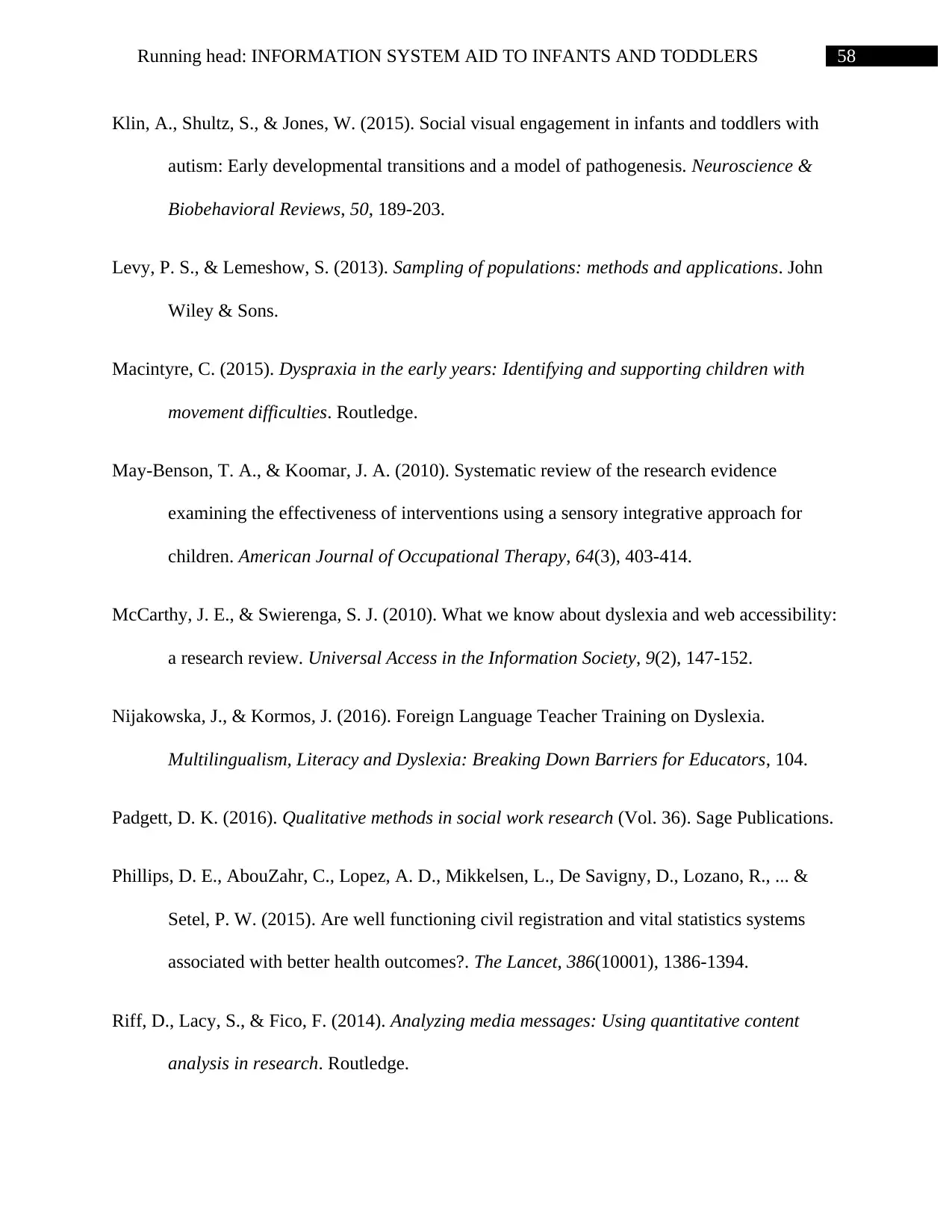
58Running head: INFORMATION SYSTEM AID TO INFANTS AND TODDLERS
Klin, A., Shultz, S., & Jones, W. (2015). Social visual engagement in infants and toddlers with
autism: Early developmental transitions and a model of pathogenesis. Neuroscience &
Biobehavioral Reviews, 50, 189-203.
Levy, P. S., & Lemeshow, S. (2013). Sampling of populations: methods and applications. John
Wiley & Sons.
Macintyre, C. (2015). Dyspraxia in the early years: Identifying and supporting children with
movement difficulties. Routledge.
May-Benson, T. A., & Koomar, J. A. (2010). Systematic review of the research evidence
examining the effectiveness of interventions using a sensory integrative approach for
children. American Journal of Occupational Therapy, 64(3), 403-414.
McCarthy, J. E., & Swierenga, S. J. (2010). What we know about dyslexia and web accessibility:
a research review. Universal Access in the Information Society, 9(2), 147-152.
Nijakowska, J., & Kormos, J. (2016). Foreign Language Teacher Training on Dyslexia.
Multilingualism, Literacy and Dyslexia: Breaking Down Barriers for Educators, 104.
Padgett, D. K. (2016). Qualitative methods in social work research (Vol. 36). Sage Publications.
Phillips, D. E., AbouZahr, C., Lopez, A. D., Mikkelsen, L., De Savigny, D., Lozano, R., ... &
Setel, P. W. (2015). Are well functioning civil registration and vital statistics systems
associated with better health outcomes?. The Lancet, 386(10001), 1386-1394.
Riff, D., Lacy, S., & Fico, F. (2014). Analyzing media messages: Using quantitative content
analysis in research. Routledge.
Klin, A., Shultz, S., & Jones, W. (2015). Social visual engagement in infants and toddlers with
autism: Early developmental transitions and a model of pathogenesis. Neuroscience &
Biobehavioral Reviews, 50, 189-203.
Levy, P. S., & Lemeshow, S. (2013). Sampling of populations: methods and applications. John
Wiley & Sons.
Macintyre, C. (2015). Dyspraxia in the early years: Identifying and supporting children with
movement difficulties. Routledge.
May-Benson, T. A., & Koomar, J. A. (2010). Systematic review of the research evidence
examining the effectiveness of interventions using a sensory integrative approach for
children. American Journal of Occupational Therapy, 64(3), 403-414.
McCarthy, J. E., & Swierenga, S. J. (2010). What we know about dyslexia and web accessibility:
a research review. Universal Access in the Information Society, 9(2), 147-152.
Nijakowska, J., & Kormos, J. (2016). Foreign Language Teacher Training on Dyslexia.
Multilingualism, Literacy and Dyslexia: Breaking Down Barriers for Educators, 104.
Padgett, D. K. (2016). Qualitative methods in social work research (Vol. 36). Sage Publications.
Phillips, D. E., AbouZahr, C., Lopez, A. D., Mikkelsen, L., De Savigny, D., Lozano, R., ... &
Setel, P. W. (2015). Are well functioning civil registration and vital statistics systems
associated with better health outcomes?. The Lancet, 386(10001), 1386-1394.
Riff, D., Lacy, S., & Fico, F. (2014). Analyzing media messages: Using quantitative content
analysis in research. Routledge.
Secure Best Marks with AI Grader
Need help grading? Try our AI Grader for instant feedback on your assignments.
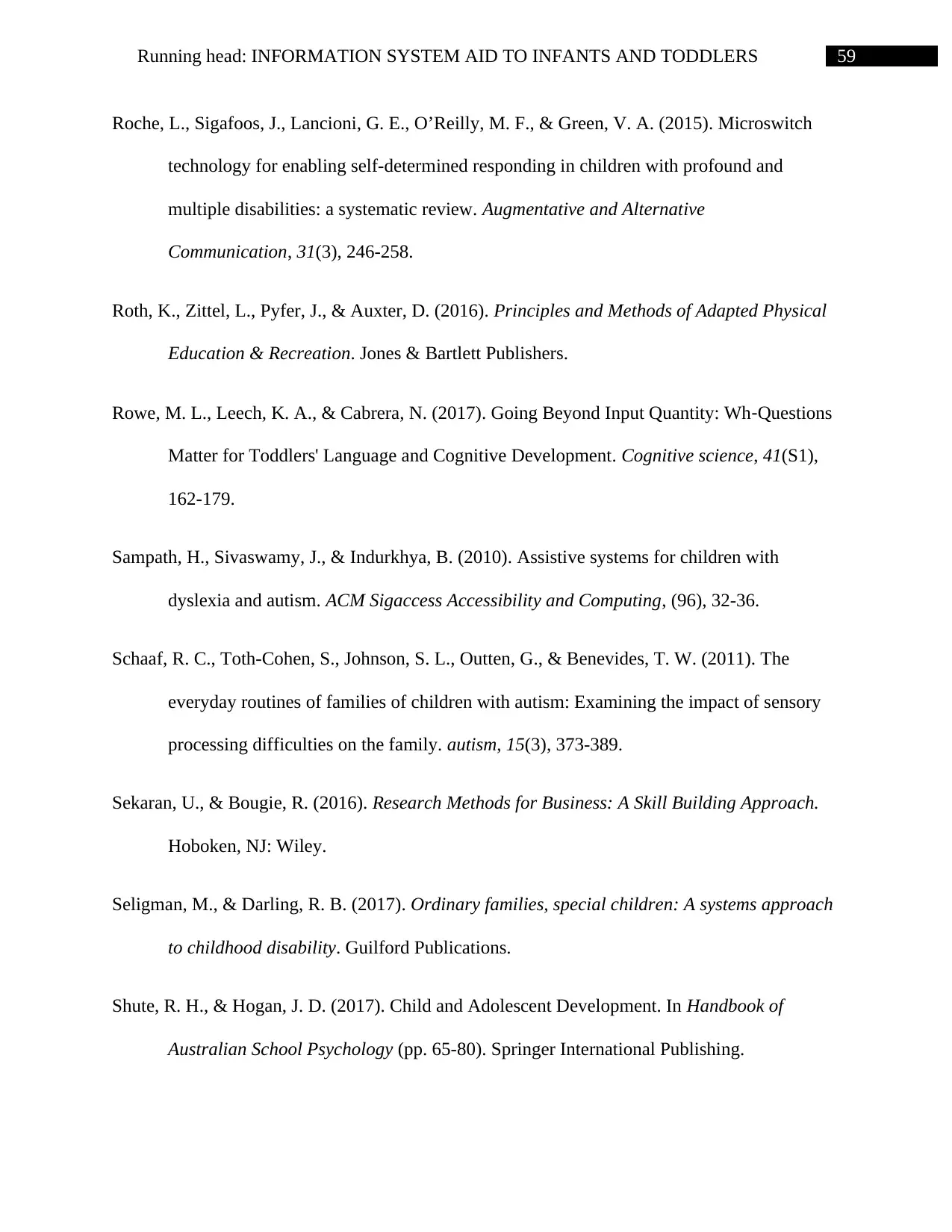
59Running head: INFORMATION SYSTEM AID TO INFANTS AND TODDLERS
Roche, L., Sigafoos, J., Lancioni, G. E., O’Reilly, M. F., & Green, V. A. (2015). Microswitch
technology for enabling self-determined responding in children with profound and
multiple disabilities: a systematic review. Augmentative and Alternative
Communication, 31(3), 246-258.
Roth, K., Zittel, L., Pyfer, J., & Auxter, D. (2016). Principles and Methods of Adapted Physical
Education & Recreation. Jones & Bartlett Publishers.
Rowe, M. L., Leech, K. A., & Cabrera, N. (2017). Going Beyond Input Quantity: Wh‐Questions
Matter for Toddlers' Language and Cognitive Development. Cognitive science, 41(S1),
162-179.
Sampath, H., Sivaswamy, J., & Indurkhya, B. (2010). Assistive systems for children with
dyslexia and autism. ACM Sigaccess Accessibility and Computing, (96), 32-36.
Schaaf, R. C., Toth-Cohen, S., Johnson, S. L., Outten, G., & Benevides, T. W. (2011). The
everyday routines of families of children with autism: Examining the impact of sensory
processing difficulties on the family. autism, 15(3), 373-389.
Sekaran, U., & Bougie, R. (2016). Research Methods for Business: A Skill Building Approach.
Hoboken, NJ: Wiley.
Seligman, M., & Darling, R. B. (2017). Ordinary families, special children: A systems approach
to childhood disability. Guilford Publications.
Shute, R. H., & Hogan, J. D. (2017). Child and Adolescent Development. In Handbook of
Australian School Psychology (pp. 65-80). Springer International Publishing.
Roche, L., Sigafoos, J., Lancioni, G. E., O’Reilly, M. F., & Green, V. A. (2015). Microswitch
technology for enabling self-determined responding in children with profound and
multiple disabilities: a systematic review. Augmentative and Alternative
Communication, 31(3), 246-258.
Roth, K., Zittel, L., Pyfer, J., & Auxter, D. (2016). Principles and Methods of Adapted Physical
Education & Recreation. Jones & Bartlett Publishers.
Rowe, M. L., Leech, K. A., & Cabrera, N. (2017). Going Beyond Input Quantity: Wh‐Questions
Matter for Toddlers' Language and Cognitive Development. Cognitive science, 41(S1),
162-179.
Sampath, H., Sivaswamy, J., & Indurkhya, B. (2010). Assistive systems for children with
dyslexia and autism. ACM Sigaccess Accessibility and Computing, (96), 32-36.
Schaaf, R. C., Toth-Cohen, S., Johnson, S. L., Outten, G., & Benevides, T. W. (2011). The
everyday routines of families of children with autism: Examining the impact of sensory
processing difficulties on the family. autism, 15(3), 373-389.
Sekaran, U., & Bougie, R. (2016). Research Methods for Business: A Skill Building Approach.
Hoboken, NJ: Wiley.
Seligman, M., & Darling, R. B. (2017). Ordinary families, special children: A systems approach
to childhood disability. Guilford Publications.
Shute, R. H., & Hogan, J. D. (2017). Child and Adolescent Development. In Handbook of
Australian School Psychology (pp. 65-80). Springer International Publishing.
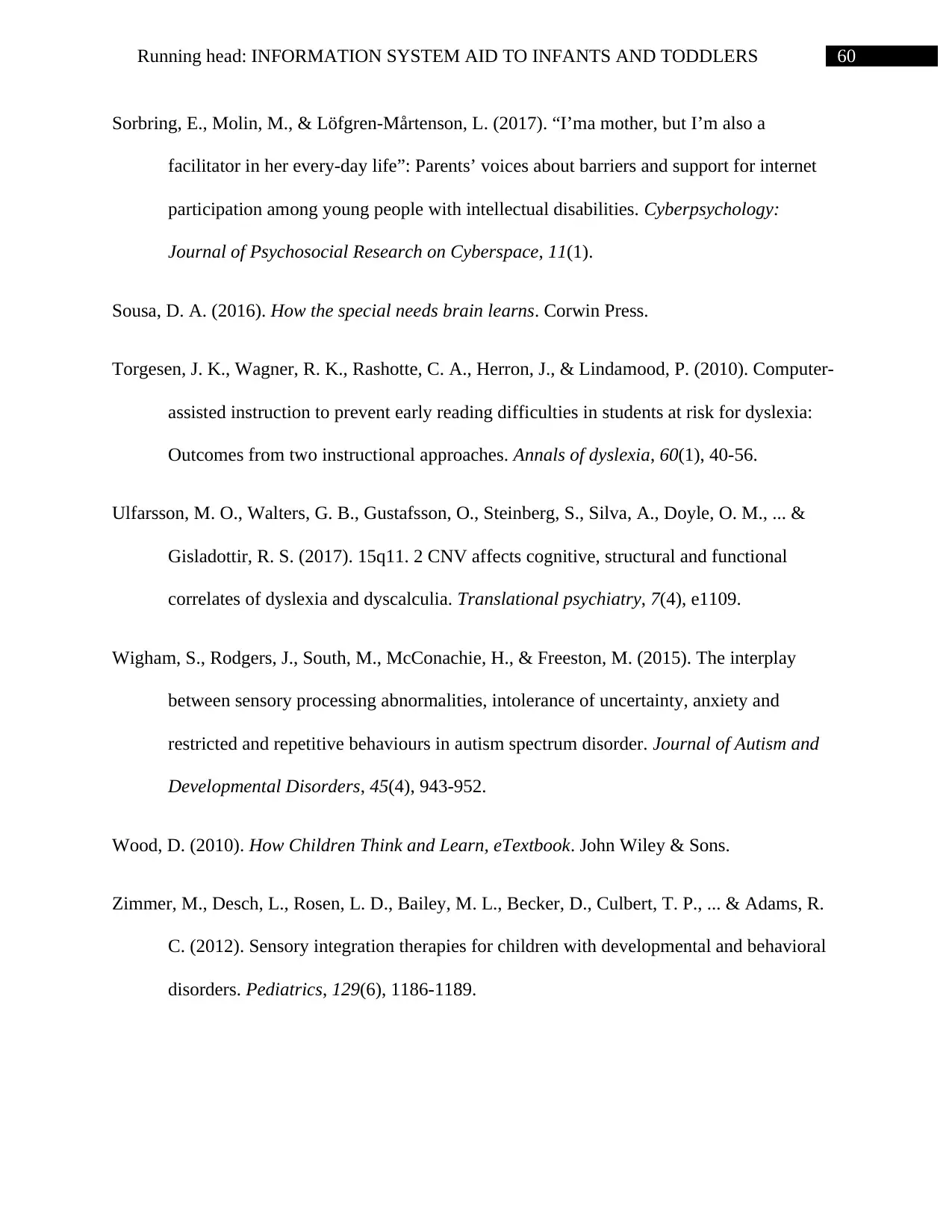
60Running head: INFORMATION SYSTEM AID TO INFANTS AND TODDLERS
Sorbring, E., Molin, M., & Löfgren-Mårtenson, L. (2017). “I’ma mother, but I’m also a
facilitator in her every-day life”: Parents’ voices about barriers and support for internet
participation among young people with intellectual disabilities. Cyberpsychology:
Journal of Psychosocial Research on Cyberspace, 11(1).
Sousa, D. A. (2016). How the special needs brain learns. Corwin Press.
Torgesen, J. K., Wagner, R. K., Rashotte, C. A., Herron, J., & Lindamood, P. (2010). Computer-
assisted instruction to prevent early reading difficulties in students at risk for dyslexia:
Outcomes from two instructional approaches. Annals of dyslexia, 60(1), 40-56.
Ulfarsson, M. O., Walters, G. B., Gustafsson, O., Steinberg, S., Silva, A., Doyle, O. M., ... &
Gisladottir, R. S. (2017). 15q11. 2 CNV affects cognitive, structural and functional
correlates of dyslexia and dyscalculia. Translational psychiatry, 7(4), e1109.
Wigham, S., Rodgers, J., South, M., McConachie, H., & Freeston, M. (2015). The interplay
between sensory processing abnormalities, intolerance of uncertainty, anxiety and
restricted and repetitive behaviours in autism spectrum disorder. Journal of Autism and
Developmental Disorders, 45(4), 943-952.
Wood, D. (2010). How Children Think and Learn, eTextbook. John Wiley & Sons.
Zimmer, M., Desch, L., Rosen, L. D., Bailey, M. L., Becker, D., Culbert, T. P., ... & Adams, R.
C. (2012). Sensory integration therapies for children with developmental and behavioral
disorders. Pediatrics, 129(6), 1186-1189.
Sorbring, E., Molin, M., & Löfgren-Mårtenson, L. (2017). “I’ma mother, but I’m also a
facilitator in her every-day life”: Parents’ voices about barriers and support for internet
participation among young people with intellectual disabilities. Cyberpsychology:
Journal of Psychosocial Research on Cyberspace, 11(1).
Sousa, D. A. (2016). How the special needs brain learns. Corwin Press.
Torgesen, J. K., Wagner, R. K., Rashotte, C. A., Herron, J., & Lindamood, P. (2010). Computer-
assisted instruction to prevent early reading difficulties in students at risk for dyslexia:
Outcomes from two instructional approaches. Annals of dyslexia, 60(1), 40-56.
Ulfarsson, M. O., Walters, G. B., Gustafsson, O., Steinberg, S., Silva, A., Doyle, O. M., ... &
Gisladottir, R. S. (2017). 15q11. 2 CNV affects cognitive, structural and functional
correlates of dyslexia and dyscalculia. Translational psychiatry, 7(4), e1109.
Wigham, S., Rodgers, J., South, M., McConachie, H., & Freeston, M. (2015). The interplay
between sensory processing abnormalities, intolerance of uncertainty, anxiety and
restricted and repetitive behaviours in autism spectrum disorder. Journal of Autism and
Developmental Disorders, 45(4), 943-952.
Wood, D. (2010). How Children Think and Learn, eTextbook. John Wiley & Sons.
Zimmer, M., Desch, L., Rosen, L. D., Bailey, M. L., Becker, D., Culbert, T. P., ... & Adams, R.
C. (2012). Sensory integration therapies for children with developmental and behavioral
disorders. Pediatrics, 129(6), 1186-1189.

61Running head: INFORMATION SYSTEM AID TO INFANTS AND TODDLERS
1 out of 61
Related Documents
Your All-in-One AI-Powered Toolkit for Academic Success.
+13062052269
info@desklib.com
Available 24*7 on WhatsApp / Email
![[object Object]](/_next/static/media/star-bottom.7253800d.svg)
Unlock your academic potential
© 2024 | Zucol Services PVT LTD | All rights reserved.





